Danceland and Big Reggie
Tonka Bay, Excelsior
NOTES:
- This page does not include other ballrooms (“pavilions” or “casinos”) on the Excelsior waterfront at the turn of the last century; that information is on a separate page about Excelsior’s Dance Halls.
- Many thanks to Lisa Stevens, Scott McGinnis, and the folks at the Excelsior-Lake Minnetonka Historical Society for access to their files and for reviewing this material for clarity and accuracy.
- Unless otherwise cited, the indented quotations are from the Minnetonka Record newspaper.
- The name “Danceland” did not come into being until 1961. The building had several other names before that. I tend to use the word “Ballroom” to mean the building that became Danceland.
- Some of the events below took place in Excelsior Amusement Park’s picnic pavilion. Those are noted as accurately as possible and are included here if music or other popular entertainment is involved.
TONKA BAY
The building that eventually became Danceland started out in a different location entirely. It was built across the bay from Excelsior in the resort town of Tonka Bay.
BEACH PAVILION
Beach Pavilion was built for $10,000 by Everel O. Beach in 1904. Beach originally wanted to build it on the Excelsior Commons, which was public property in Excelsior owned by the Park Board. Although the Village Council approved a lease, saying it would enhance the otherwise unsightly area, Beach withdrew his proposal for fear of opposition from residents. Instead he built it on the grounds of the Tonka Bay Hotel (originally called the Lake Park Hotel), which had been purchased by Thomas Lowry in 1902.
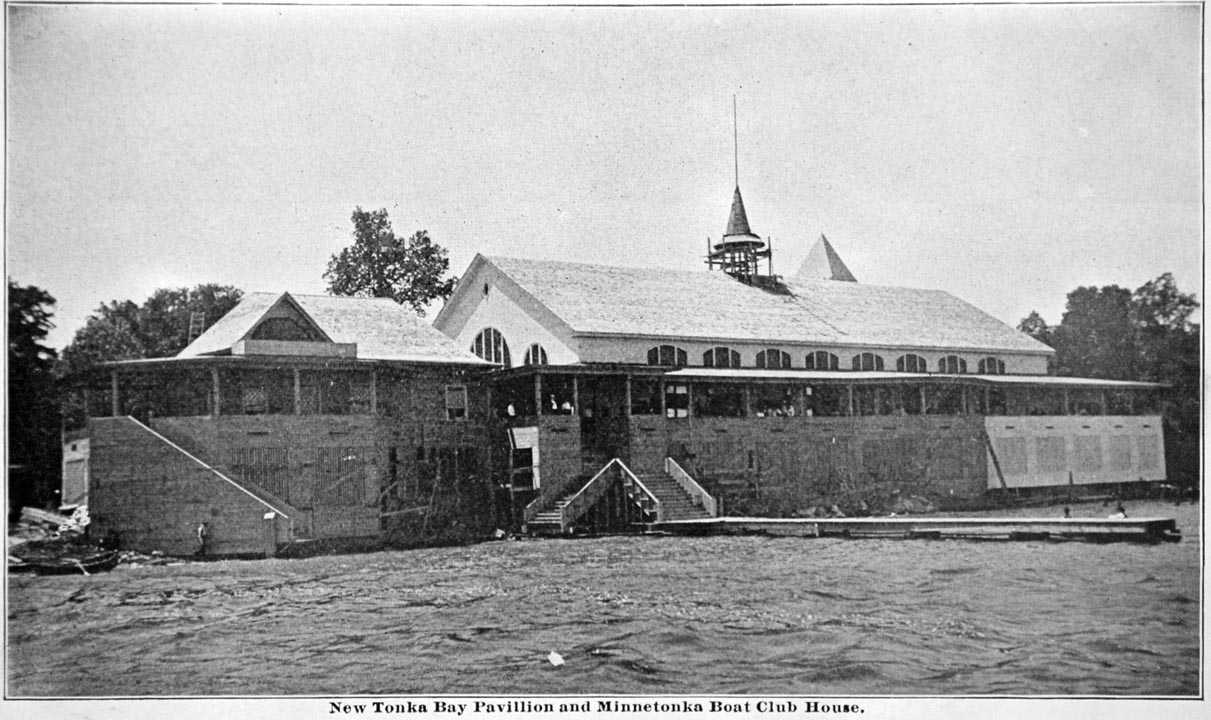
The Beach Pavilion’s Grand Opening was on June 11, 1904. Interesting that the word “hop,” so associated with the 1950s, was used 50 years before.
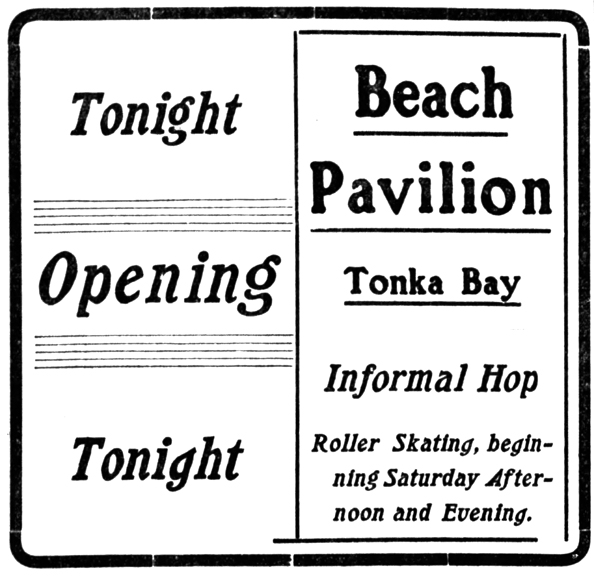
The following article from the Minneapolis Journal is long, but gives a splendid description of the building when it was first put into service.
FIRST “HOP” TO-NIGHT:
Big Beach Pavilion Will Be Formally Opened at Tonka Bay To-night.
The formal opening of the Beach Pavilion, at Tonka Bay, will take place this evening. The new pavilion is one of the finest in the country in every respect, and will undoubtedly be a most popular resort for the people of Minneapolis and St. Paul during the hot weather. It has an ideal location on Tonka Bay and is splendidly fitted throughout.
The building itself, including the Tonka Boat Club House, which is connected with the pavilion by a porch, includes an area of 275×100 ft. The ball-room is the largest in the Northwest, and has an area of 150×75 ft. Informal hops will take place here every Wednesday and Saturday evening, and there will be roller-skating every afternoon and evening except on the “hop” nights.
There is a splendid billiard-room in connection with the pavilion and a view of the ball-room and the lake can be obtained from the billiard-room. There are 200 feet of porches facing the lake. During the coming week all this porch area will be screened in and will be safe from the attack of mosquitos and other insects.
The electric light system for the pavilion is perfect and there are oriental and different colored lights throughout the whole building. The Tonka Bay hotel, which is owned and managed under the direction of Thomas Lowry, is in close proximity. Light lunches and other refreshments can be obtained any time at the pavilion.
The Beach Pavilion is to be conducted by up-to-date methods and is bound to be very popular with lovers of Tonka.
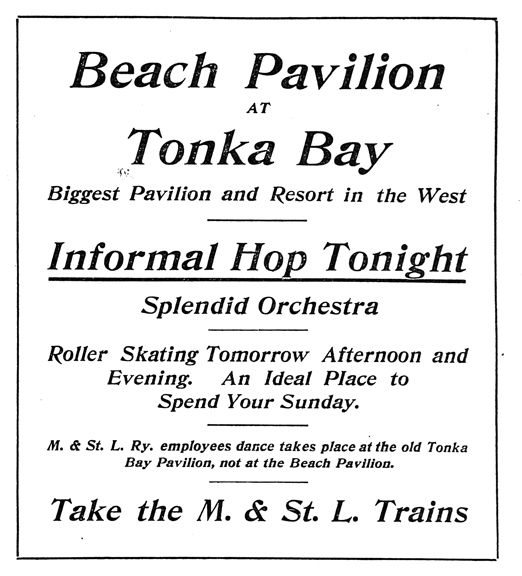
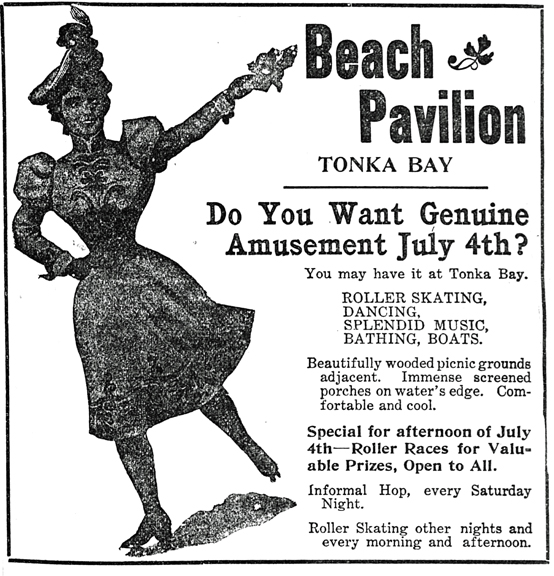
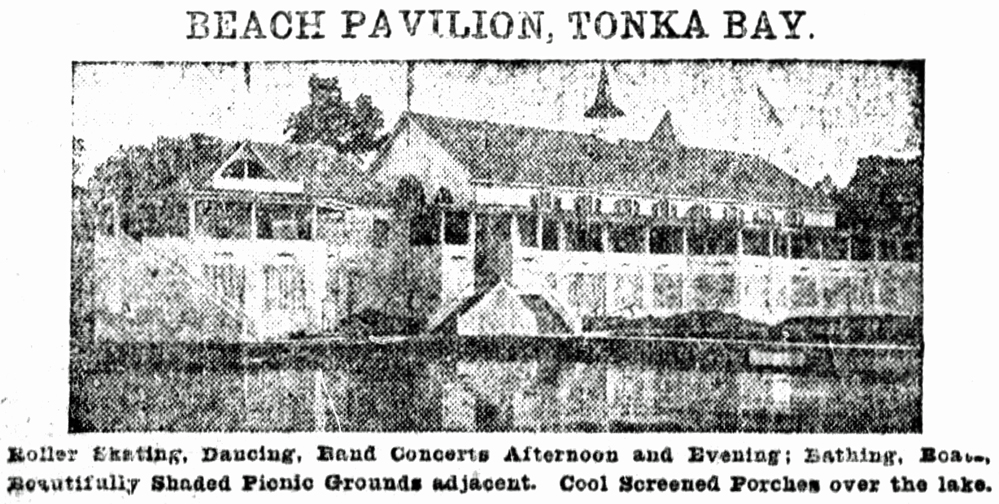
TONKA BAY PAVILION
Beach had borrowed the construction funds from Thomas Lowry, who was then stuck with the debt when Beach fled Minnesota in the Fall of 1904 as he was about to be indicted for embezzling funds from the Minnesota Transfer Railway Company. In 1930, Beach was a resident of the Illinois State Penitentiary at Joliet. Even that didn’t cure him of his swindling ways; in 1940 he was a guest of the Los Angeles County jail.
Lowry took control of the building in 1905; an article dated June 6, 1905, reported:
Lowry Now Owns Tonka Pavilion – Acquires More Property at Tonka Bay and Gives Long Lease.
Thomas Lowry has acquired full possession of the Beach pavilion at Tonka Bay, adjacent to his hotel, the Tonka Bay. He has given a three-year lease to Edward Shumpik and John G. Lund, who will operate the roller skating rink and other accessories of the establishment. The same interests control the Casino rink on Washington avenue N.
The Minnetonka Boat club will continue to occupy its quarters in the pavilion building. The structure cost $18,000. The site was already owned by Mr. Lowry.
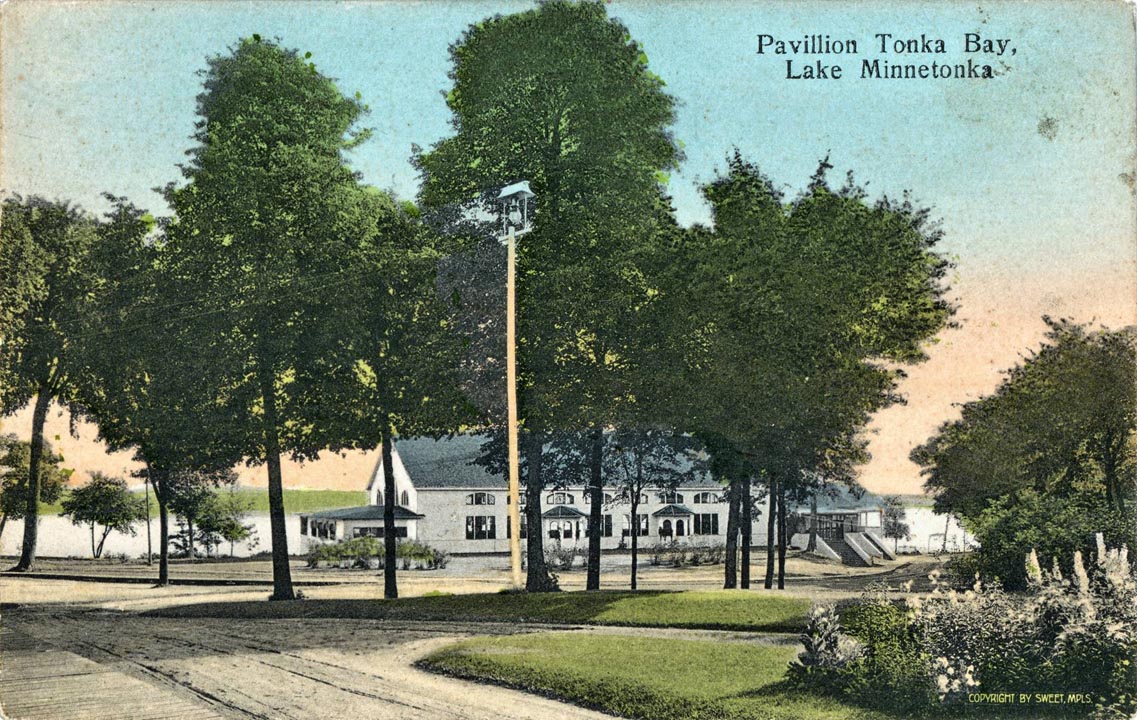
The name of the place changed with the tides:
- Tonka Bay Pavilion
- Tonka Bay Roller Skating Rink
- Tonka Bay Roller Skating Casino
- Tonka Bay Casino
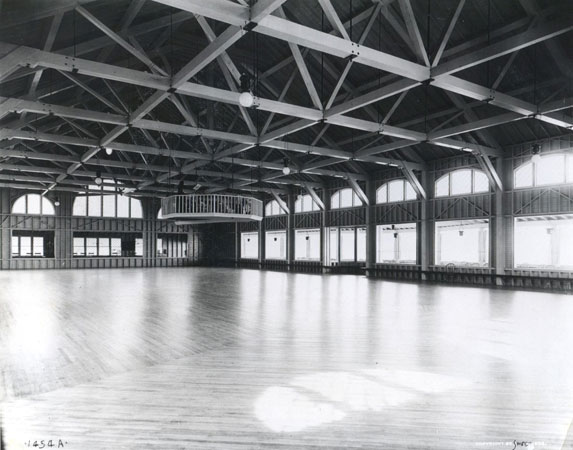
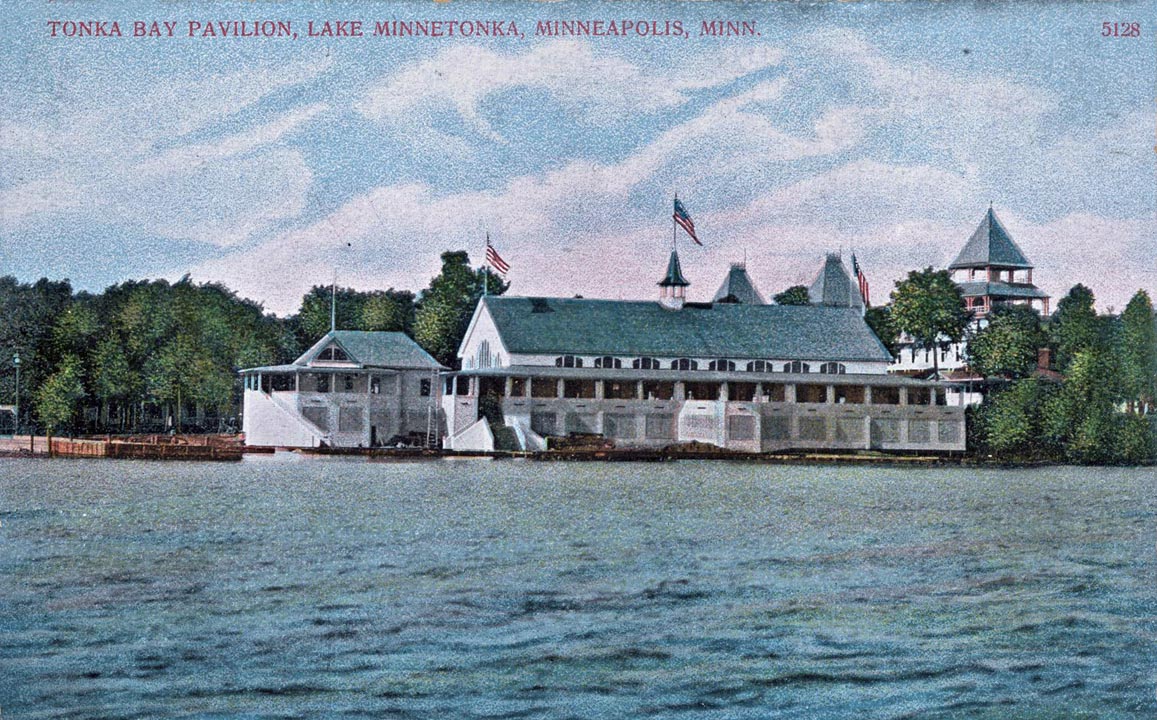

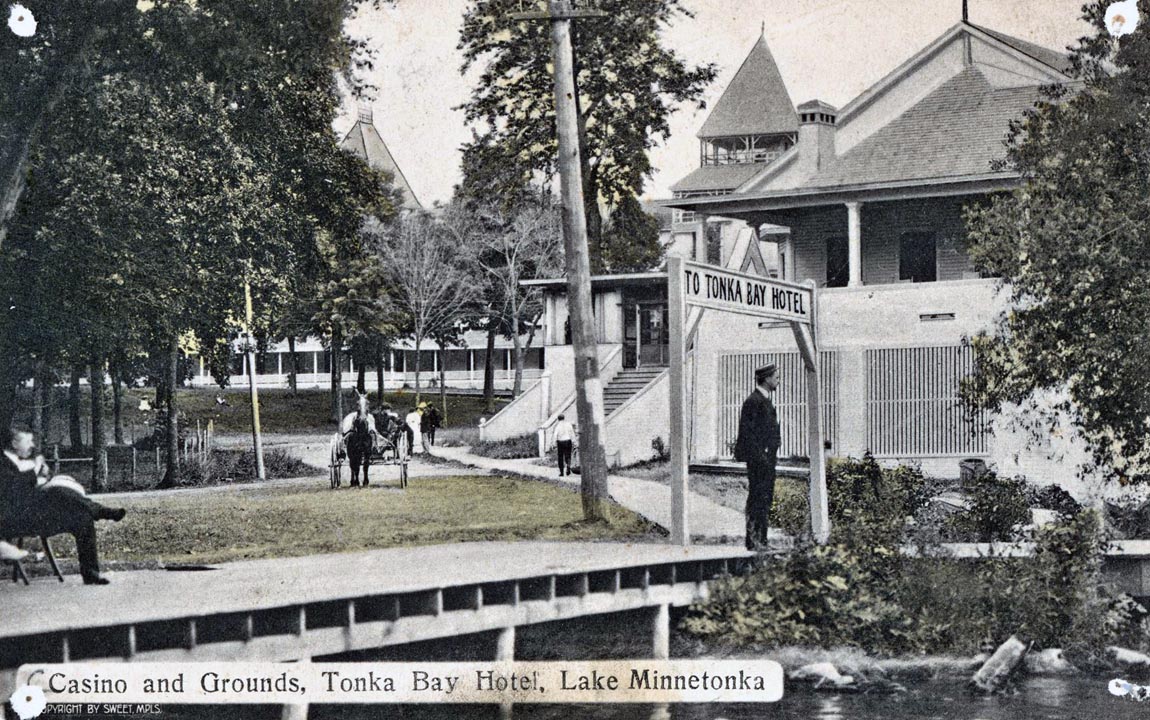
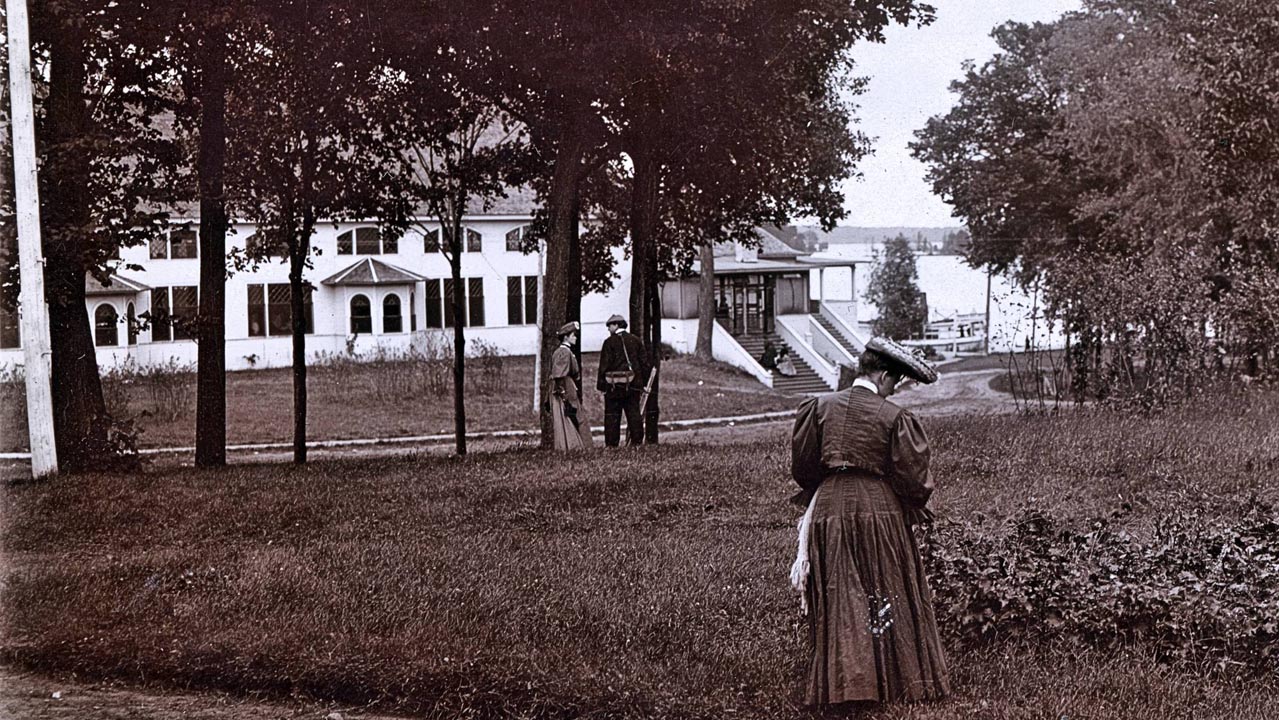
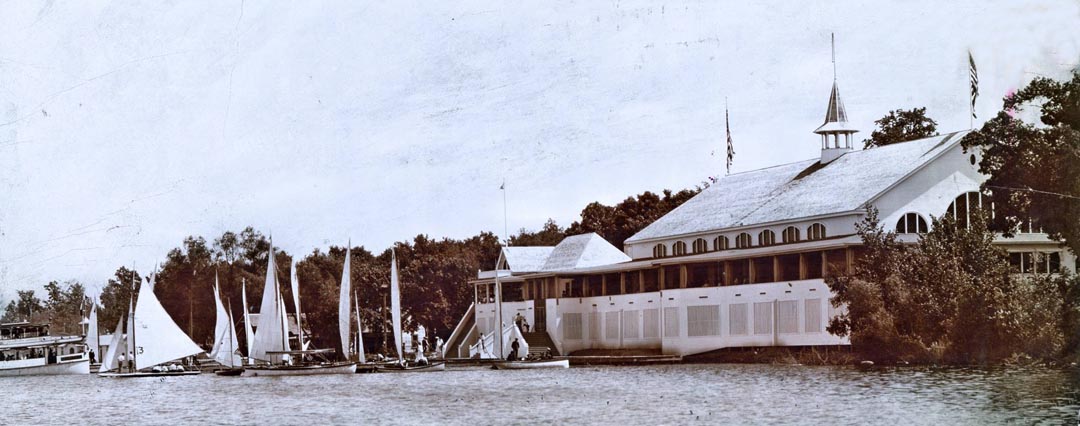
1920
On January 23, 1920, Horace Lowry, president of the Twin City Lines (streetcar), offered the Tonka Bay roller skating pavilion as a gift to the Excelsior park board for use on the Excelsior Commons. Bonds would have to be voted on to raise funds to move the building from Tonka Bay to Excelsior. “It would serve as a center for housing summer concerts and entertainments and would afford shelter to picnic crowds in case of sudden storm.”
1922
On October 13, 1922: It was reported that Eber Armagost and J.E. McNiece of Excelsior had purchased the Tonka Bay casino and were having it razed. “The lumber will be used to build a new casino at the street railway dock station in Excelsior. It will be 100×150 feet and will be completed by spring. J.E. Weinholz has the contract.” Armagost worked for the trolley company.
In the winter of 1922/1923, instead of being razed, this building was dismantled, the porch was removed, and the structure was moved across the bay. It opened in its new location on May 5, 1923. The floor, again used for roller skating and dancing, measured 75 x 150.
Legend has it that the building was towed across the frozen Lake Minnetonka from Tonka Bay to Excelsior. It seems that if that had happened it would have certainly been sensational enough to be in the newspaper, but I found no such report, either in the Minnetonka Record or in the Minneapolis papers. Further confusing the matter is an article from July 1953:
Joe Weinholz, the Excelsior contractor, told the story of how he and his crew moved the 66×140-foot structure from Tonka Bay:
First they took apart the roof boards and took down the trusses. Then off came the porches. The walls were sawed into 14×22-foot sections and carried down to the shore and slid over the bank on to a barge. From there, they were carried across the lake to the shore of what is now the Amusement Park and then rolled across the road to the present site of the ballroom. The timbers and underwork of the building, and the floor sheeting were all loaded on trucks and brought over to Excelsior.
Does the word “barge” imply open water?
It appears that the Tonka Bay Hotel was also removed. An ad dated April 22, 1923, reads:
A Rare Minnetonka Opportunity
One of the most pleasing tracts of land around Lake Minnetonka; one of the last, if not the very last of the really desirable unoccupied tracts on the lower lake, the beautiful spot where Tonka Bay Hotel and pavilion once stood [emphasis added] is to be platted and sold as lots.
Before the plat is completed we will consider proposals from those who desire sufficient ground to build larger homes. But this requires immediate action.
The restrictions upon this property assure a community of the most desirable sort. The facilities and services of all kinds, including year-round transportation cannot be surpassed at any location at the Lake.
The plans under way will make this one of the most sightly and attractive communities around the lake. Because of the extreme desirability of this location; the unusual beauty of this highly wooded tract; and the scarcity of rally good Lake sites we are able to select the purchasers with care to insure a thoroughly high class community.
It will pay you to be forehanded. Write or phone at once.
Northwestern Suburban Realty Co., 1211 McKnight Bldg. NOTE: This is a newly formed corporation, most of whose members already own and occupy homes at Tonka Bay.
EXCELSIOR
1923
LAKE VIEW PARK PAVILION
On April 22, 1923, the Minneapolis Journal reported on the Pavilion then under construction in Excelsior.
It is located near the street railway station, and will be opened early in May. J.E. McNiece, who operated the old pavilion, is the owner. D.C. Bennett, Inc. are the architects and builders. Of frame construction with stucco exterior, the building is 50 feet wide and 150 feet long. This area does not include the spacious porches running across the front and the entire length of one side of the building. The structure will cost $30,000.
Minnetonka Record, May 4, 1923:
Lake View Park Pavilion, the new casino near the dock station in Excelsior, will open Saturday [May 5] evening with a ball. The pavilion is the former roller skating rink that stood on the lake front at Tonka Bay. It was purchased last fall by E. Armsogost and J.E. McNiece, taken down in sections and re-constructed in Excelsior.
The pavilion occupies a strategic position here. It is on the Yellowstone Trail [Excelsior Blvd.], at the dock station, where all trolley cars stop before entering the heart of town and near the shore of Excelsior Bay, which has been dredged out and will be provided with piers for the landing of boats. The dancing floor is 75×150 feet, said to be the largest public dancing floor in the northwest. It will accommodate 2000 persons without crowding.
The pavilion will be operated on a strictly high class basis. Special precautions will be taken against liquor and improprieties. The grounds will be brilliantly lighted. There will be a double row of ornamental lights from the dock station to the entrance of the pavilion. Byron D. Wilson will be in charge of policing the building and grounds, with assistants on duty at all hours. Mr. McNiece will be actual manager of the pavilion and will have dance floor managers to see that nothing improper is permitted.
There is room for parking 500 automobiles on the grounds. Watchmen will be on duty to protect patrons’ cars.
It is the plan of the proprietors to erect additional buildings at the end of the season. There will be buildings devoted to various forms amusements added, until an amusement park of large proportions is assembled.
Lake View Park dancing pavilion had its Grand Opening on Friday, May 25, 1923, with souvenirs and novelties for all. There was dancing every Wednesday and Saturday; Gents got in for 55 cents, Ladies for 30 cents. Music was provided by the Clarence Peterson Lake View Park Orchestra.
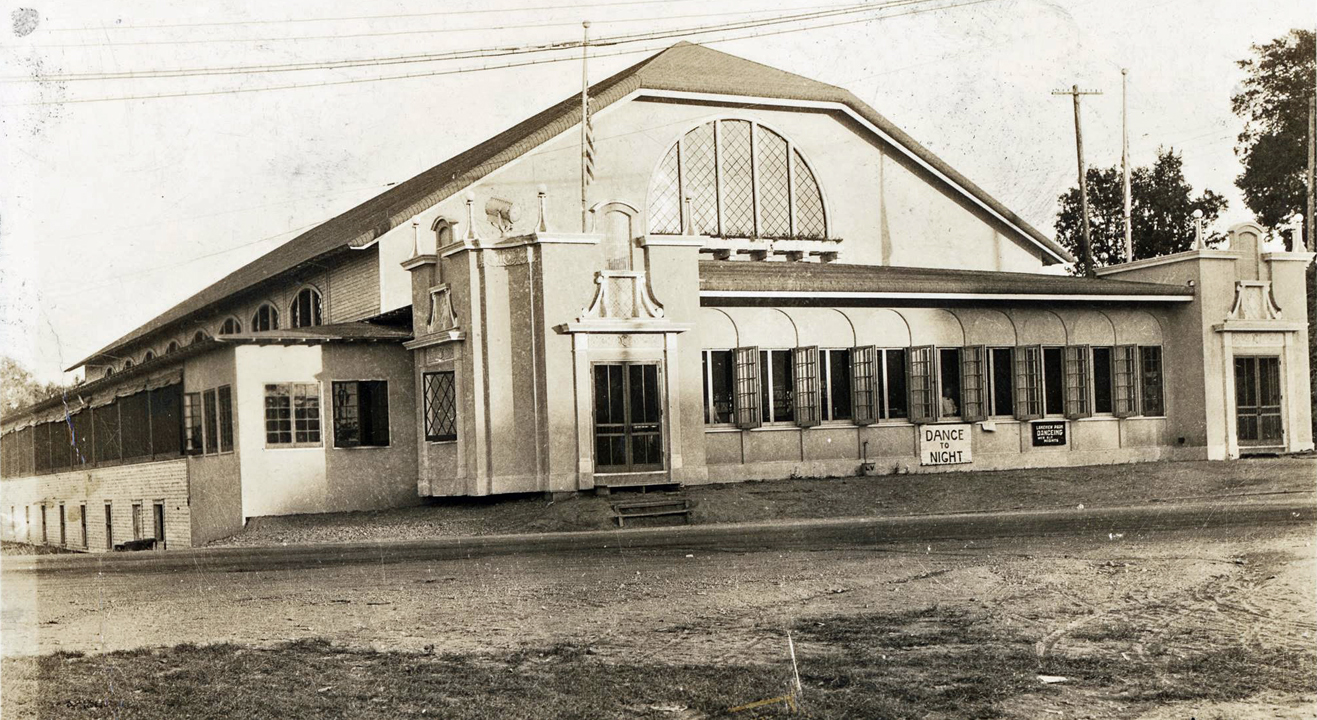
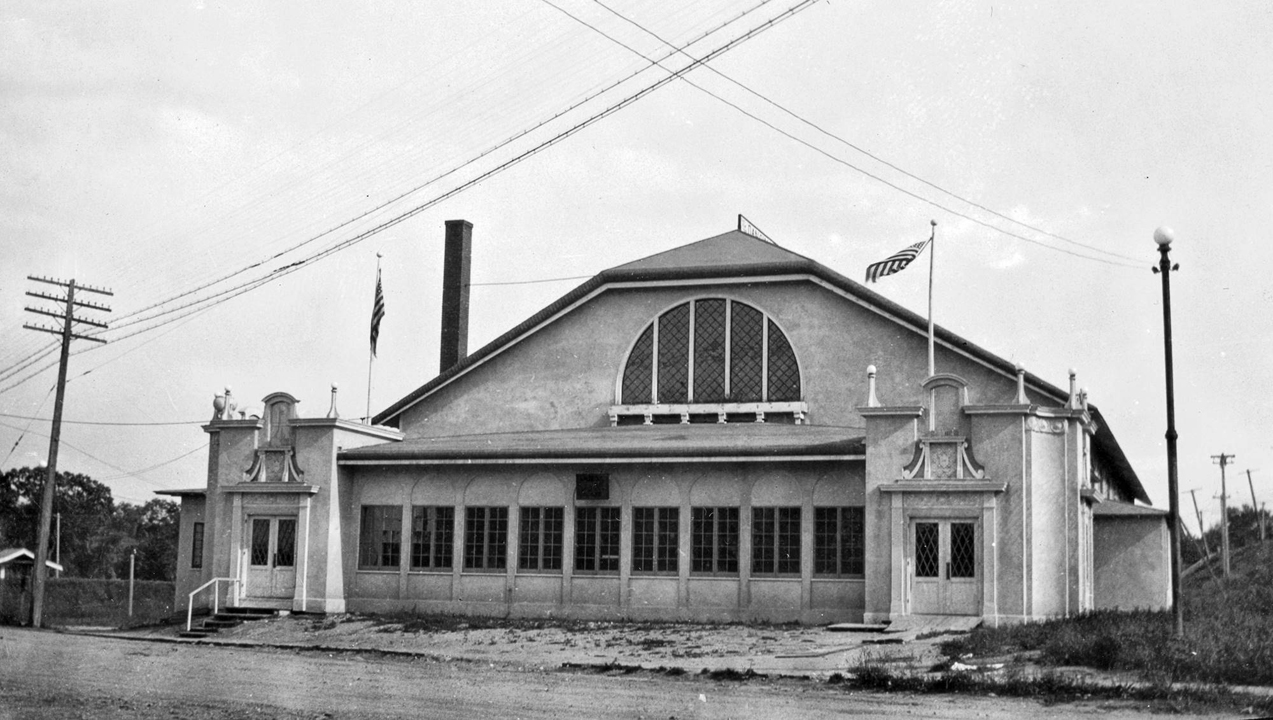
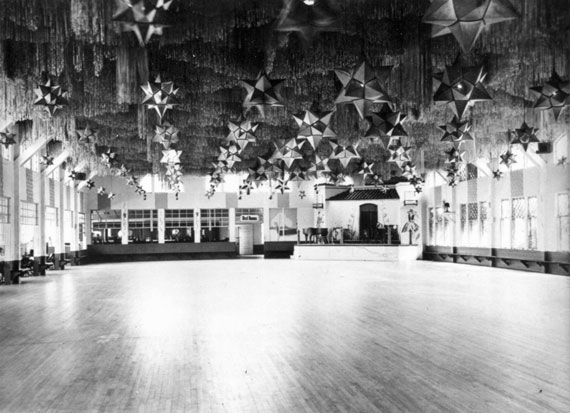
DANCING ON SUNDAY!
Lake View Park Pavilion introduced dances on Sundays in July 1923. This caused consternation among the members of the Women’s Club, supported by “the church people.” “The question is being discussed as a moral problem People are debating whether Excelsior should abandon its time honored custom and be the first village in the lake region to permit the operation of public dance halls on Sunday.” The question was left up to a public referendum that was held on Saturday, July 21, 1923. Despite a big “Vote NO!” ad in the Record, the tally was 252 for Sunday dancing and 205 against.
A “monster dance” was held on Hallowe’en 1923 at Lake View Park Pavilion. Tickets were sold for two months prior, with the prize of a five passenger Star touring car promised as the prize. Although the music was deemed “adequate,” the party was a great success, with the dance floor filled with patrons from the cities and the lake region.” The car was won by Miss Hazel Holman, who worked for the George H. Hasher Grocery Store.
October 26, 1923: Lake View Pavilion to Have Heating Plant. Two hot air furnaces were installed for Saturday dances. Basketball games were also held in the pavilion.
1924
April 26 was the start of the 1924 dancing season, with Saturday night dances until the regular summer season began in June. Music was again provided by Clarence Peterson’s Lake View Orchestra (eight pieces). Eber Armoagost received a six months’ leave of absence by the trolley company so he could devote his time to the Pavilion.
In September 1924, what would become Excelsior Amusement Park was first proposed by the Fred W. Pearce Amusement Company of Detroit. “An overhead bridge of ram (sic) leading over the Yellowstone Trail (Excelsior Blvd. – Highway 7 wasn’t built yet) to the Lake View Pavilion are included in the plans.”
1925
On March 27, 1925, the Excelsior Athletic Association put on a show that included:
- Kiddie Kar Polo games
- Basketball games (Excelsior fats vs. Excelsior leans – “Last year the leans had it on the fats, but the fats have been training and are fatter this year, and should be able to hold their own.”)
- Wrestling and boxing matches among local boys
- Music by the Excelsior Band
Dances were held at the Pavilion every Saturday night (May 1, 1925).
EXCELSIOR AMUSEMENT PARK OPENS
Excelsior Amusement Park opened on May 23, 1925, on property which originally housed a terminal for ferry boats to Big Island Amusement Park. It was located across Excelsior Blvd./2nd Ave. from the Ballroom, which was sometimes called the Lake View Pavilion and sometimes the Excelsior Dance Pavilion.
The Amusement Park was situated on 17 acres of land. In an interview, Pearce described building the Park as the most unusual job.
Some 10 acres of swamp had to be filled in, with a present lake frontage of 1,600 feet. The rides were first built on pilings, and then the solid ground was filled in around the pilings. The crew worked all the winter of 1924 – ’25 on this project. (Billboard, July 30, 1949)
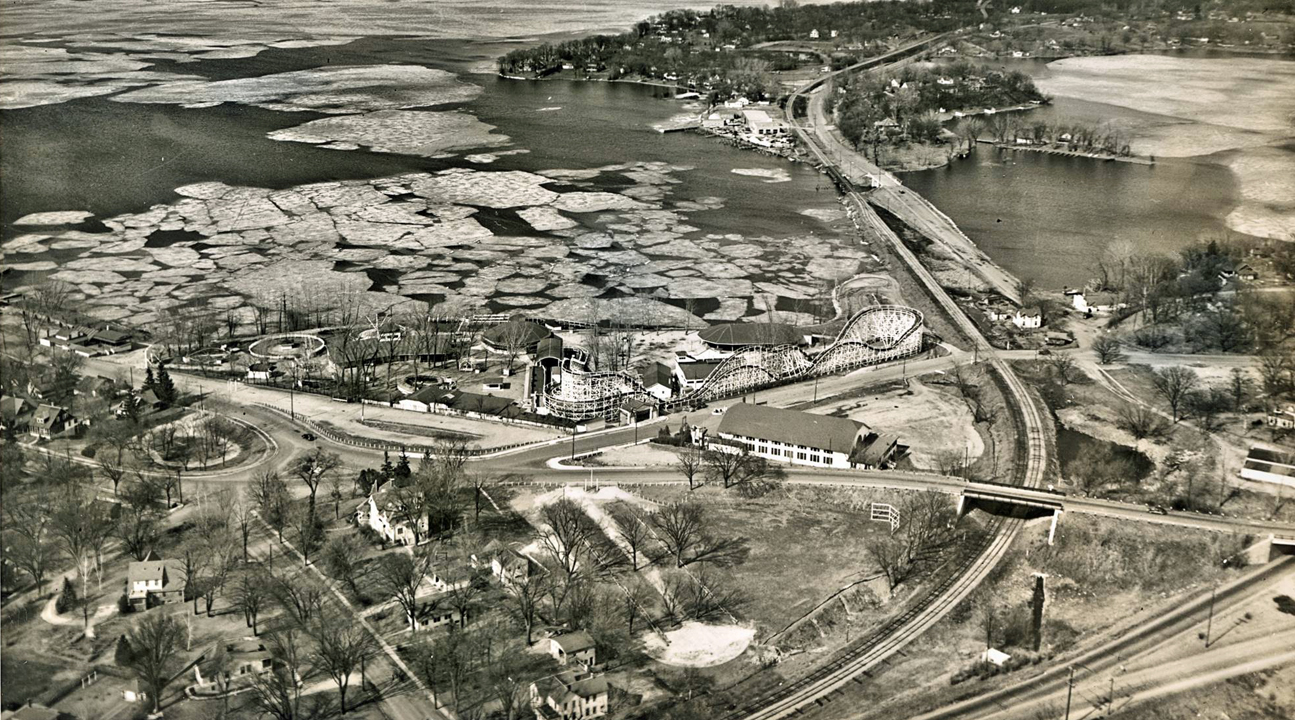
Frederick W. “Bill” Clapp, Fred Pearce’s 25-year old cousin, was named assistant superintendent, overseeing the park’s construction and operation. Lorenzo C. “L.C.” Addison was the general superintendent of construction and the park’s first general manager.
That first day of operation, there were 11 attractions, drawing 20,000 people.
Early ads were quite dramatic!
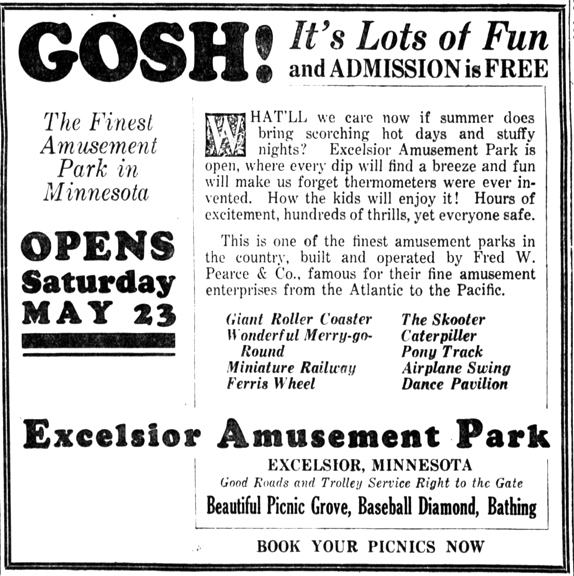
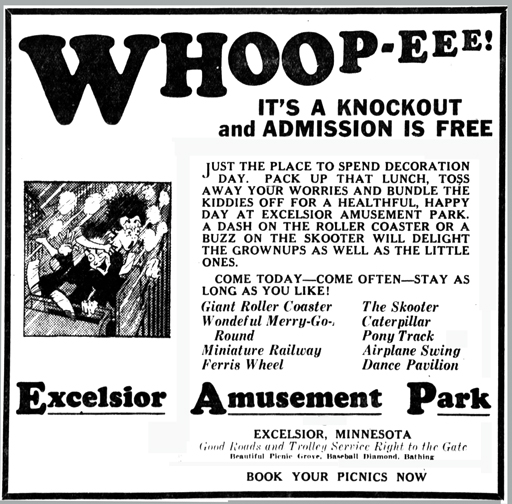
September 11, 1925: Although the end of the Lake season was at hand, “The Lake View Pavilion, which has become the most popular dance pavilion around the lake, will continue to have dances three nights during the week, Wednesday, Saturday and Sunday.”
1926
On March 31, 1926, a program with 19 pieces was presented by the Excelsior band, directed by H.O. Carciofini. One of the numbers was “By the Waters of Minnetonka.” Dancing followed.
EXCELSIOR PARK PAVILION
An ad dated May 15, 1926, tells us that there was dancing every Wednesday and Saturday nights at the Excelsior Park Pavilion, with music provided by Clarence Peterson and His Orchestra.
Dancing may have increased to every night; the roof on the undated photo below advertises weeklong dances, and the paint may indicate that it just recently changed its name from Lake Park Pavilion to Excelsior Park Pavilion.
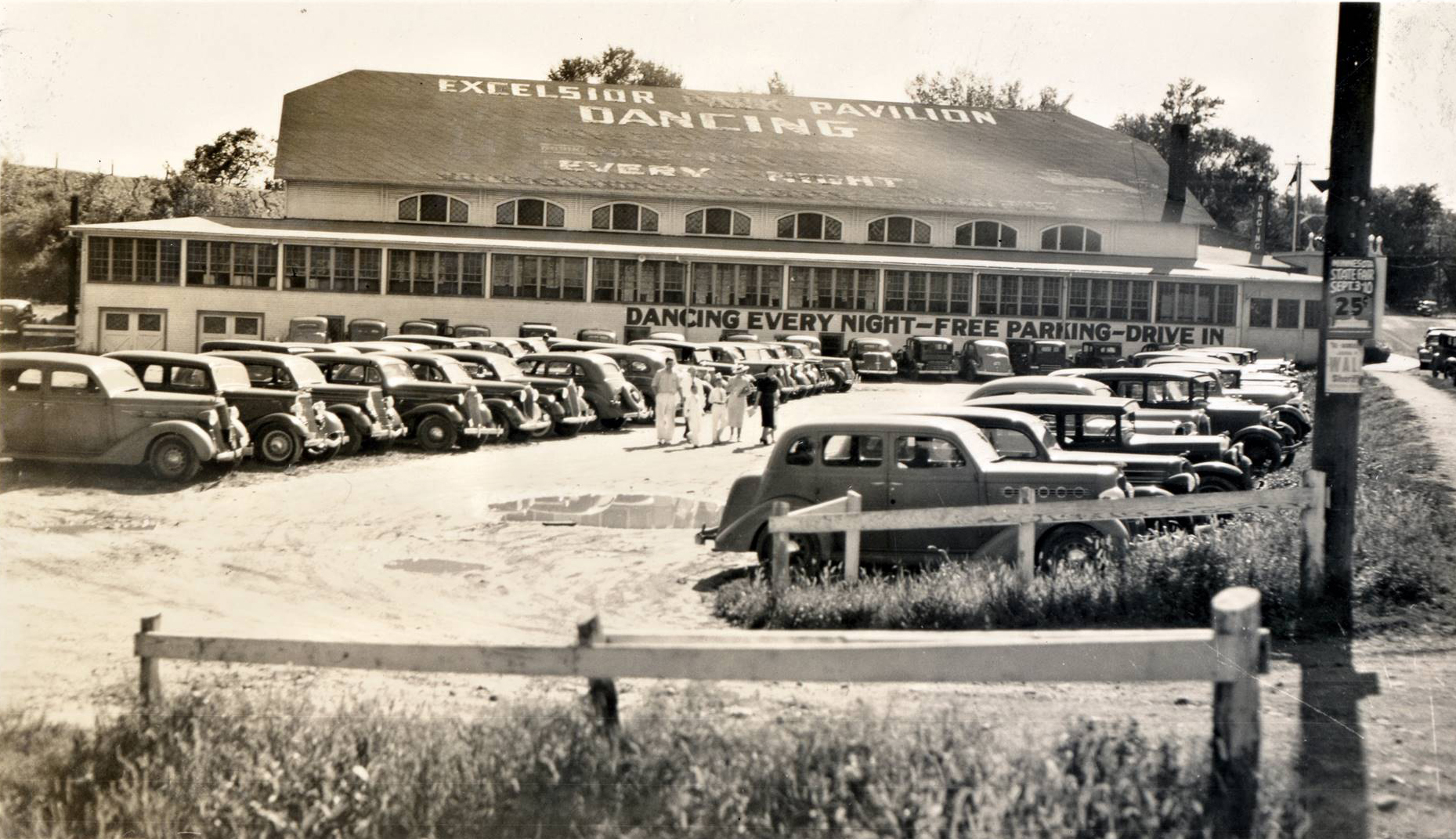
In the 1926 off-season, roller skating took over the pavilion full time, accompanied by the “Six-piece Union Band” every Saturday and Sunday night.
1927
March 25, 1927:
McNiece Revives Roller Skating: J.E. McNiece, proprietor of the Excelsior Park Pavilion, will open the pavilion Sunday night for roller skating and will continue three nights a week through the spring and summer months. During the summer, skating will be alternated with dances three nights a week. There will be music for the skaters as well as for the dances.
April 1, 1927:
J.E. McNiece will open the dancing season at the Excelsior Park Pavilion on April 16 [with an Apple Blossom Dance]. Special music for the opening night has been engaged…. Mr. McNiece’s dances have always been clean and orderly and he says the same high standard will be maintained through the coming season.
The annual concert of the Excelsior Band took place on April 22, 1927, at the Excelsior Park pavilion. In addition to the concert numbers, “special entertainers” were promised. Proceeds went to support the band, which was directed by Mr. Carciofini.
ROLLER SKATING
The summer of 1927 schedule at the Excelsior Park Pavilion started out with dances every Saturday night and roller skating every Sunday afternoon and evening. During June, July, and August, the dance schedule changed to every Wednesday, Saturday, and Sunday night. Roller skating (also accompanied by music) was available Monday, Tuesday, Thursday, and Friday nights. In August the dances scaled back to Saturday nights only, with roller skating expanded to every night except Saturday.
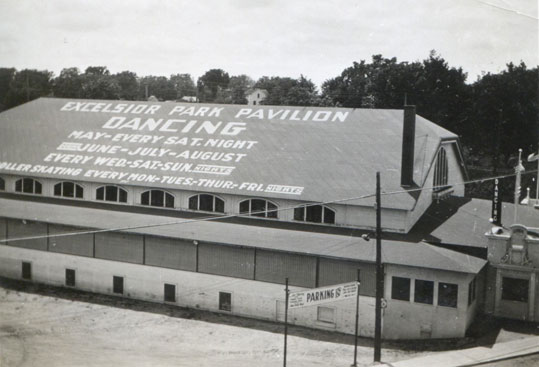
THE PICNIC PAVILION
The Amusement Park opened for the 1927 season on May 14, with new Park Manager Samuel Benjamin.
In 1927 the Park featured a new picnic pavilion that could accommodate 1,500 picnic-goers. The pavilion had no sides and was constructed on fill that had been dredged from the bottom of Lake Minnetonka. A stage was provided for speakers and performers of organizations. Concerts at the new picnic shelter were given every afternoon and evening. The building was for special events and concerts only – no dancing was done here. Admission was free.
On the stage is being installed a foremost achievement of the music world, the newly-invented auditorium orthophonic. Pearce explained:
The Auditorium Orthophonic presents singers, bands, orchestras, choruses and choirs as though the artists themselves were appearing before you. You may sit as close as you please, or you may be three miles away from the Orthophonic and in either case you will hear it just as distinctly and without distortion or mechanical sound of any kind.
Here is a photo of one found online:
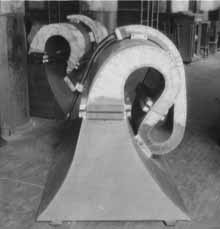
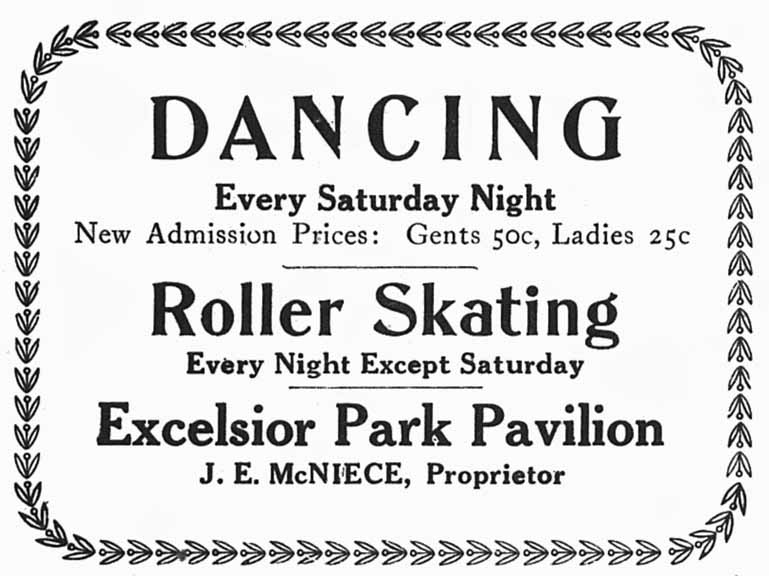
On August 13 and 14, 1927, the Excelsior Park Pavilion hosted special dances with Hal Keller’s 8-piece Band, just back from a nine month tour. Keller was formerly with Isham Jones’ Orchestra in Chicago. New prices: Ladies 25c, Gents 50c.
A Gala Corn Carnival was held at the Park from August 21 to September 5, 1927. Every night there was a masquerade contest with a different theme each night. The ad also promised “Confetti Battles, Rube Bands, Parade of all Masqueraders, Special Added Attractions.” A new “Auditorium Orthophonic” was installed in the ballroom. It appears to be a huge speaker.
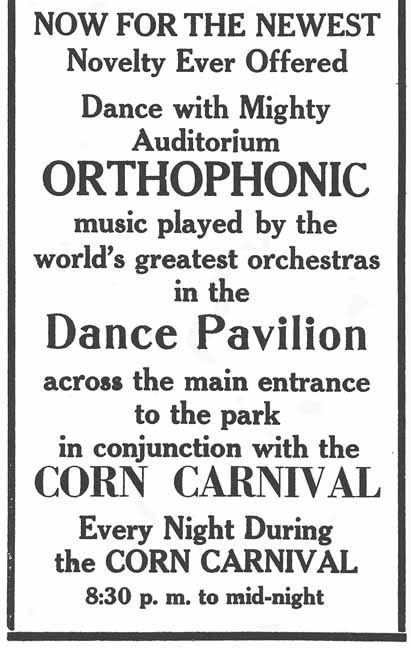
The October 1st, 1927, Saturday dance was called the Kiss Dance, with music by the Original Royal Vagabonds – Eight Master Players, Singers, Entertainers. Ladies and Gents both 50 cents. “Boys, bring your lady friends.”
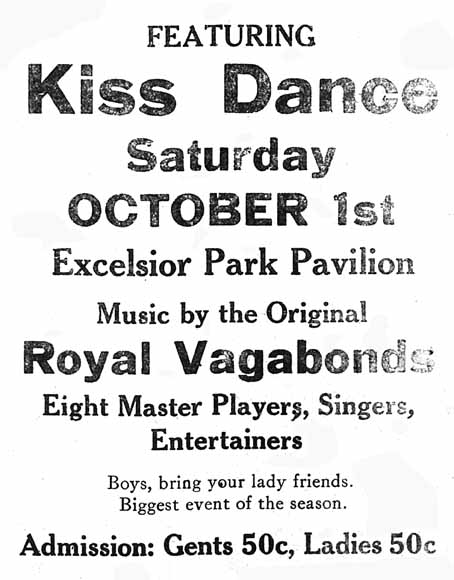
1928
What’s this? In an ad for a basketball game between the Williams Brothers of St. Louis Park (Yea!) and Excelsior on January 18, 1928, the paper called the venue the Lake View Pavilion. There’s a missing issue of the Record, and then on January 27, 1928, it’s back to the Excelsior Pavilion. Another game between the Excelsior Firemen and the Minneapolis Business College on February 25, 1928, was described as being at the Excelsior Park Pavilion.
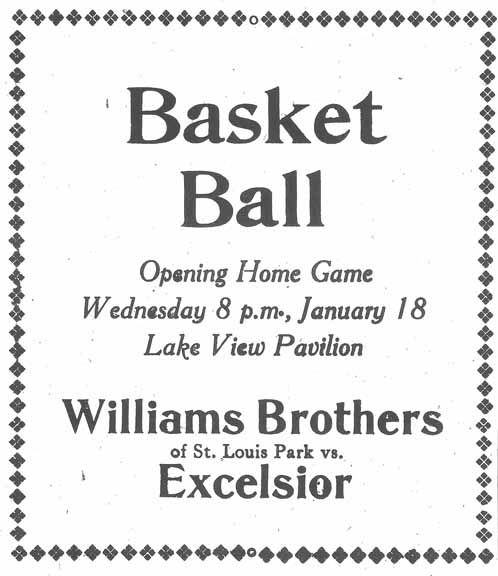
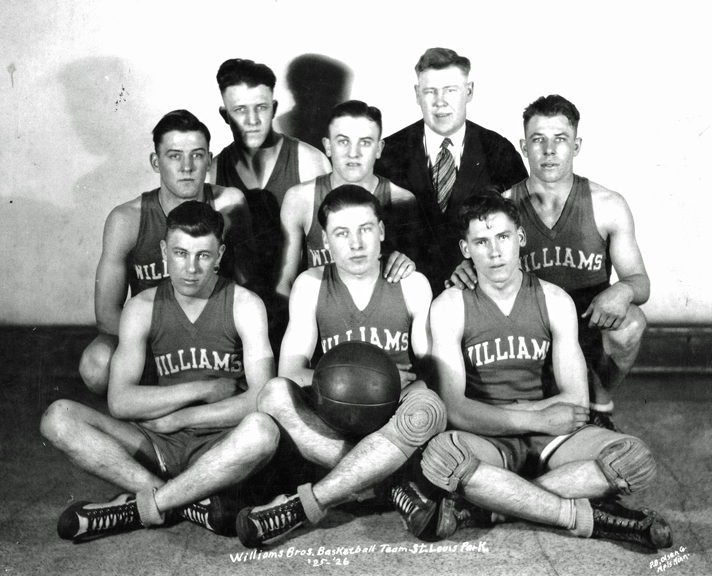
EXCELSIOR GARDEN PAVILION
April 27, 1928:
The Excelsior Garden Pavilion, formerly the Excelsior Park pavilion, opened for the season with a dance Saturday evening. There will be dancing every Saturday Night until May 30. From then on the pavilion will be open every night throughout the season. There will be a new orchestra each week. J. E. McNiece is proprietor.
Striking effects are obtained in the decorations. The large room is made to represent a garden. In the center appears a rugged tree. From this point paths diverge in several directions. The floor is stained a forest green. The walls are treated to carry out the forest and garden effect.
An ad that same day promised: “Something New and Different. Come dance in the garden on the green. Eddie Corlew and his Aristocrats, formerly at the Merigold (sic), will furnish the music Saturday night, April 28th. Ladies 25c, Gents 50c.”
May 11, 1928:
The Excelsior Garden Pavilion, J.E. McNiece, proprietor, opened the season with all new decorations that emphasize its attractive name. The main dance hall is being transformed into a veritable garden, with simulated paths radiating from a large spreading shade tree in the center of the room. While the Pavilion has been open for more than three weeks with regular dance nights, Mr. McNiece plans to have the place in ship shape for the grand opening May 30.
The manager of the Amusement Park was Sam Benjamin.
On August 1, 1928, a gale force windstorm hit the Park, doing much damage to the rides – especially the roller coaster.
EXCELSIOR DANCING PAVILION
Having a tree in the middle of a dance floor might not have worked.
On October 30, 1928, the Excelsior Dancing Pavilion was sold at a sheriff’s sale to the Fred W. Pearce Corp., the owners of the Excelsior Amusement Park.
The new owners announce that extensive improvements will be made that will make the pavilion one of the finest ball rooms in Minnesota, and that the very best orchestras will be engaged during the summer months, which together with elaborate lighting effects will undoubtedly result in enormous crowds from the Twin Cities. (November 2, 1928)
On November 6, 1928, election returns were broadcast on the “Mighty Orthophonic,” and dancing followed. Music for the November 17 dance was provided by Wesley Barlow’s Hotel Nicollet Orchestra (Ten Pieces).
1929
The Excelsior Dancing Pavilion was used for the first time in the 1929 season on Friday, May 10, with a function held by a group of University students. The Amusement Park opened on May 11, 1929.
The dance pavilion has been re-decorated inside and out. A 10-piece orchestra, Red Clark and His Play Boys, has been engaged for the season. There will be dancing every night from May 11 on. Sam Benjamin and Fred W. Clapp are managing the park, the same as formerly. (May 3, 1929)
August 31, 1929 was KSTP Grandpa Reception Day (?) at the Park, celebrated with a Big Dance Carnival every night from August 31 to September 8. Novelties, balloons, hats, horns, and noisemakers were all provided – “Everything to make Whoopee.” Wally Erickson and His Wonderful Orchestra provided the music.
The photo below was taken from the roller coaster. Dancers had to enter in the clown/sailors’ mouths, which were made of “Celotex” and painted in oil to withstand the weather.
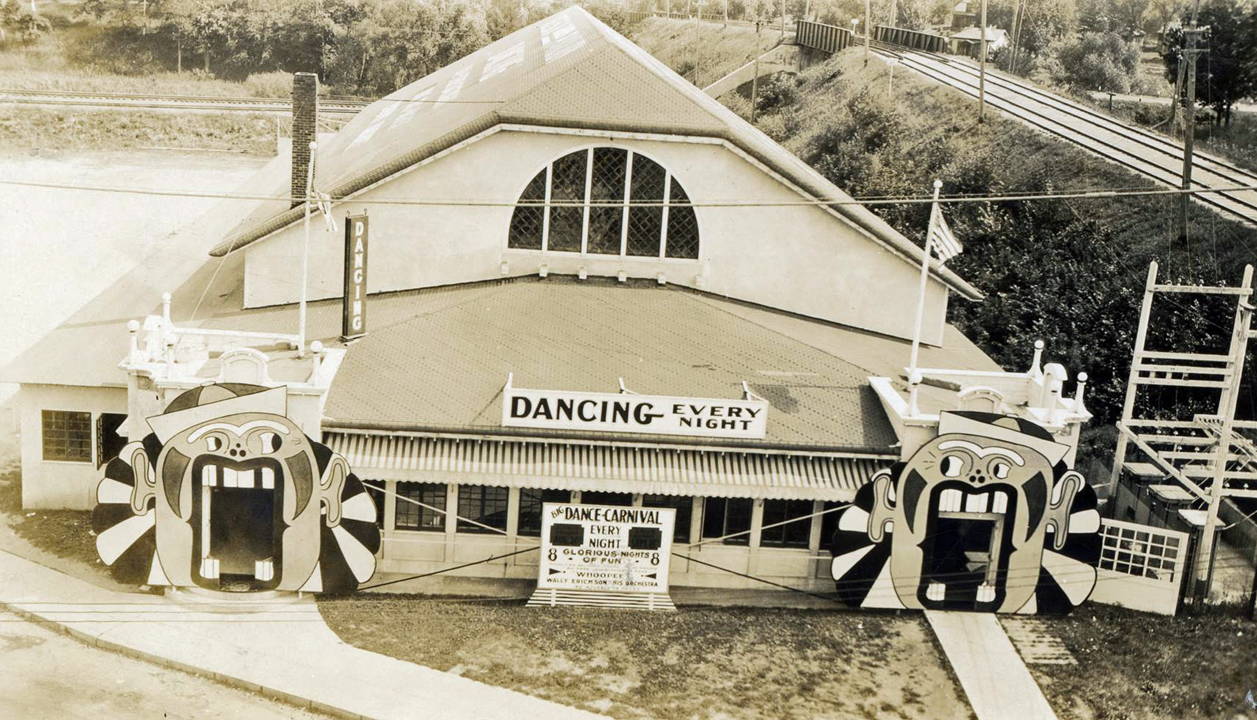
Below, Scott McGinnis gives us an idea of how these entrances may have looked in color:
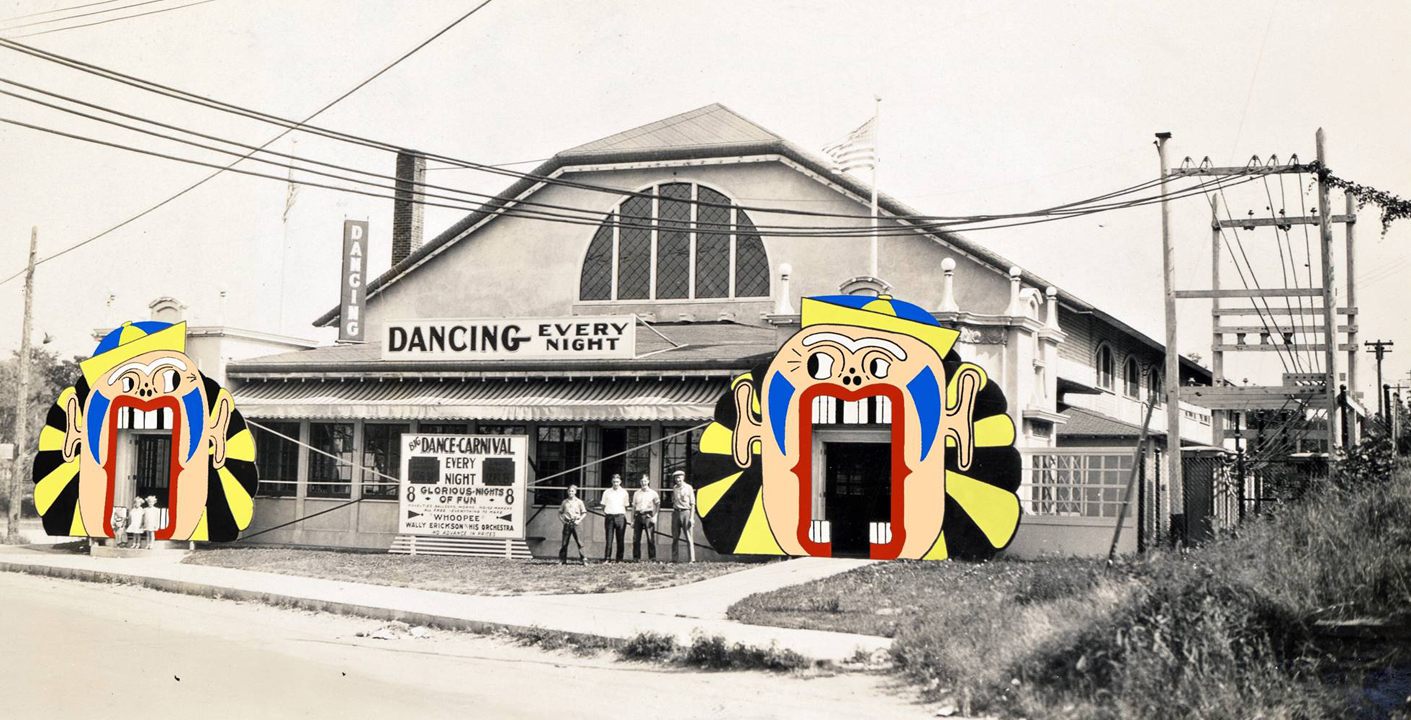
1930
From 1930 until his death in 1957, the manager was Rudy Shogran, who is described as a “master of the promo.” One of his stunts was to provide motorcycle escorts to bring national acts performing downtown at the Orpheum out after their shows. Shogran was also in charge of booking the ballroom.
Was this a Ballroom newsletter? Were the Original Admirals the house band?
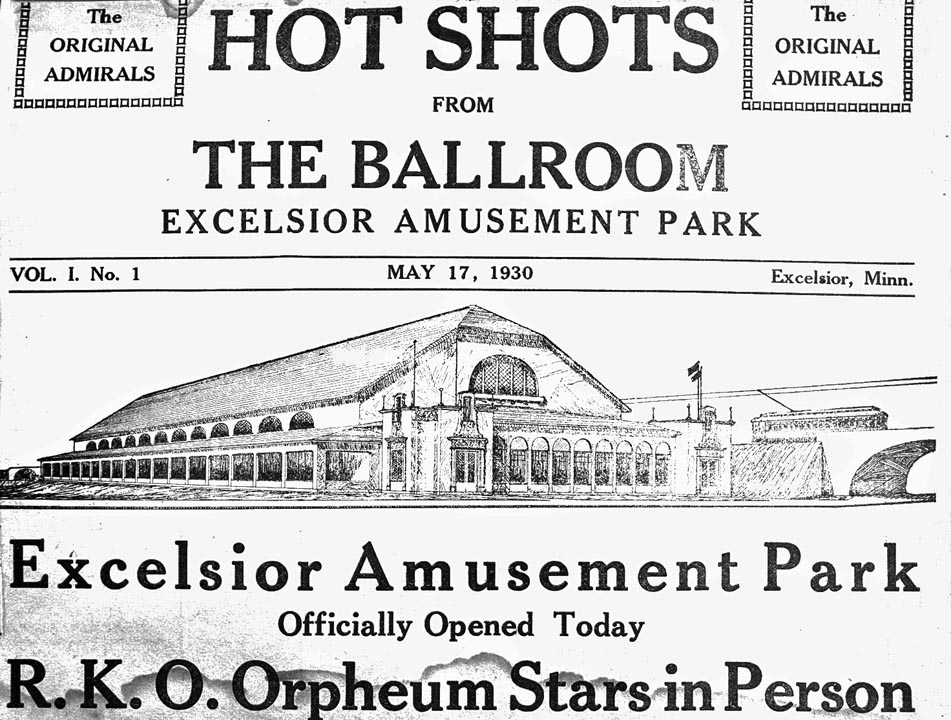
High School Commencement Dances were inaugurated in June of 1930.
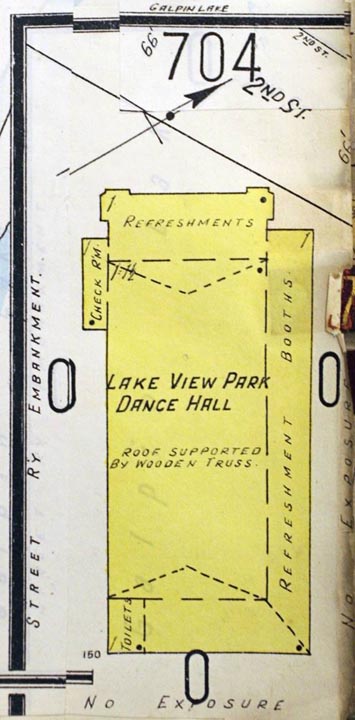
1931
Pre-season dances were held on May 2 and 3, 1931, with music provided by Mildred Couch and her Rosebuds.
This is a band of girls capable of doubling on several instruments; each player is an artist. The band has a long record of success on R.K.O. and Publix theater circuits in the east and in Canada. Dance and music fans will have an opportunity to hear and step to the strains of a tip-top orchestra. These girls were received as a sensation in Hollywood recently. (Record, May 1, 1931)
The review was favorable:
Mildred Couch and her famous Rosebuds captured the hearts of dancers from the surrounding territory last Saturday and Sunday at the Excelsior Amusement Park Ballroom. In a stage setting of delicate feminine taste and surrounded by soft lighting incandescents, the girl’s band registered a distinct hit on their first opening dance. Their rhythm together with the rendering of splendid dance music no doubt will bring hundreds to the ball room for the next appearance next Saturday and Sunday nights. (Record, May 8, 1931)
The ballroom was being overhauled for the official opening on May 16, 1931.
Large and small stars electrically lighted in the ceiling of the ball room will make a beautiful setting for the many dancers who patronize it. The famous Rosebuds will furnish the music for dancing. (Record, May 15, 1931)
The season officially opened on May 16, 1931.
Starting June 6, the Park engaged Fran Whalyn and His Orchestra for a 10-week stint, direct from a similar engagement in Oklahoma City.
Chock full of pep, personality and rhythm, this orchestra has made a big hit at every engagement and the management of the park feels there is a treat in store for dancers from this locality who attend their opening night. (Record, June 5, 1931)
The second Annual High School Commencement Dance was held on June 11, 1931.
The July 4 fireworks were rained out, but the Park made up for it on Sunday, July 12. A special dance was held that night featuring Wally Erickson’s Orchestra, with Ray Kopstad directing.
Starting on July 6, 1931, the Wally Erickson Orchestra provided the music in the ballroom. They came direct from an engagement at the Marigold Ballroom.
Rudy Clemmenson’s Orchestra provided the music at the ballroom on August 30 and for a special Labor Day dance on September 7.
On September 13, 1931, there was a special event – the public wedding of Michael Wrona and Beatrice Prevost. The nuptials were held at the picnic pavilion, with the Park providing wedding cake, souvenirs, and “rice for the charivari.” It was followed by a wedding dance in the ballroom with music provided by Rudy Clemmenson’s Orchestra, which was playing at the ballroom at the time.
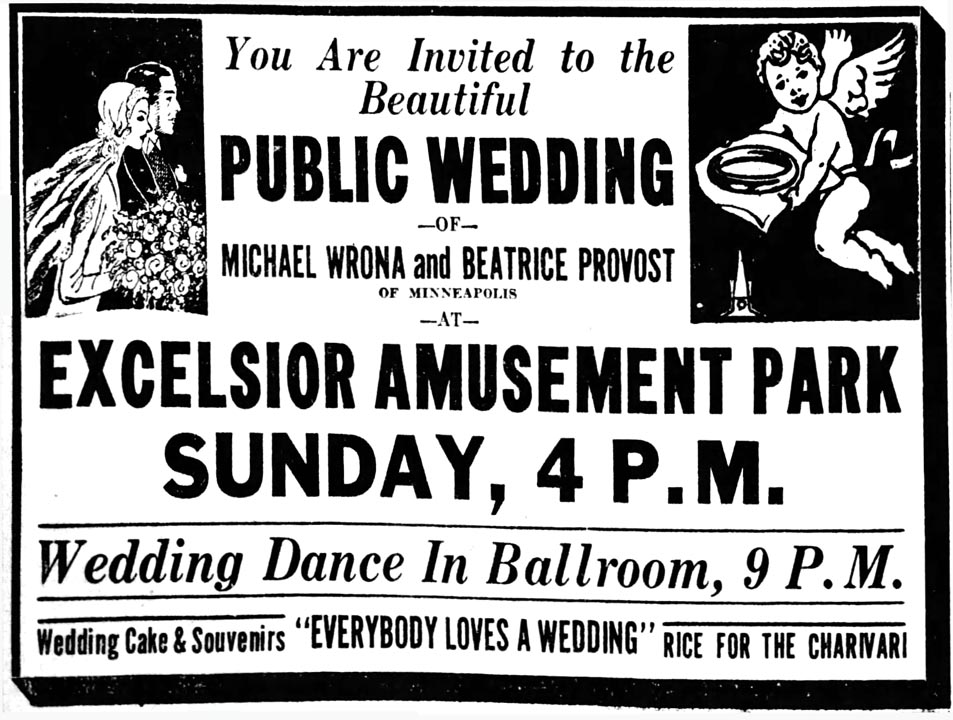
On New Year’s Eve, 1931, the Excelsior Firemen sponsored “A Carnival of Joy” at the ballroom, featuring Mildred Couch and Her Rosebuds. Admission for Gentlemen was $1.00, but Ladies were in for 50 cents. “In all the world no party like this”
1932
Pre-season opening of the Excelsior Amusement Park was Saturday, April 30 and Sunday, May 1, 1932. Music in the ballroom was provided by Rudy Clemmenson and his St. Paul Athletic Club Orchestra. The orchestra had been increased to 11 pieces during it winter broadcasts over WCCO Radio.
A second pre-season opening was announced for May 7 and 8, 1932, with Rudy Clemmenson’s orchestra, “which has become the most popular orchestra in the northwest today.”
The official grand opening for the year was scheduled for May 14 and 15. “Happy Days Are Here Again!”
Special dancing with Rudy Clemmenson’s Orchestra was advertised for Sunday, May 29 and Decoration Day, 1932. The Park was advertised as “The Playground of the Northwest.”
In June 1932 there was dancing every night “at the big pavilion.” Was this the picnic pavilion or the ballroom?
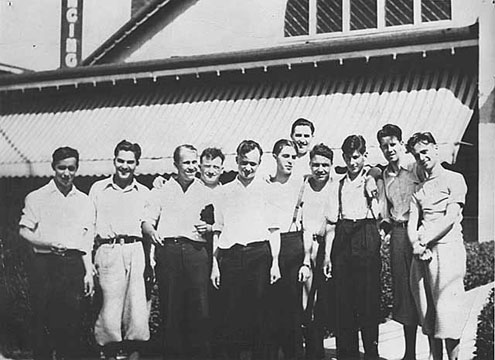
Rudy Clemenson and His Gold Coast Orchestra, taken at the Excelsior Ballroom on June 30, 1932 – courtesy Minnesota Historical Society
Joe Cappo and his Egyptian Serenaders opened their four week engagement at the ballroom on July 4, 1932.
This orchestra consists of an aggregation of musicians who have toured from coast to coast and recently appeared at Atlantic City pier. They promise a big dance program for their opening night and special July Fourth dance from 9 to 1 am. (Record July 1, 1932)
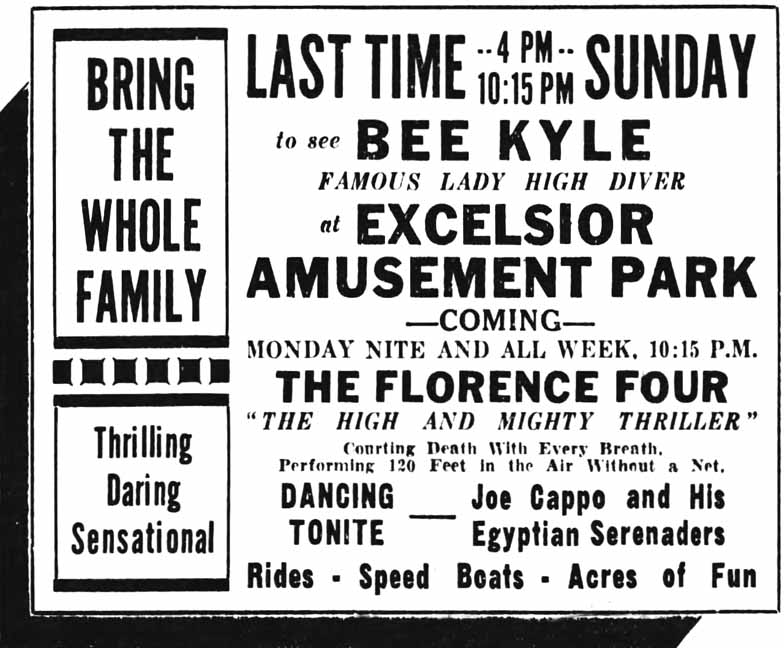
Rudy Clemmenson was brought back to provide the music in the ballroom in August, and remained for the rest of the season. On August 28, a special dance on the night Mystery Girl parachuted 5,000 feet into the lake went until 1 am.
Labor Day 1932 (September 5) promised fireworks and special dancing with Rudy Clemmenson’s Orchestra.
The “Famous Annual Harvest Jamboree” was advertised for the Ballroom on Friday, September 8, 1932.
In 1935 it was mentioned that Lou Breeze’s orchestra had been received enthusiastically three years ago.
And then there’s this – a Chinese wedding, complete with Antiquated Chinese music? This event on September 18, 1932, marked the last Sunday of the season. It is unclear where in the Park this event was held.
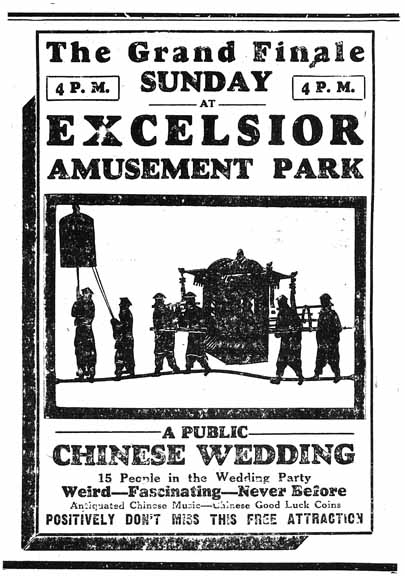
The last streetcar ran to Excelsior in August 1932. This was about when Highway 7 came through the area and the area was becoming more of an auto-based economy. Since the power (direct current) for the Park came from the trolley lines, new motors with alternating current had to be installed over the winter and spring. (Record)
1933
Pre-opening dances were held Saturdays and Sundays before the official opening on May 13, 1933.
Not sure what The Reminder was, but here is a reminder to come to Reminder Night at the Excelsior Amusement Park Ballroom, May 23, 1933:
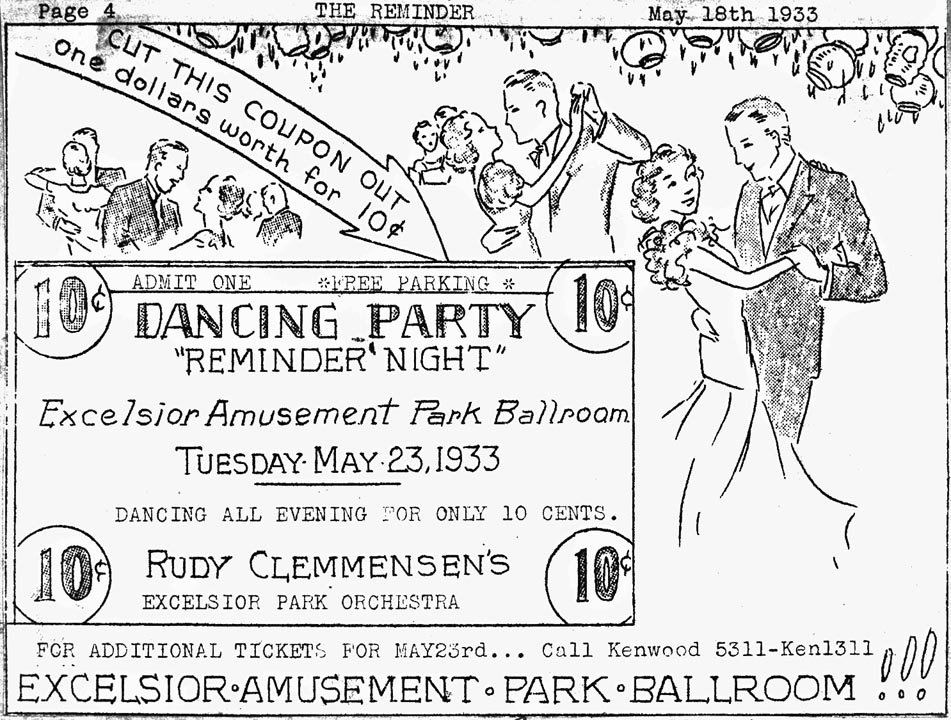
June’s orchestra was led by ballroom favorite Rudy Clemmenson, whose unit now numbered 12 members. The orchestra also presented public concerts at the picnic pavilion on Sundays from 3 to 5 pm.
Dancing was offered every night during the summer. The July 4 dance was free of charge, with music by Clemmenson’s group.
WCCO radio broadcast the music from the ballroom every Tuesday and Friday evening. The radio station also sponsored a WCCO night on August 2, 1933, featuring Tim and Teena and the rest of the station’s personalities.
With the end of Prohibition, events manager Rudy Shogran noticed that attendance at the ballroom was not as heavy. To investigate why, he visited the “honky-tonks” that line Excelsior Blvd. from Excelsior to Hopkins. He found that they drew patrons who were “drunken, loud, talking, and slopping of beer.”
On September 1, 1933, an armed man entered the ballroom brandishing a gun. As panic ensued, the armed man also fled in his car, not hurting anyone. He was picked up the next day with an empty bottle of alcohol in his car.
September 10, 1933, was the official closing date for the Park for the year.
1934
Excelsior Park held its pre-season opening on May 5 and 6, 1934, with dancing to George Ganz and His Golden Gate Orchestra.
The official opening of the Park for the season was on May 12 and 13, 1934, with music in the Ballroom by Frank Gordon and his Orchestra with Gertrude Carpenter.
Frank Gordon and His Orchestra were held over for a second week at the ballroom by request.
Wally Erickson and his 11-piece orchestra provided the music in the ballroom for the week of May 19, 1933. ?
July 4 was so busy at the Park that provisions had to be made for all the cars:
Highway 7 was closed until late in the evening when representatives of the highway department permitted the removal of the detour signs so that the cars could partially be routed by way of the high school building over the highway, which has been closed to traffic for three weeks. (Record, July 6, 1934)
Red Sievers and his Orchestra started an engagement at the ballroom on Saturday, July 14. “This orchestra is well known to the dance populace of the Northwest, having appeared at the Marigold Ballroom in Minneapolis for eight months.” (Record, July 13, 1934)
WCCO ARTISTS’ FROLIC (Record, July 13, 1934) This event was probably held at the picnic pavilion.
Thursday, July 19, WCCO Artist Bureau will present an all-star bill of frivolity at the Park. Fifty entertainers, including specialty dancers, a large chorus of girls, a 15-piece orchestra, several novelty acts, as well as prominent members of the Minneapolis baseball team will headline the program starting at 9 pm and running till 1 am. The entire program is under the direction of Al Sheehan, prominent Northwest radio personality, and will be known as the WCCO Artists’ Frolic.
Rehearsals for this all-star presentation have been conducted for the past week and will continue through until the night of the frolic. Jack Malerich’s well-known radio orchestra, which has been sought by the Columbia Broadcasting System for national programs, will feature with dance music and also play for the complete stage show. Malerich’s orchestra has been heard over WCCO on the Pure Oil program nightly for the past nine months and has risen to the honor of being the best orchestra in the Northwest at the present time according to a recent radio poll conducted in this section of the country.
Among some of the well-known individual artist who will appear will be “Twenty Flying Fingers,” two piano teams made up of Ramona Gerhard and Bee Bailey; and the banjo twins, Ham and Jim, who have done “rube” acts and black face comedian stunts. Both these acts have been featured on the Non Headlights over WCCO for the past eight months. In addition other individuals will include the Four Horsemen, male quartet, and the triple threats.
Among the leading baseball personalities will be Halsey Hall, sports announcer, as well as a number of prominent Minneapolis players. Al Sheehan, nationally known for his work over the CBS System, will be master of ceremonies. This all-star program will be augmented by the Park’s regular entertainment features.
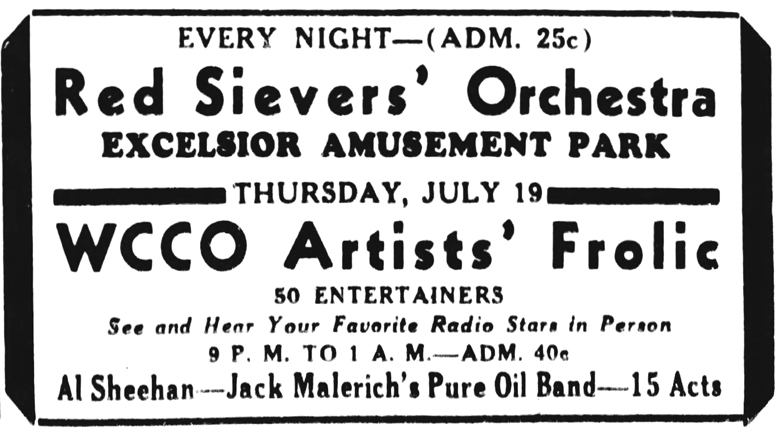
“The annual WDGY radio show was scheduled for August 8, 1934. “It will include all of the WDGY radio stars in person, with a floor show and dance music.” (Record, August 3, 1934) Probably at the picnic pavilion.
“Wally Erickson and his orchestra appearing for a return engagement are playing to large crowds with dancing every night.” (Record, August 3, 1934)
Frank Gordon and his orchestra began a two week engagement on August 18, 1934. Featured vocalists were Gertrude Carpenter and Ted Pomerleau.
A 50-member banjo band led by Mr. C.W. Gould graced the picnic pavilion stage on August 19, 1934, for two appearances at 3:30 and 8:00 pm. Gould’s organization won the national championship of banjo bands three years in a row!
DAISY AND VIOLET HILTON
On Saturday, September 1, 1934, famed “Siamese twins” Daisy and Violet Hilton came to the Park, complete with their own 14-piece orchestra. At the time they were thought to be the only conjoined twins alive. The twins sang, danced, and played instruments. It is unclear where in the Park they performed. One source says that the girls directed the group, and another says it was directed by Morris Lambert, who was engaged to one of the twins.
A problem arose when Violet decided she wanted to marry Mr. Lambert, a trombone player in their orchestra. The lovestruck couple tried to get a marriage license in each town they appeared in but were denied on the grounds that the man would be marrying two women and that, my friends, is bigamy. An article in the Minneapolis Journal warned the Clerk of the District Court that they would be trying again when they came to town! The story of this unsuccessful attempt at marriage (and two successful but ultimately undone marriages) is told in this article.
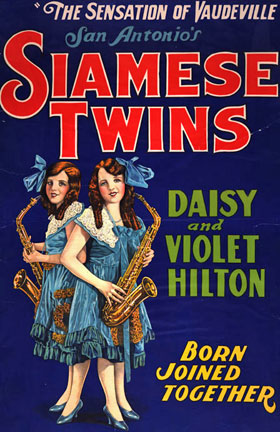
1935
Excelsior Amusement Park had its pre-season opening on April 27 and 28, 1935, with music by Wally Erickson and His Orchestra. “The management will continue the present policy of offering the foremost dance orchestras in the northwest at popular prices.” (Record, April 26, 1935)
The following weekend, May 4-5, 1935, music was provided by Rudy Clemenson and His Orchestra.
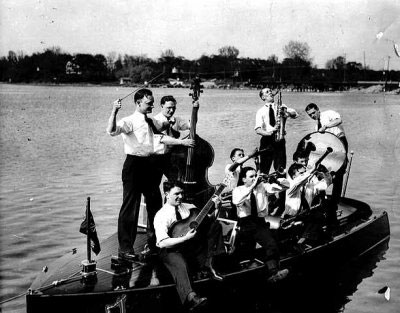
The Grand Opening of the Park took place on May 11 and 12, 1935. The Clemmenson group was engaged for the opening and the week after. It was noted that they had recently appeared at the Curtis Hotel and the St. Paul Athletic Club. (Record, May 10, 1935)
May 18-27, 1935, featured Norvy Mulligan and His Orchestra, Direct from the Radisson Hotel, Minneapolis. The band was featured on NBC radio while appearing at the Radisson. (Record, May 17, 1935) Mulligan’s professional career began in 1923 while attending the U of M. His first professional job was at Excelsior Amusement Park. He went into the insurance business in 1936.
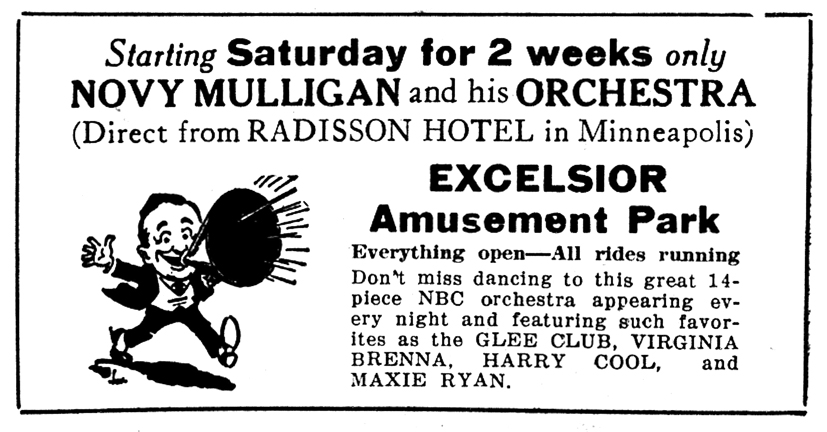
Popular features included:
- Song and dance team Maxie Ryan and Mary Johnson
- Harry Cool and Ray Kammerer, whose interpretation of “Popeye the Sailor” was considered a musical comedy classic
- The Glee Club
- Virginia Brenna
By popular demand, Norvy’s band was held over another three weeks. (Record, June 7, 1935)
The 12th Annual Commencement Dance was held on June 6, 1935.
WCCO REDUX
June 14, 1935, was a repeat of last year’s WCCO show, featuring 40 entertainers. The program was presented from a specially designed and illuminated stage in the ballroom. (Record, June 14, 1935)
Performers included:
- Tena of Tena and Tim
- A 14-piece dance orchestra
- Halsey Hall
- Prominent members of the Minneapolis baseball team.
- The Fels Foursome and Arlene Johnson
- John Williams and Elsa June
- The program was under the direction of Al Sheehan, popular Northwest radio personality. (Hennepin County Review, June 14, 1935)
- Dance music by Norvy Mulligan, “intermingled”
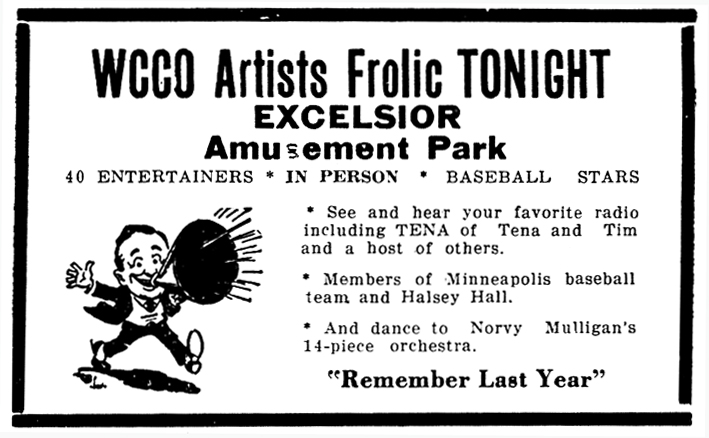
The orchestra at the end of June and much of July 1935 was that of Frank Gordon, with vocalist Gertrude Donohue. The ballroom was described as air conditioned on July 20, 1935.
Joe Cappo and his Egyptian Serenaders opened a week’s engagement on August 3, 1935. It appears that they were held over until September 8, the official closing night of the regular Park season. (Record, September 6, 1935)
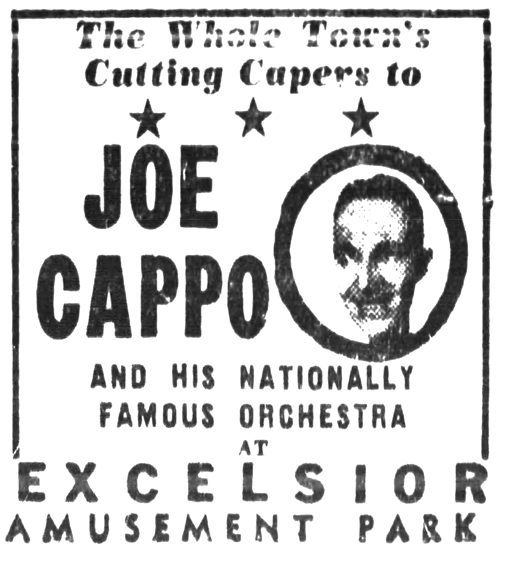
John Ganley was named as the Ballroom’s manager in the August 2, 1935, article.
On August 4, C.W. Gould returned with his 50-piece banjo band for two free concerts at the picnic pavilion. Since the band’s appearance the year before, it won yet another national banjo band championship! (Record, August 2, 1935)
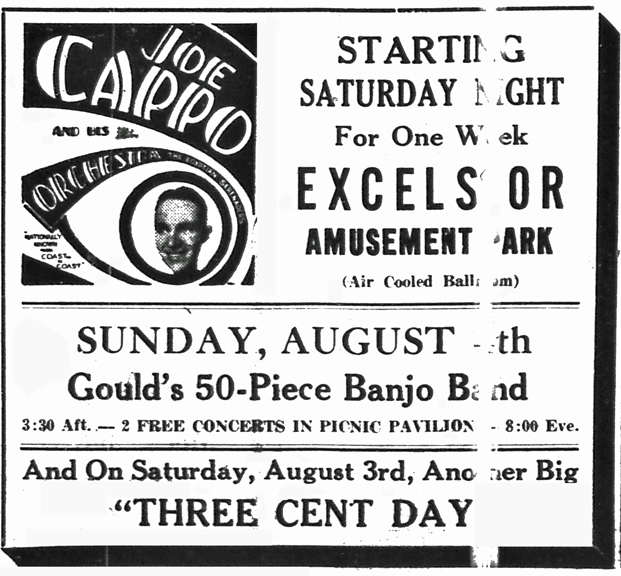
August 9, 1935, was the WDGY Artists’ Show, featuring your favorite WDGY radio entertainers in person and the Joe Cappo Orchestra. (Hennepin County Review)
Must have been a warm fall in 1935, as the Park was open on September 20 for a Dance with the Queen of Apple Day, Excelsior’s annual celebration. Bill Hulwi’s Orchestra provided the music.
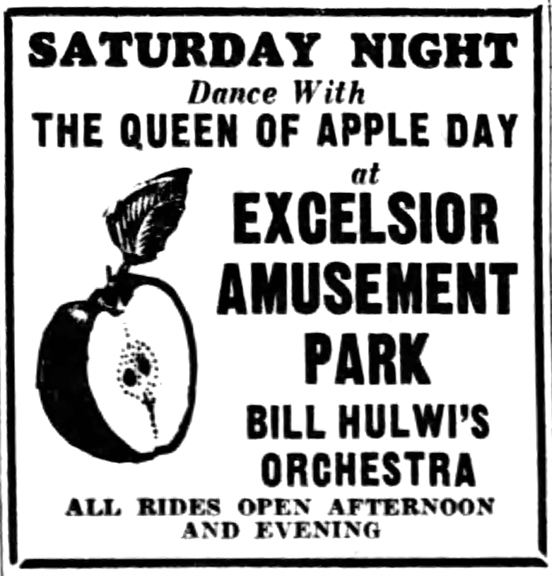
1936
Norvy Mulligan was back, and played for the Annual Commencement dance, held on June 4, 1936.
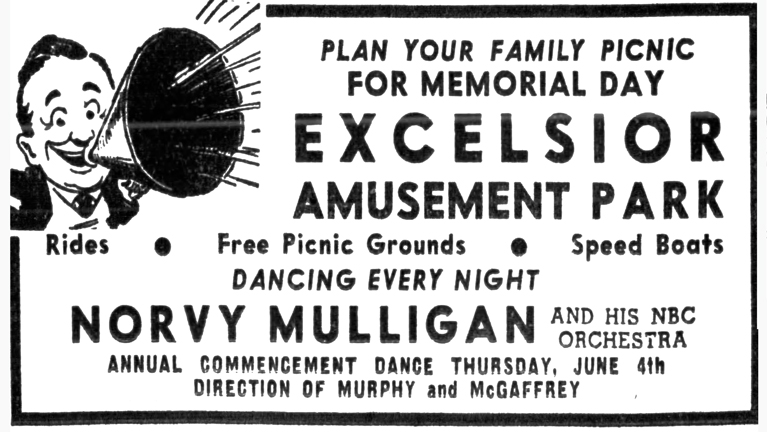
1937
The 1937 pre-season opening of Excelsior Amusement Park was April 24, 1937, with music by Bud Strawn and His Orchestra. The Grand Opening of the Excelsior Park Ballroom was Friday, May 21, 1937, with dancing nightly thereafter. Music was provided by Bud Strawn and by Phil Lavant and His Orchestra (April 30 to May 2 only). The Twin City High School Night was held on May 14.
Rudy Shogran noted in his journal that “Saturday nights are sure different with the young folks and drinking and the new truck dance.” The practice of cutting-in had also developed, which was annoying to many of the dancers.
One night Shogran noted that the band had drawn a bunch of kids who trucked and raced around, and that the ones who trucked were “of a different class of people.”
Gould’s 60-piece Banjo Orchestra provided entertainment in 1937, as well as a Battle of the Bands between Joe Billo’s swing band and Whoopie John’s polka band. There was an Apple Day dance in the ballroom, and the crowning of the Apple Day Queen in the picnic pavilion.
1938
The ballroom established a new policy of providing new and better bands, changing them out every two weeks, and hiring big-name bands for one-night stands in the summer.
The Park opened on May 14, with Hal McIntyre and the MAC Gopher Orchestra in the Ballroom. The Orchestra had been performing at the Lowry Hotel. All ladies attending the opening dance received a free rose.
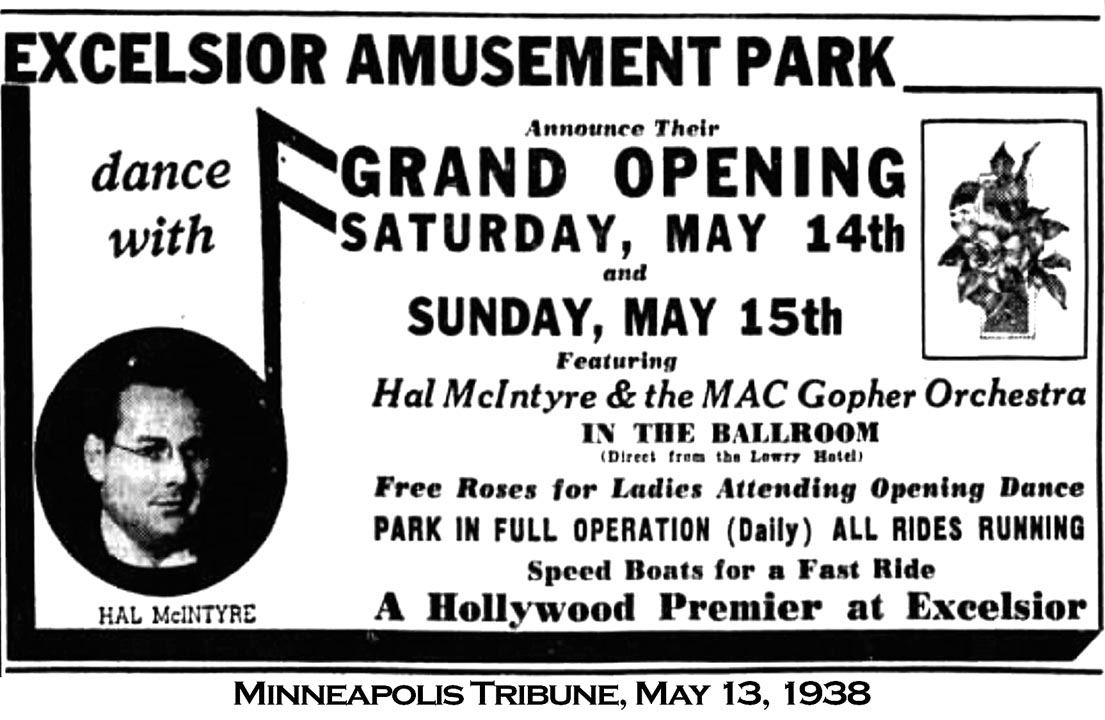
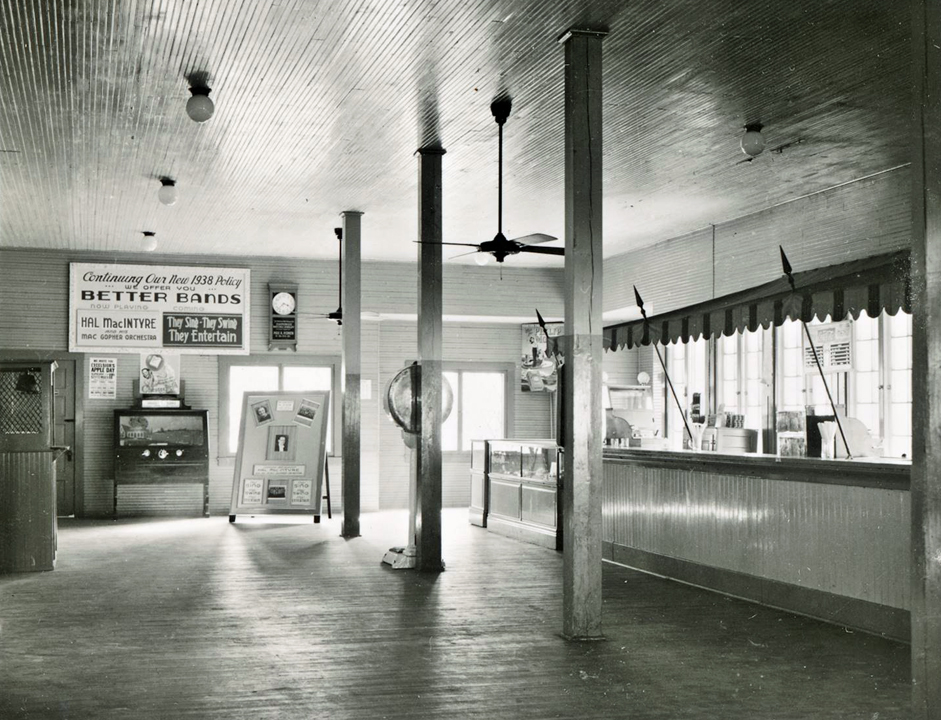
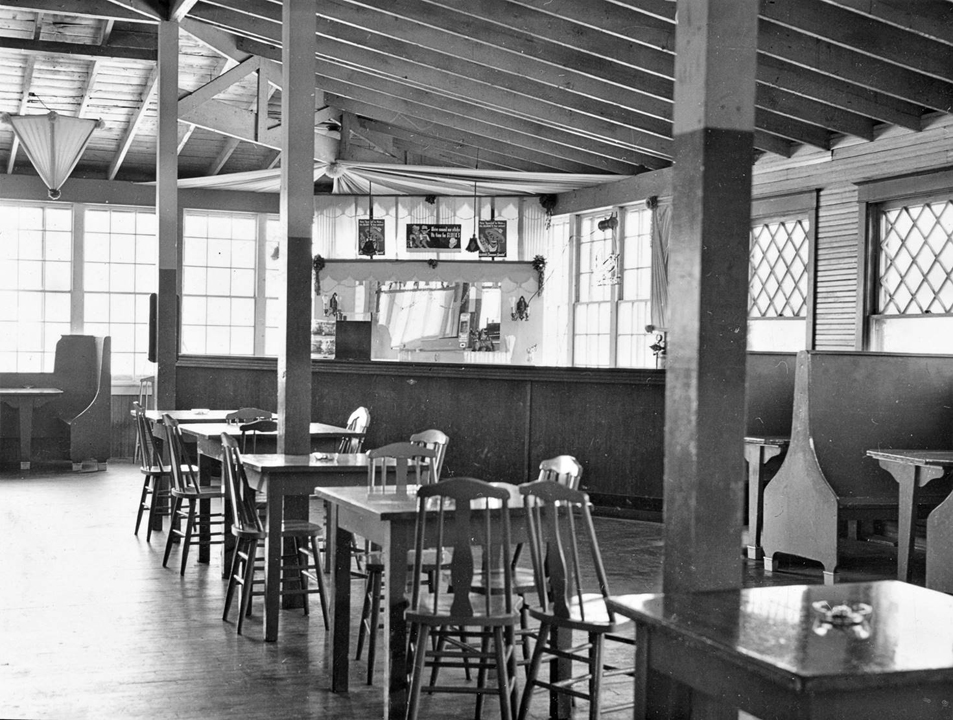
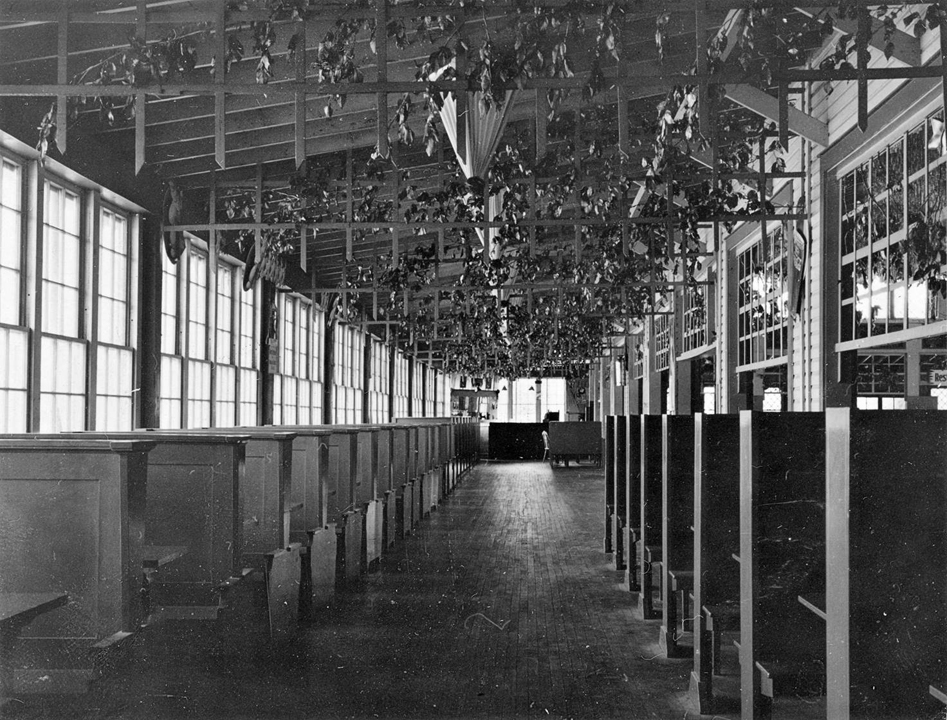
Gould’s Banjo Orchestra returned for a repeat performance in 1938, featuring drum majorette Miss Ann Bennett.
1939
In 1939 the park began to sponsor a Twin City High School Night, featuring a dance band in the ballroom and free rides. Thousands of kids would converge on the park, with special transportation arranged. The first High School Night took place on May 17, 1939, with music provided by Jimmy Pidgeon’s Campus Band.
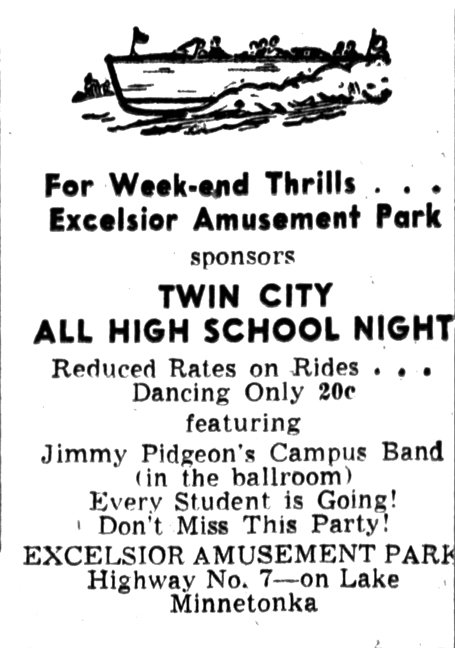
The Park was also still sponsoring the annual Commencement Dance for all graduating seniors. The 1939 Dance was held on June 8, with music by visiting band Tom Gentry and His 12 Ambassadors – “Radio’s Royalty of Rhythm.”
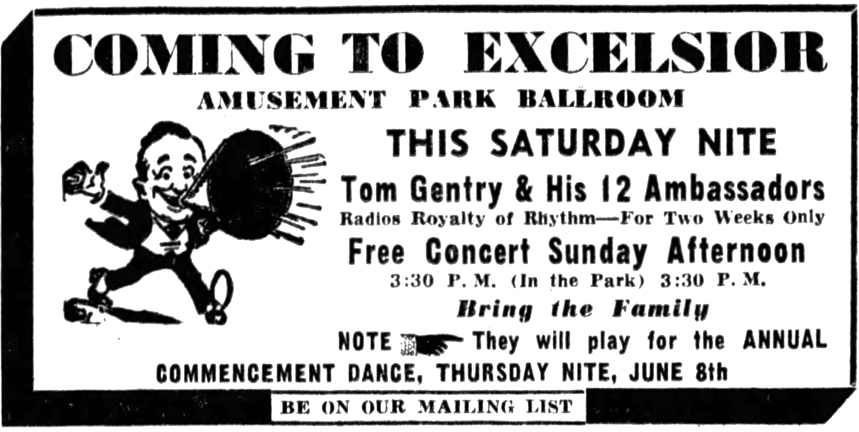
1940
The Park opened on May 17, 1940.
The Twin City High School Night took place on May 24, 1940, with music by Tiny Hill and His Orchestra.
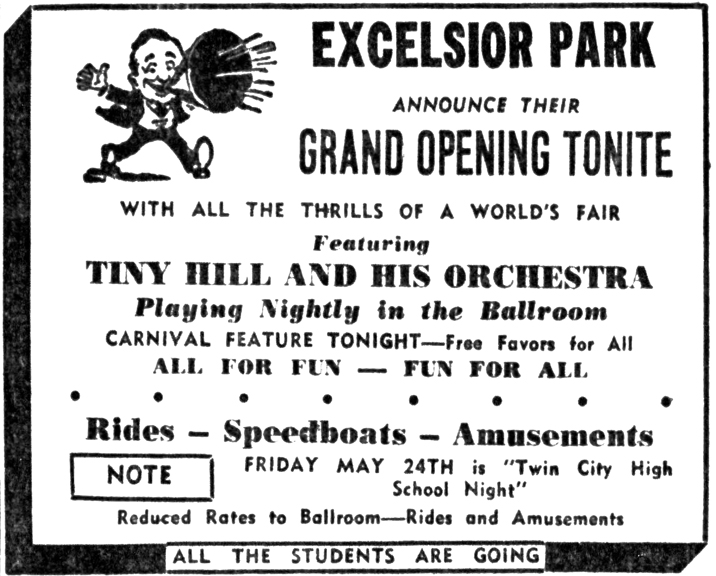
The 1940 Commencement Dance was on June 6, again with Tiny Hill’s Orchestra.
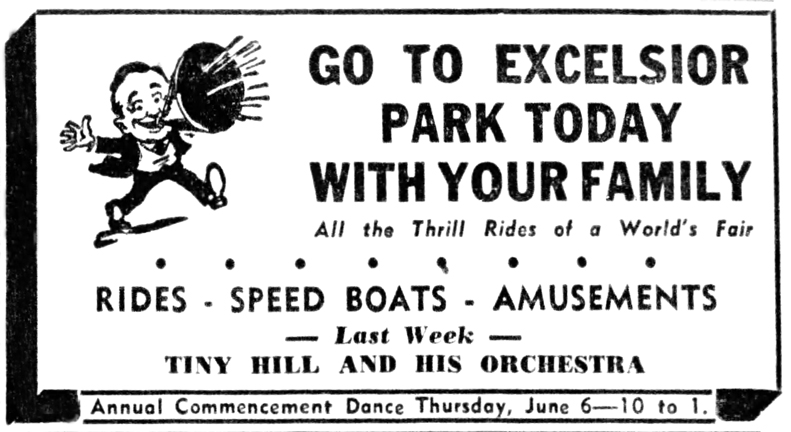

1941
The Annual Twin City High School Night took place on May 16, 1941.
Lawrence Welk performed twice during the 1941 season. The first was on May 21.
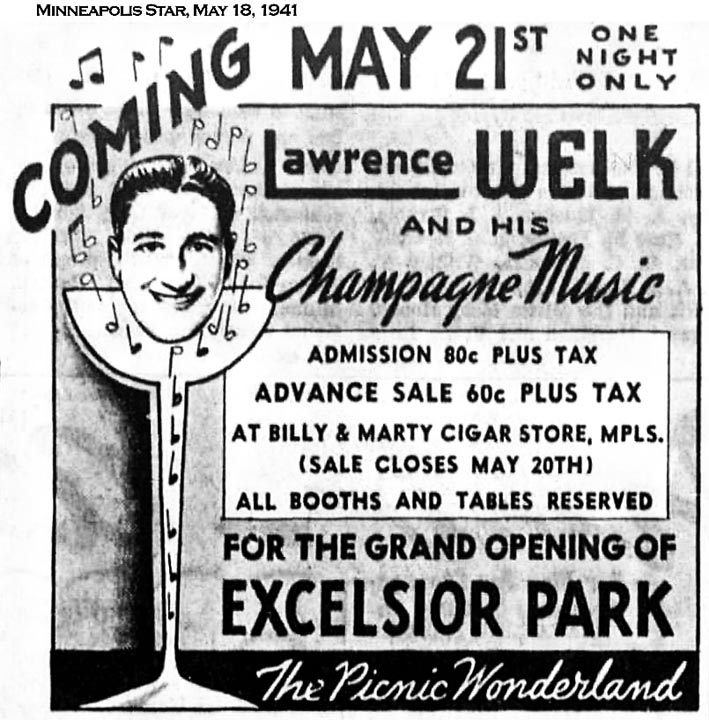
The annual Commencement Dance took place on June 5, 1941.
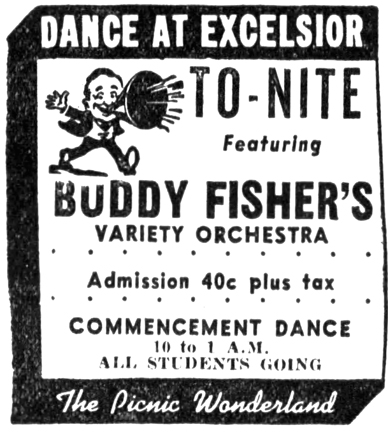
Lawrence Welk’s second performance on July 23 drew 814 people despite 100-degree heat. (Billboard, August 9, 1941)
The popular Glen Gray made an appearance at the ballroom with his famous Casa Loma Orchestra on July 30, 1941. Featured soloists were Kenny Sargent, “Pee Wee” Hunt, and Sonny Dunham.
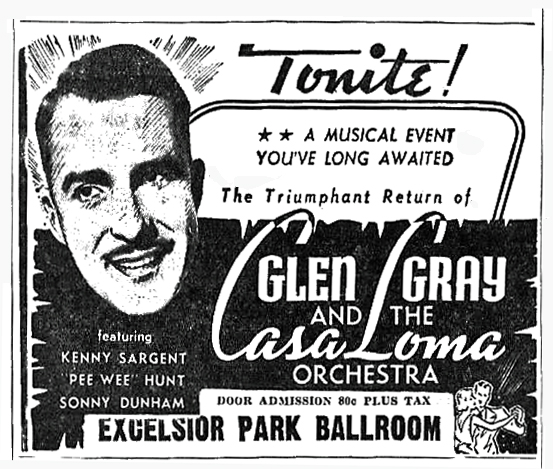
The Andrews sisters, Maxine, Patty, and Laverne, made a one-night appearance at the Park on Friday, August 22, 1941, accompanied by Joe Venuti and his orchestra. The Star reported that they planned to visit their home town of Mound during the trip. (They were born in Mound but raised in North Minneapolis.) A special plane was chartered to bring them to Minneapolis from an engagement in Chicago.
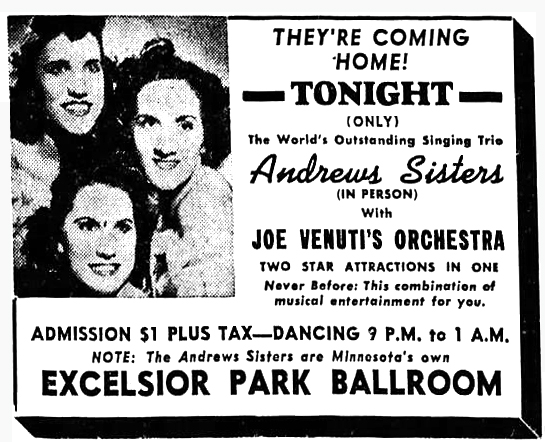
Ace Brigode and His Virginians – A 5-Star Dance Band – appeared for a return engagement by Popular Request at the Excelsior Park Ballroom on September 12-14, 1941, the 14th being the last dance of the season. The Park’s last day of the season was September 21.
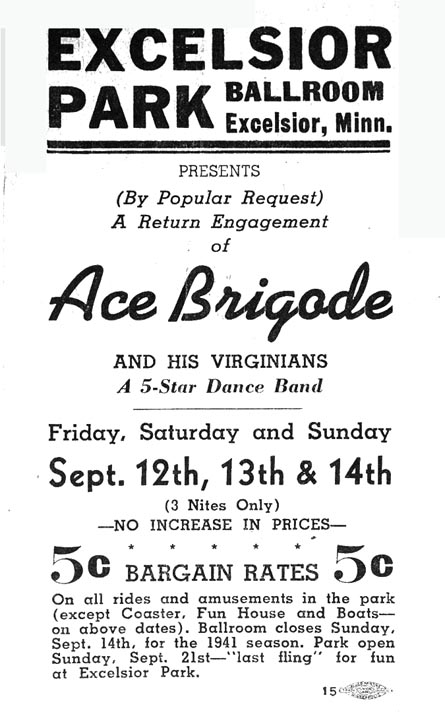
1942
Ace Brigode and His Orchestra (“Your Favorite Name Band”) appeared at the Park’s Grand Opening on May 15, 1942.
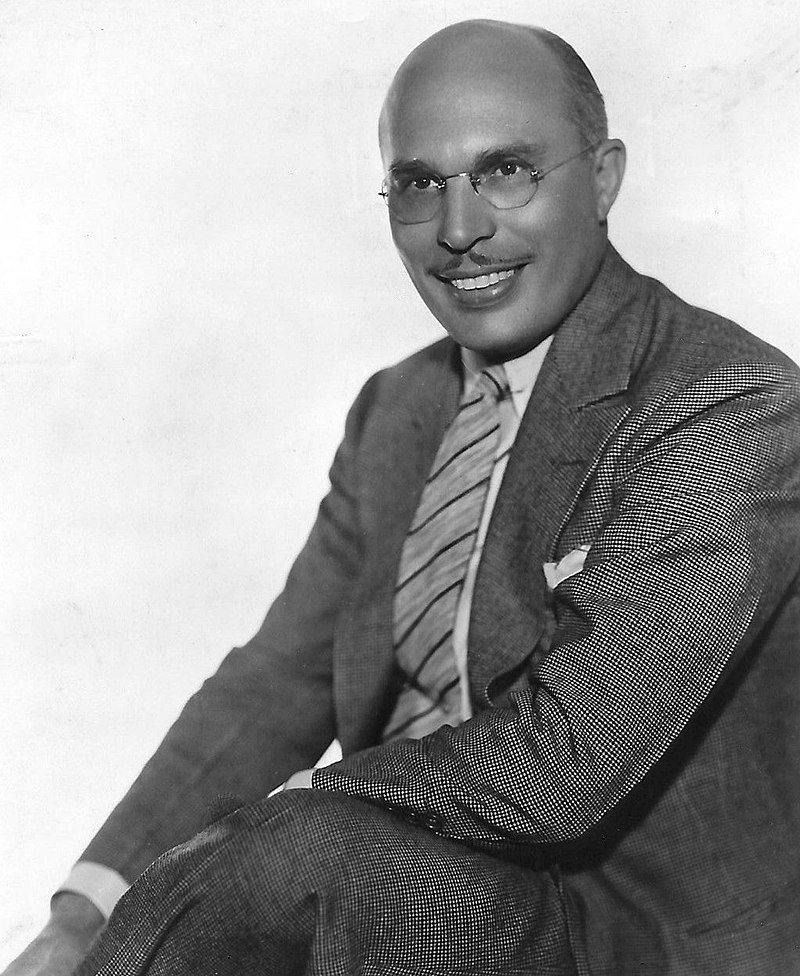
May 15, 1942, was also the Third Annual Twin City High School Fun Nite. Bud Strawn was the popular orchestra leader. Dancers were encouraged to get there early with a “Beat the Clock” promotion.
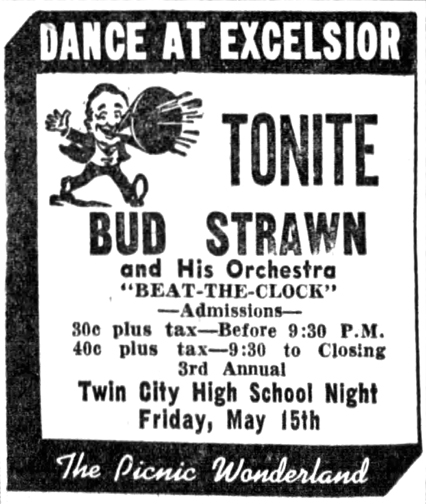
Ace Brigode provided the music for the annual Commencement Dance, June 4, 1942. It was the last day of his two-week engagement.
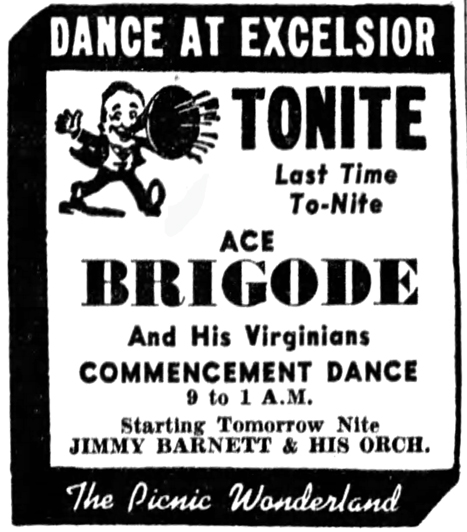
Excelsior Park Ballroom presented Jimmy Barnett and His Orchestra from June 5 to 11, 1942, “Dispensing Dance Rhythm As You Like It.”
Cliff Keyes and His Orchestra began an engagement on June 12, 1942.
Lawrence Welk and His Champagne Music was the featured attraction at the Excelsior Park Ballroom on June 16, 1942. Featured were songstress Jane Walton and Jerry Burke on the electric organ. All for 66 cents! Advance tickets could be obtained at Billy and Marty’s Cigar Store in Minneapolis. (Shopping News, June 11, 1942)
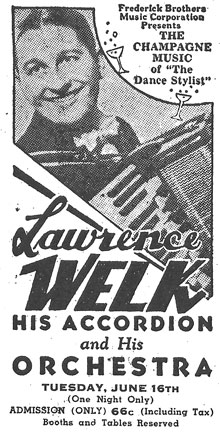
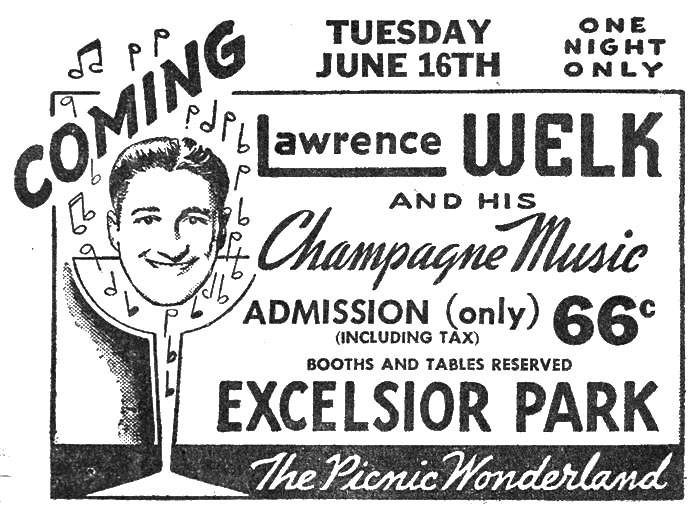
After the Welk show, Cliff Keyes and his orchestra returned for dancing.
JITTERBUG CONTEST
On June 30, 1942, the ballroom held a “boogie woogie contest.” The caption for this photo from the Minneapolis Star reads, “These four jitterbugs practice the stomp on the highway leading to Exxcelsior while deputy sheriff A.X. (Bud) Schall warns them that highway dancing is not permitted. The student dancers chose the wide open spaces to polish up in preparation for the [contest]. They are (left to right) Philip Turgeon, Marlene Ramsey, Neil Schuknecht (with phonograph), Kenny Landgran and Marlynn Swift.
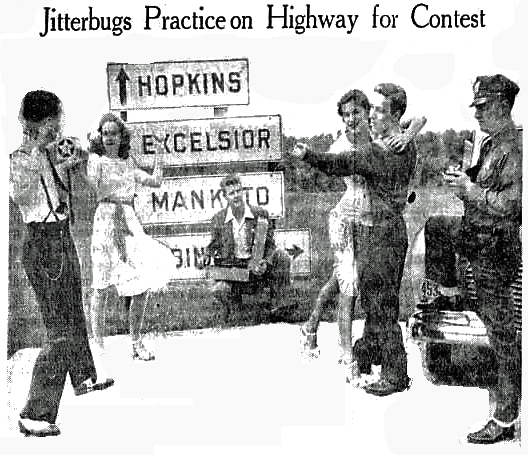
Army-Navy Benefit Day took place on August 20, 1942, with proceeds donated to the Army Emergency Fund and the Navy Relief Society. The day’s festivities ended with an Army-Navy Ball in the Ballroom.
The photos below are undated, but give a wonderful peek inside the ballroom when she was all dressed up – perhaps for a special dance, or for New Year’s Eve?
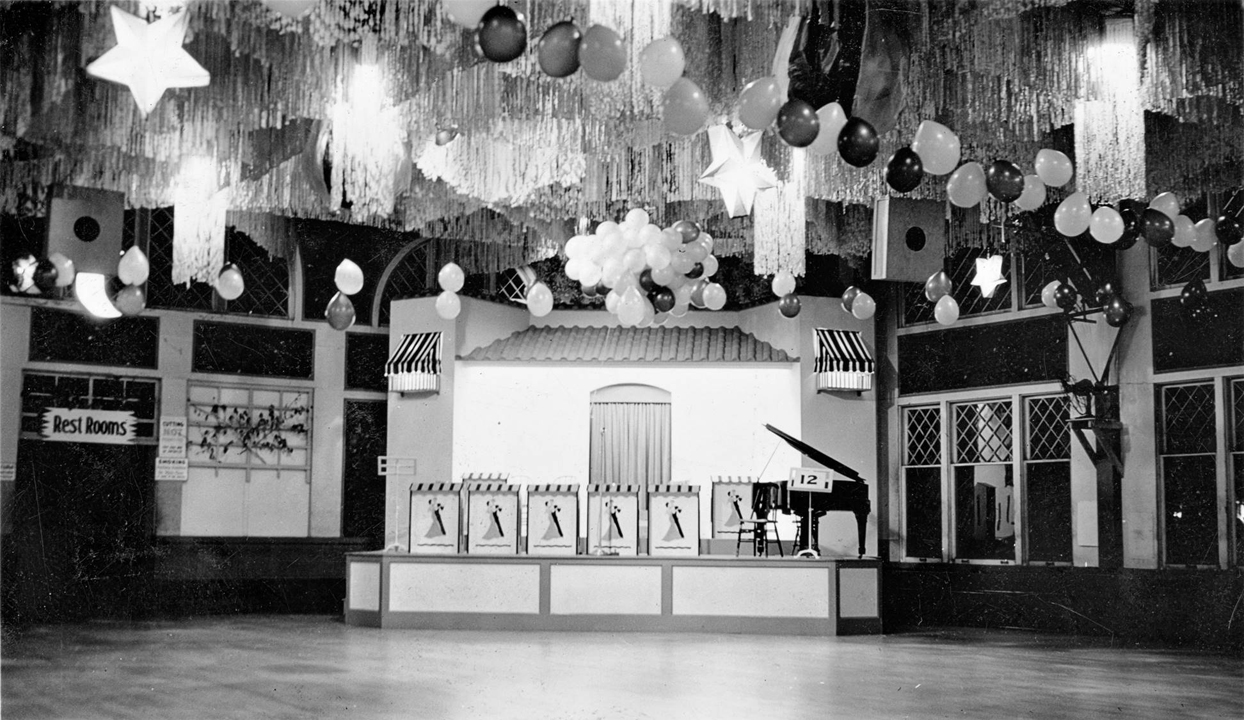
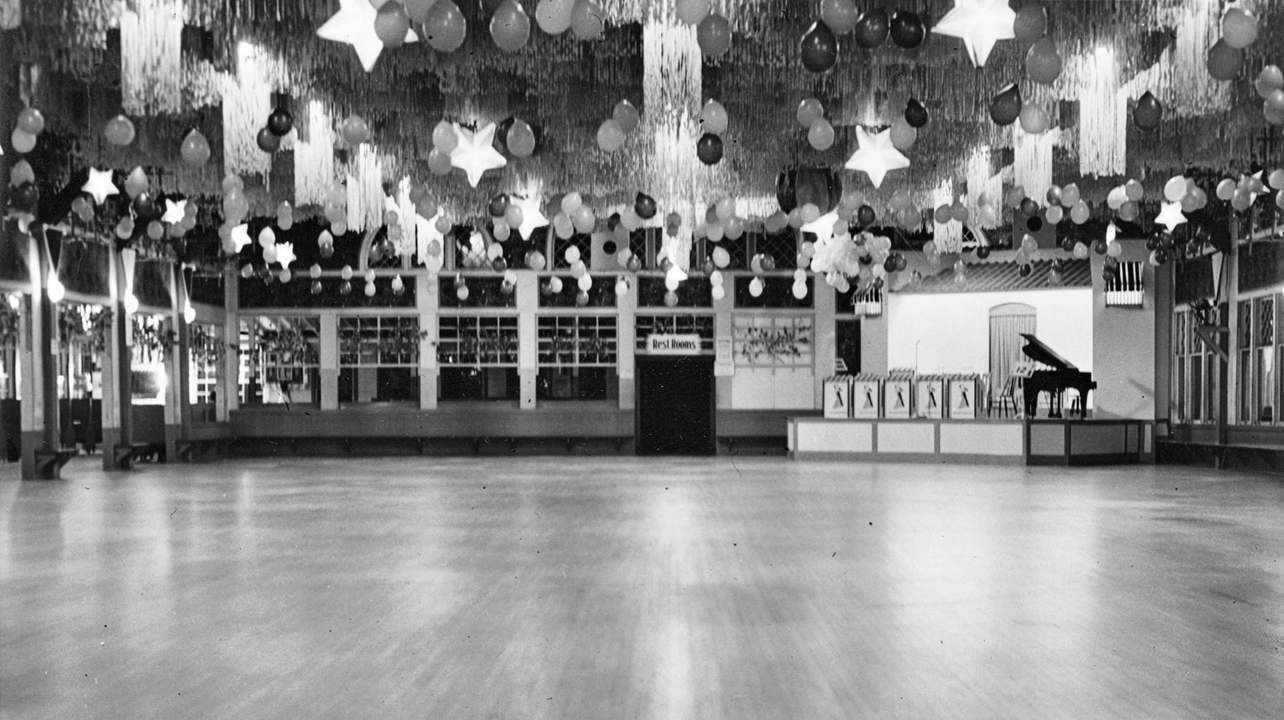
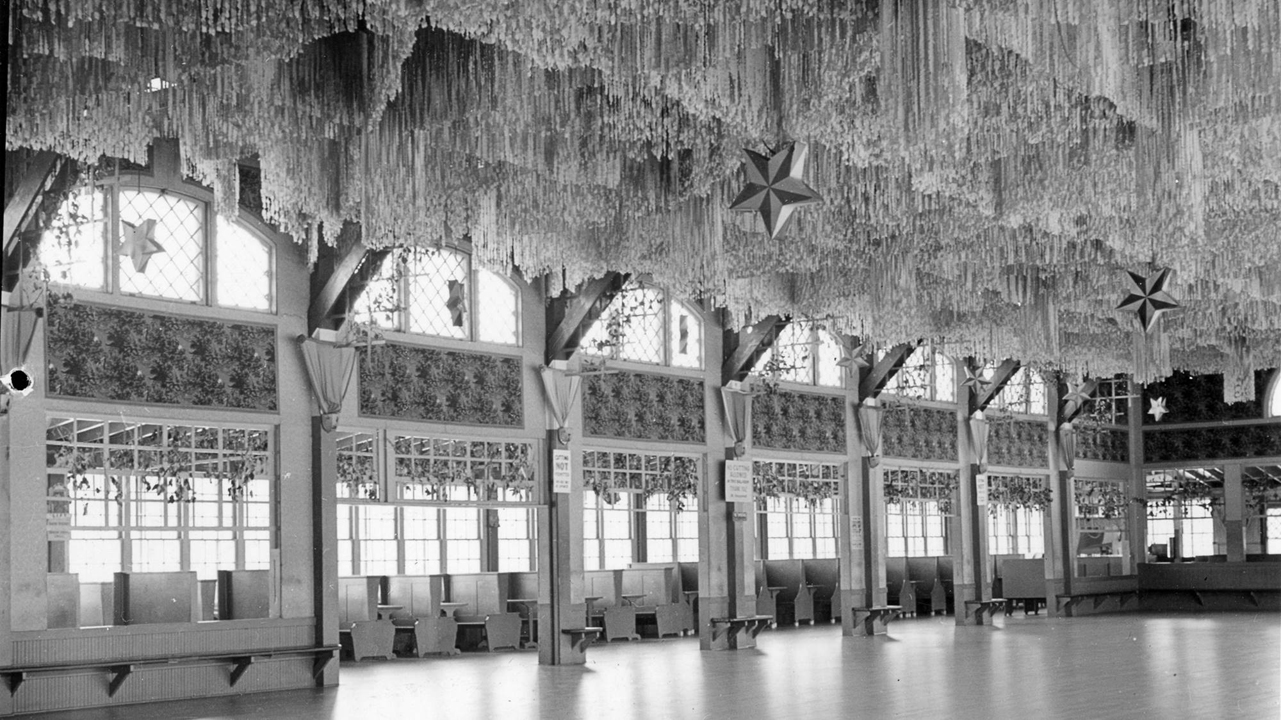
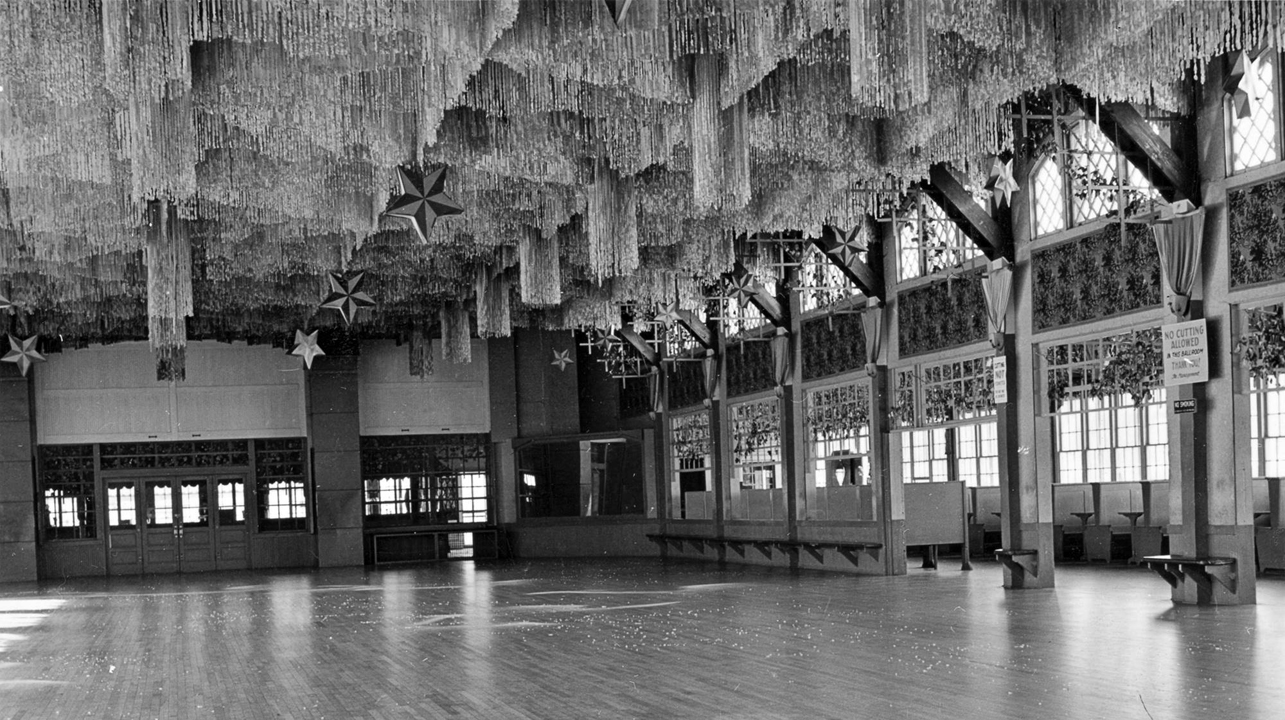
1943
It’s very possible that there was no Twin City Fun Night in 1943. I found no ads, and the numbering seems to bear this out.
The Ballroom instituted a new policy, operating only five nights a week, dark on Mondays and Tuesdays. Poor weather and young men in the service contributed to low attendance. (Billboard, July 10, 1943)
1944
The Excelsior Amusement Park Pre-Season opening All Twin City High School Night was held on Friday, May 12, 1944. The Ballroom hosted Bud Strawn and his (TC Favorite) Orchestra, featuring Betty Jacobson, soloist.
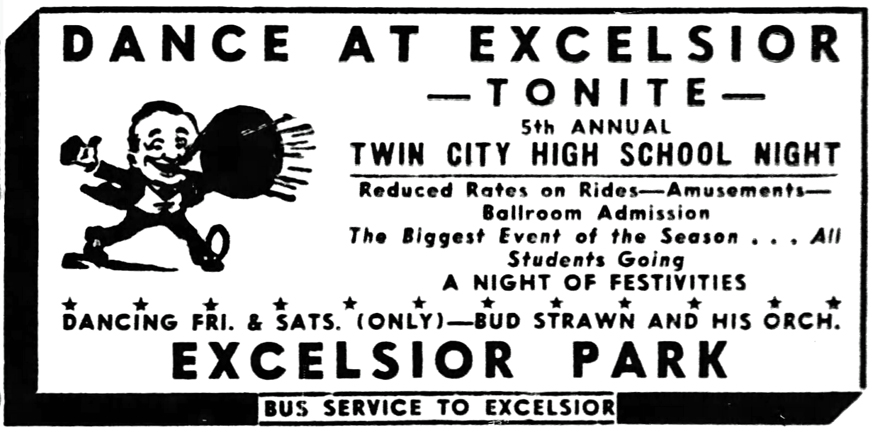
The Ballroom hosted an annual commencement dance on Thursday, June 15, 1944, until 1 am. Bud Strawn’s Orchestra provided the music.
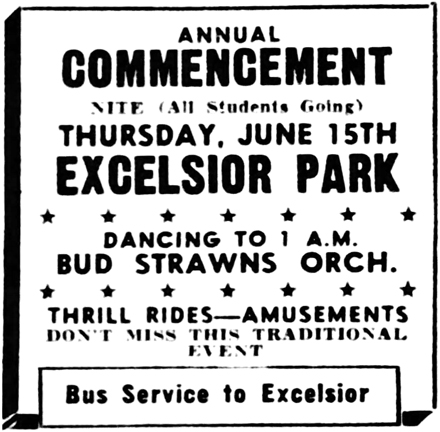
FIGHT!
Poor Rudy Shogran and ballroom employee Clara Munson were arrested for selling beer to a minor as a result of a “rumpus” at the Park on Sunday, June 11, 1944. Here’s the story from the Minneapolis Star:
Deputy Sheriffs Charles Lord and Fred Rosnow went to the park on the report there was a gang fight in progress. They found that a 17-year-old boy, a parolee, had passed out handbills for another dancehall in the ballroom at the park.
At Shogran’s refusal to prosecute, the youth was released.
A crowd of other boys, however, protested to Lord that the youth had been “manhandled.”
One of them, Lord said, who said he was 18, then accused the place of selling beer to minors, and, producing a draft card, allegedly bought a bottle of beer from Mrs. Munson.
Shogran charged that youths attending the dance hall frequently produce faked draft cards to obtain beer.
Charges were dropped against Shogran in justice court after it was shown that he had nothing to do with selling beer. He said that beer was only sold on certain nights when high school youngsters were not there. He also pointed out that underage boys frequently presented fake draft cards in order to buy beer.
Clara Munson plead not guilty and was released without bail Monday. She stood trial before Judge Thomas L. Bergin on June 20, but no report of the outcome was reported in the Strib.
1945
Pre-season openings were held every Friday, Saturday, and Sunday starting on April 20, with Bud Strawn and his Orchestra in the Ballroom on Friday and Saturday nights.
The Annual Twin City High School Night was held on May 11, 1945, where students were invited to jitterbug to Bud Strawn’s Orchestra. In the St. Louis Park Dispatch it was called the Suburban High School Nite.
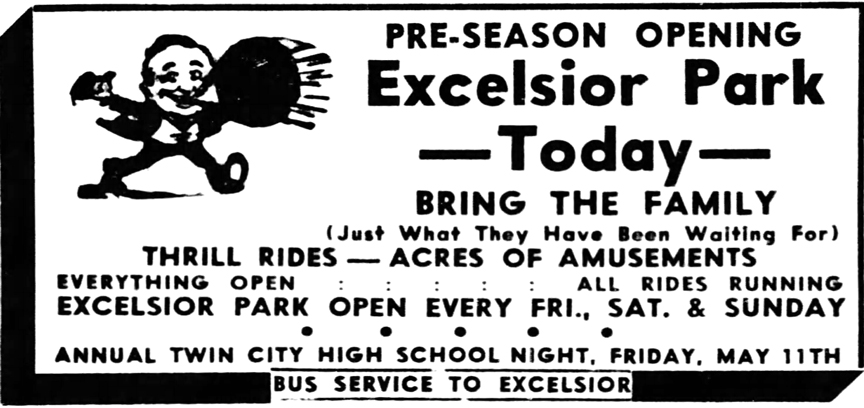
A severe manpower shortage threatened the operation of the Park in 1945, and gas rationing forced the Ballroom to open on Fridays and Saturdays only – Bud Strawn’s Orchestra played the entire year. Good crowds were reported all year.
1946
Twin City High School Nite at Excelsior Amusement Park was May 10, 1946, with music by Bud Strawn and His Orchestra. The Park opened on May 17, 1946.
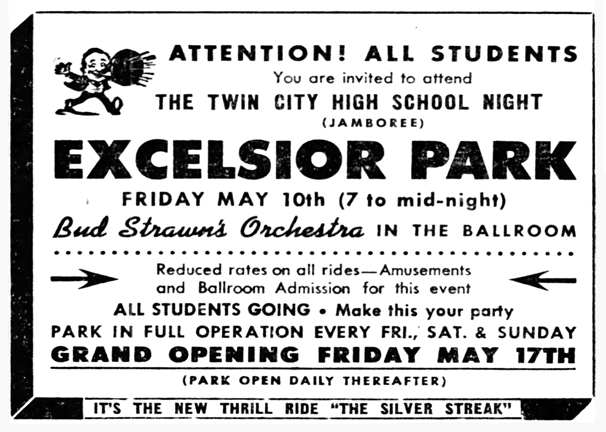
Minnesota had a serious polio outbreak, leading to dramatic drops in attendance at entertainment venues. Billboard reported on August 10, 1946, that an “attendance drop-off was not too noticeable.” But the following week, August 17, Billboard quoted Joe Colihan: “While there is no quarantine on amusements, medical officials have asked children be kept away from crowds on a voluntary basis. As a result our business is way down the last two weeks.”
Curiously, in 1960 Billboard reported that the biggest Labor Day weekend at the Park was in 1946.
1947
Pre-Season openings started on Friday, April 18, with dancing on Fridays and Saturday nights with Bud Strawn and His Orchestra.
Twin City High School Nite at Excelsior Amusement Park was May 9, 1947, with music by Bud Strawn.
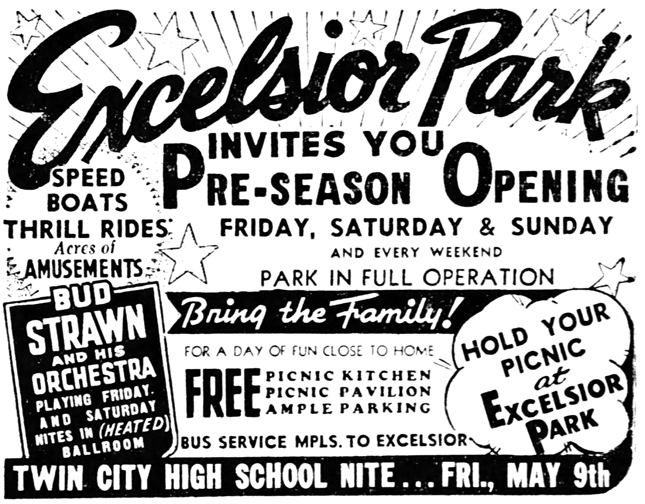
DEATH RIDES COASTER
Such was the headline on August 7, 1947, the day after 21-year-old George Savig plunged 25 feet to his death from the top of the roller coaster at Excelsior Park. He was among a group of three young men and three young women who came to the Park to go dancing. But the Ballroom was closed on this Wednesday, so they went on the roller coaster instead.
George’s seat-mate, Janet Jones of St. Louis Park, described what happened:
We were sitting in the front seat. And I got frightened as we got to the top before that last big dip. I must have leaned forward or screamed or something. I felt his arm around m waist, protecting me. Then the car lurched and he seemed to tumble forward and disappear.
James Hohman, who was sitting behind Savig and Jones, described what he saw:
Just before the dip the car seemed to lurch a little and it appeared as if both George and Janet would go over the front. George seemed to thrust himself forward, as if to pull her back. Then he went over.
Savig, a native of St. Cloud living in Minneapolis, was taken to St. Mary’s hospital, where he died at 10:55 pm. He was pictured on the front page of the Minneapolis Tribune receiving Last Rites from a priest shortly before he died.
His left arm was found the next morning on top of a canopy leading into the Park, 100 feet from the point of impact. His father filed an $11,000 lawsuit against the Park, but the Hennepin County coroner had ruled the death an accident two days after it happened. Park officials said that it was impossible to get out of a seat without standing up. It was the first such accident in 23 years of operation.
If only the Ballroom had been open …
1948
Excelsior Park held its annual Twin City High School Night on April 14, 1948, featuring Bud Strawn and His Orchestra.
Pre-season openings:
- April 24 and 25: Bud Strawn
- April 30, May 1 and 2: Phil Lavant and His Orchestra
- May 7-9: Bud Strawn
- May 14-16: Bud Strawn
The Grand Opening of the Park was on Friday, May 21, 1948. Dancing was offered nightly after the 21st.
Cedric Adams began broadcasting two radio shows, including “Stairway to Stardom” from the picnic pavilion. The pavilion stage was quadrupled in size and a radio control room was installed.
1949
The annual Excelsior Park Pre-Season Suburban High School Dance was held on April 13, 1949, with Bud Strawn’s (new) Orchestra.
Bud Strawn’s 11-piece orchestra played at the Ballroom for its sixth consecutive year.
For the second year, WCCO held Saturday night broadcasts from the Park’s picnic pavilion. Starting with Cedric Adams’s “Stairway to Stardom” show, five half hour shows were broadcast. (Billboard, June 25, 1949) WCCO personalities featured on the show also included Bob DeHaven, Sally Foster, Clellan Card, vocalist Tony Grise, Ramona Gerhard on the Hammond organ, and Wally Olsen’s orchestra.
1950
The Twin City High School Fun Night (now called the Jamboree) was held on May 12, 1950, with Bud Strawn’s Orchestra.
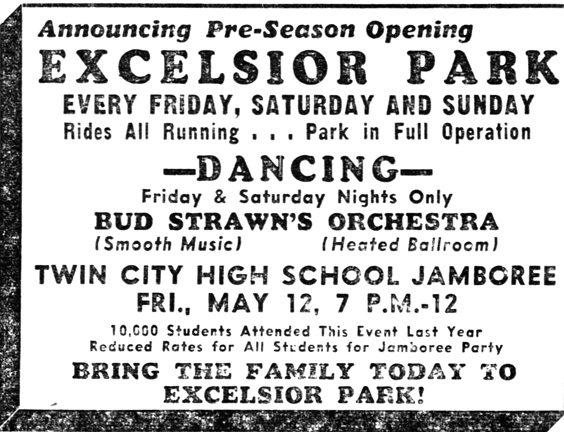
The Park’s attendance was only slightly affected by the scourge of polio, which had shifted its focus from infants to children aged five to nine.
1951
Excelsior Amusement Park had its annual Pre-Season Opening April 20-21, 1951. Dancing (in heated ballroom) Friday and Saturday nights featured Steve Dunning and his Dance Stylists. The April 10 St. Louis Park High Echo included an ad for the event, billed as the Annual Twin City and Suburban High School Jamboree: “10,000 Students attended the Jamboree last year – Don’t miss this annual event – All Students Going”
1952
Excelsior Amusement Park had its Pre-Season Opening starting on April 25, 1952. Dancing (in heated ballroom) Friday and Saturday nights featured Les Williams and His Music From Paradise. This 11-piece band was booked for the season. Loraye Garis was the “ork canary.” (Billboard, May 10, 1952)
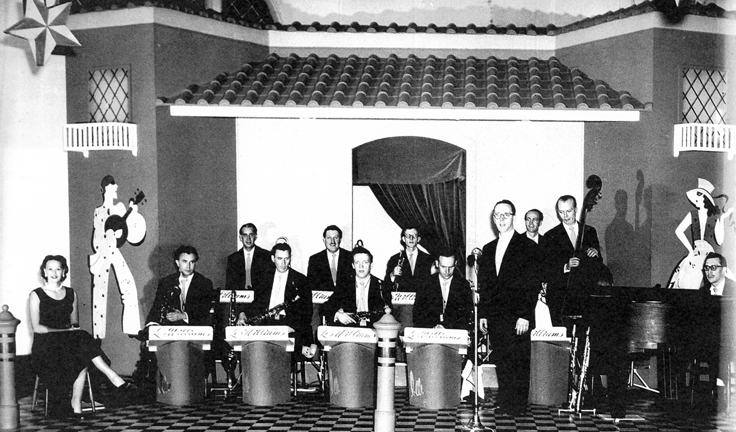
The April 22, 1952, St. Louis Park High Echo included an ad for the Annual Twin City and Suburban High School Jamboree, which took place on May 9: “10,000 Students attended the Jamboree last year – Don’t miss this annual event – All Students Going”
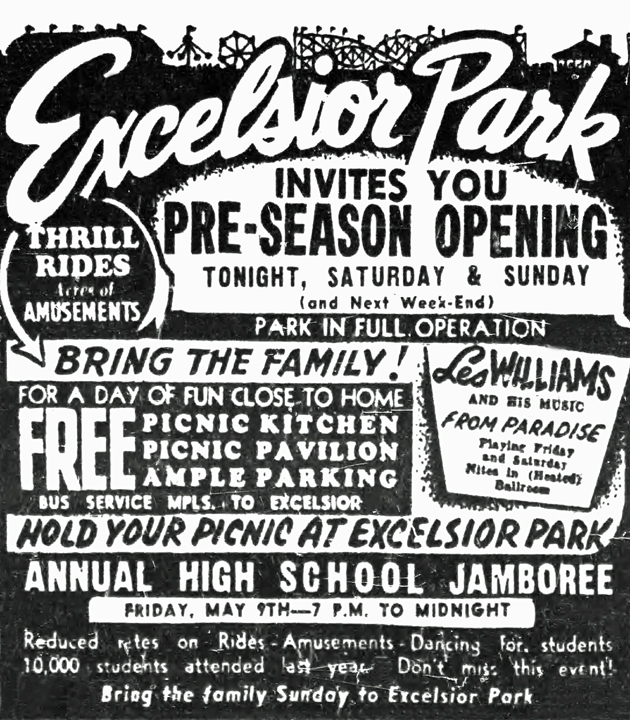
WCCO carried weekly broadcasts from the Park all summer, from the picnic pavilion.
1953
Pre-opening for 1953 was on April 12. The regular opening on Memorial Day drew 10,000 visitors, and July 4’s estimated attendance was 13,000.
The Twin City High School Night took place on May 8, 1953, with Chuck Eddy providing the music. This was described as Shogran’s pet promotion, and this year it drew 14,000 graduating seniors.
For the first time in at least a decade, the Park resumed booking big name orchestras into the Ballroom in 1953. Joe Colihan worked out a deal with the owners of the Prom Ballroom
- May 27: Stan Kenton appeared with his 22 piece band
- July 17: Ralph Flanagan
- July 25: Frankie Carle, his piano and orchestra
- August 7: Jan Garber and his Celebrated Orchestra – “The Idol of Airlanes”
- August 14: Frankie Yankovic, His Accordion and Recording Orchestra
The house band in 1953 was Dick Kast’s 11-piece orchestra.
Bud Strawn, who led the Ballroom orchestra for 15 years, died on December 6, 1953. He had a heart attack and died at the age of 39. Vernon H. Strawn had retired from music to devote full time to his tax accounting work. He was a graduate of Edison High in Minneapolis and the University of Minnesota.
1954
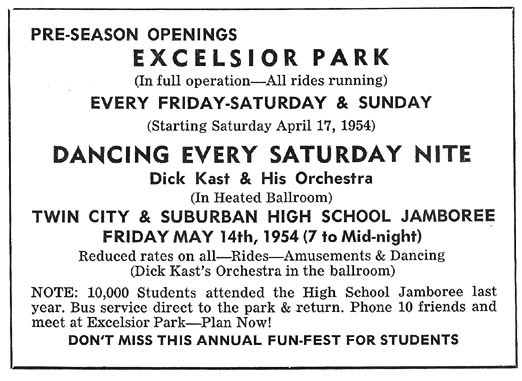
The Twin City High School Jamboree took place on May 14, 1954, featuring the very popular Dick Kast and his Orchestra.
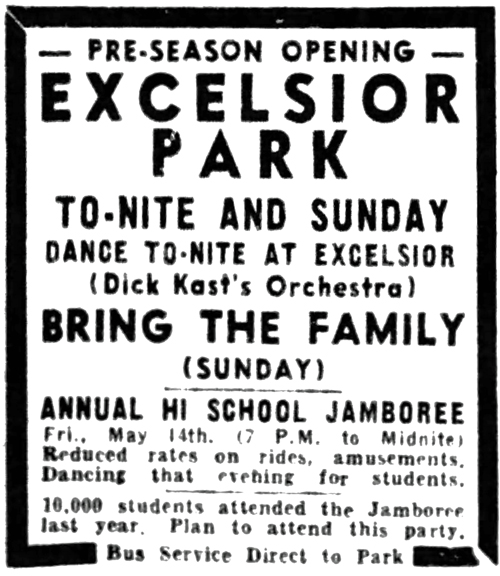
In July 1954, Hopalong Cassidy made a two-day visit to the Park. The cover of the July 9 issue of TV Guide was your ticket for two people, and included free ride tickets.
One of many promotional days – sponsored by WMIN-TV, which shared time with WTCN on Channel 11 in those days. Ranger Steve was Steve Cannon, Captain 11 was Jim Lange (later of the Dating Game), and Casey Jones was the most popular guy in town!
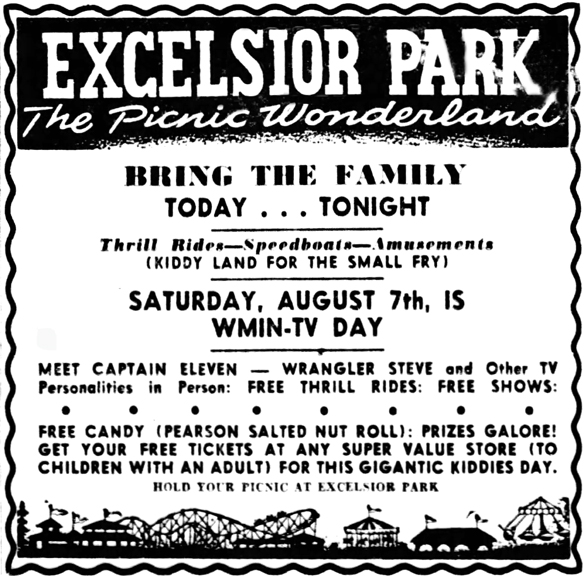
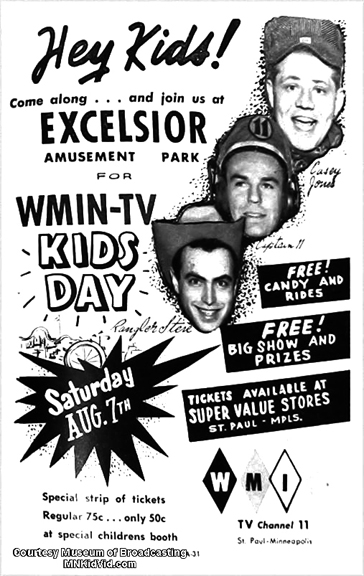
1955
The 15th annual Excelsior Amusement Park Teenage Jamboree was held on May 13, 1955. Entertainment was by Dick Kast’s Orchestra.
Disneyland opened on July 17, 1955, creating a new model for amusement parks around the country.
1956
Excelsior Amusement Park held its annual Teenage Jamboree on May 11, 1956. Entertainment was by Chuck Eddy’s Orchestra.
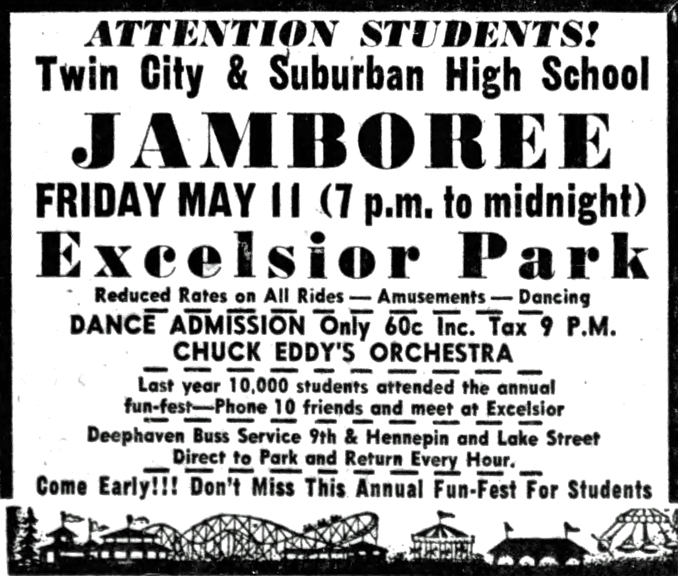
This was the last year that the Ballroom hosted regular dances until it was reopened as Big Reggie’s Danceland in 1961.
1957
Rudy Shogran died on April 8, 1957, of a heart attack. He was 64. Shogran was born in Duluth and had served in World War I. He was a member of the American Legion, and active in the annual mayor’s day activities during the Aquatennial. He had been Director of Public Relations, in charge of promotions at the Park, for almost 28 years. He was also in charge of booking the ballroom. He was survived by hiss wife, Florence, and two sisters, Mrs. Ebba Hess and Mrs. Violet Edwards, both of Canoga Park, California. Al Anderson, a classmate of Ray Colihan, remembers that “Rudy was virtually a chain smoker of some no-name brand that cost 10 cents a pack (vs 15 cents for Camels, etc.).
Ray Colihan was named to take over promotions at the Park, including the Miss Minnesota pageant (see below).
The Excelsior Amusement Park’s 1957 Twin City and Suburban High School Night, held on May 10, featured Dick Davis’s Orchestra.
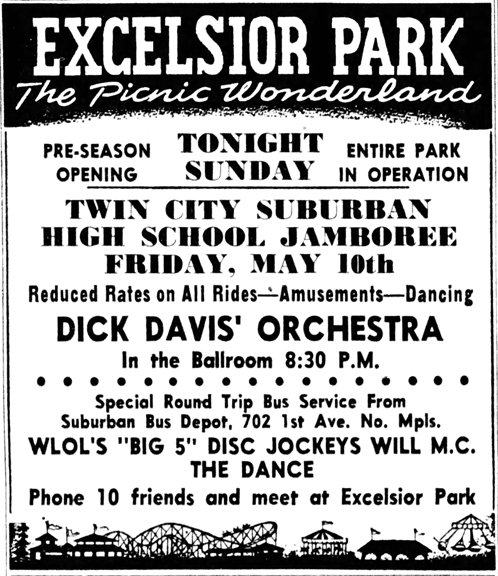
Although the music was provided by an orchestra, WLOL was playing early Top 40 at the time. Among the “Big 5” disc jockeys were Leigh Kamman and Steve Cannon.
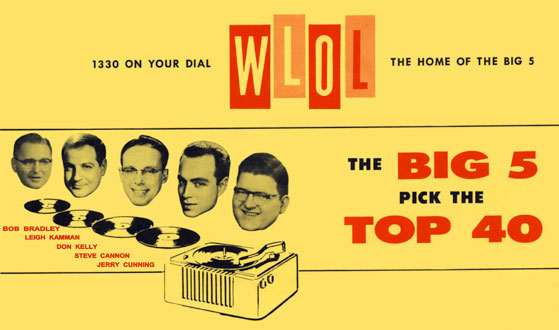
The Ballroom remained dark since 1957 except for occasional rentals.
1958
The Twin City and Suburban High School Jamboree took place on May 9, 1958. Dick Kast’s Orchestra provided the music in the ballroom.
Otherwise, according to Will Jones, the Ballroom was “dark” except for occasional rentals. A Minnetonka Centennial Series article from May 15, 1958, mentions the big bands of the past, but does not include any information about the Ballroom at the time.
One of the special shows held at the ballroom was a Record Hop on August 1, 1958, hosted by WDGY DJ Bill Diehl and WCCO DJ Jim EDDY. The Rock group the Hi-Lites provided live music. This must have been one of the earliest of Diehl’s many such hops that he attended over the years.
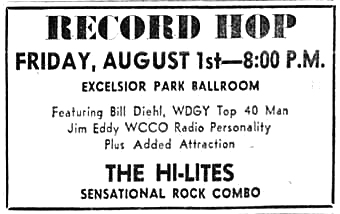
Ray Colihan booked the Dukes of Dixieland jazz combo for August 18, 1958, and they played to a capacity crowd. The group had just come from a 10-day stint at the Illinois State Fair. The seven-piece group was made up of a father, his two sons, “plus four other Dixie lads.” The group was a smash hit.
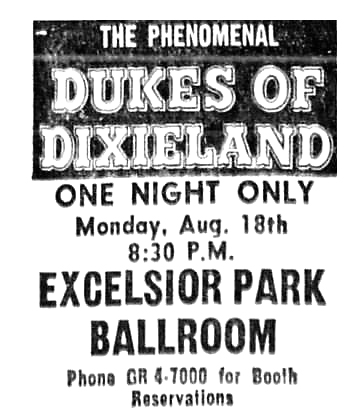
The Dukes made a return appearance in the Ballroom on Wednesday, October 22, 1958. This time they were on a break between night club dates in Milwaukee and Chicago. 250 reservations had been made before the formal announcement of the date.
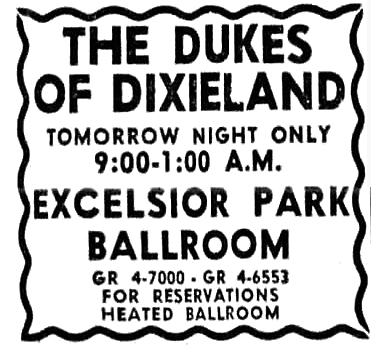
In January 1959, Colihan tried to book the Dukes for another appearance for the coming May. However, the group had become very popular nationally, due to appearances on Your Hit Parade and The Timex Jazz Show. As a result their fee had doubled, and Colihan figured he’d have to raise ticket prices from $1.85 to $2.50 just to break even. No evidence that they ever came back.
1959
Excelsior Amusement Park held its 20th annual Twin City & Suburban High School Jamboree on May 8, 1959. “10,000 students attended last year.” They said that every year.
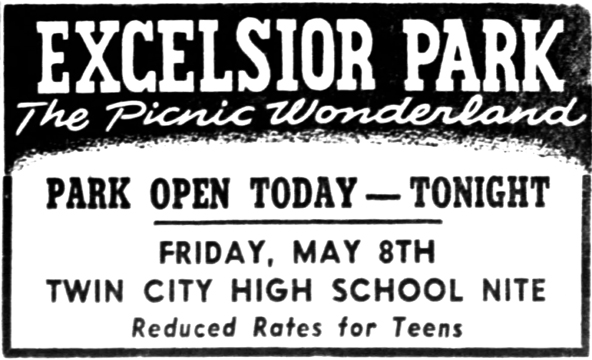
Otherwise, according to Will Jones, the Ballroom was “dark” except for occasional rentals. An item in June 1959 indicated that Colihan was always on the lookout for name acts to bring to the ballroom, but their fees were too high. He usually offered 60 percent of the gate, but acts like Red Nichols and his Five Pennies wanted a guarantee of $1,000, and Louis Armstrong wanted as much as $2,000.
Fred Pearce, Sr. died on August 13, 1959, of a heart attack in suburban Detroit.
In a portent of things to come, in the winter of 1959-1960, the ballroom was used for boat storage by the Excelsior Boat Works.
1960
Ray Colihan became a local personality, as evidence by placement in Will Jones’s “After Last Night” column in the Tribune. Here’s a joke from February 19, 1960. Okay, it’s sexist and may not even be true, but all publicity is good publicity, right?
Ray Colihan, who busies himself summers with running Excelsior Amusement park, busied himself this winter trying to collect a long-standing loan from a crony of his bachelor days. Finally he had an idea. He attached a snapshot of his infant daughter to the note requesting payment and added, “This is why I need the money.” He got back another picture – of a gal in a skimpy bikini – and the playboy’s response: “This is the reason I can’t pay.”
The annual Excelsior Park High School Jamboree took place on May 13, 1960. The ad in the SLP Echo did not name the entertainment.
Otherwise, according to Will Jones, the Ballroom was “dark” except for occasional rentals.
Billboard reported that 1960’s Labor Day was the second largest in the Park’s history, second only to 1946. (Billboard, September 19, 1960)
1961
May 13, 1961: The annual Twin City High School Jamboree took place at Big Reggie’s. National artist (and Twin Cities favorite) Brian Hyland performed at a dance and stage show, and local favorite Mike Waggoner and the Bops provided dance music from 8:30 to 11:30.

BIG REGGIE’S DANCELAND
On May 23, 1961, Will Jones tells us that the Ballroom,
dark since 1957 except for occasional rentals, will go into action again this weekend under a new name: Big Reggie’s Danceland. There will be teen-age hops on Fridays and adult-slanted dance sessions on Saturdays. The old lobby is being turned into a piano bar and 3.2 tavern for every-night use, and on Sundays small jazz combos will be featured in that room.” The piano bar was called the “Swingalong Room.
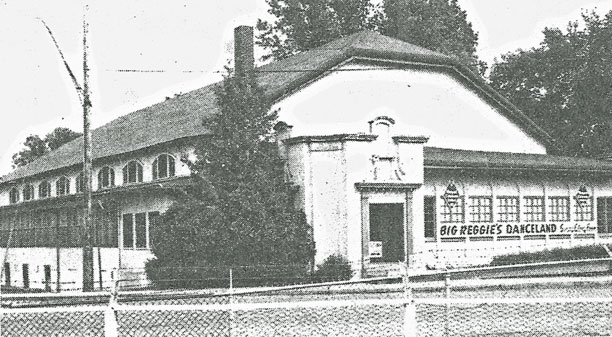
This photo is not so good but it has the Big Reggie’s sign on it.
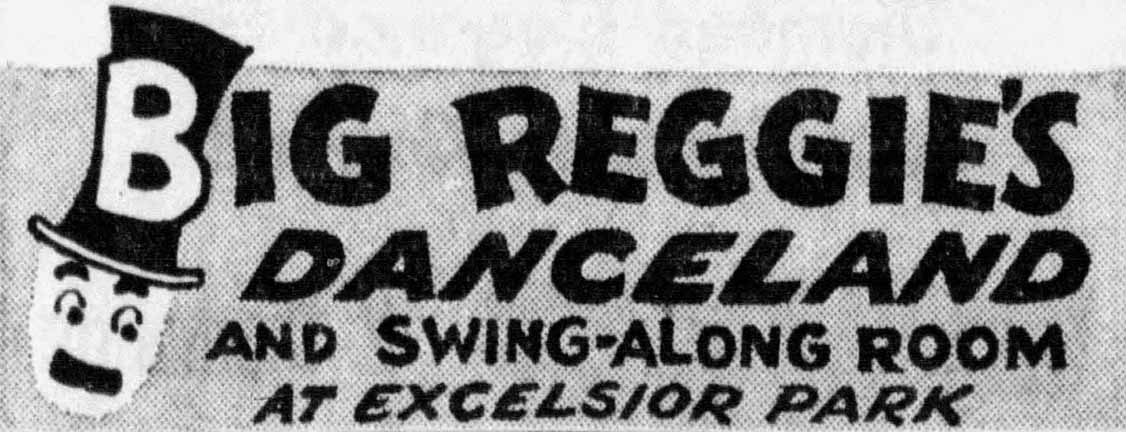
Friday, May 26, 1961: Wayne Turssso and the Velvetones – Teen-agers only!
Saturday, May 27, 1961: Al Noyce Orchestra in the Ballroom; the Les Friedl Combo in the Swingalong Room
Sunday, May 28, 1961: Rusty and Doug (Doug Kershaw) entertained at a Teen Dance in the ballroom. This was also the first weekend appearance of the Dixieland Ramblers in the Swingalong Room. The Dixieland Ramblers, a sextet from Edina, was led by drummer Tom Stevenson. It was stressed that this was no ordinary Dixieland, but a swinging, driving Dixie patterned after the Dukes of Dixieland.
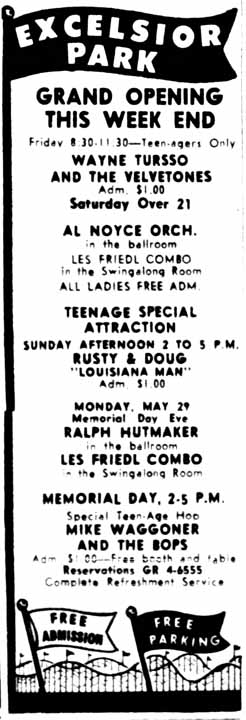
Monday, May 29, 1961: Ralph Hutmaker in the Ballroom; the Les Friedl Combo in the Swingalong Room. Mike Waggoner and the Bops hosted a teen dance in the afternoon.
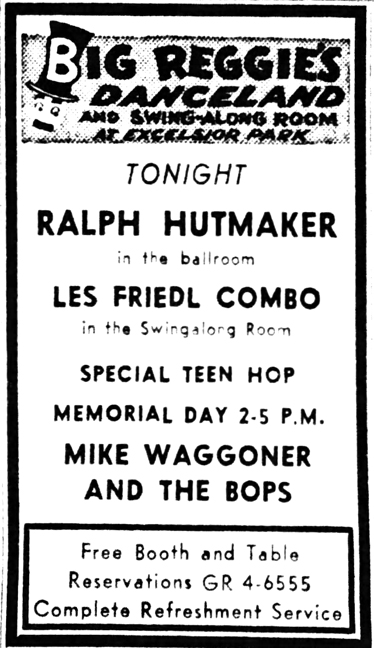
Saturday, June 10, 1961: Al Noyce in the ballroom; Les Friedl in the Swingalong Room
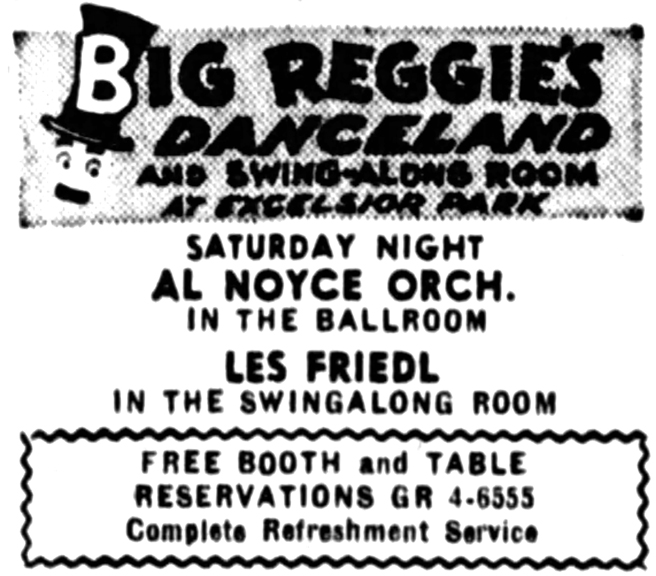
Friday, June 16, 1961: Teen Hop with Mike Waggoner and the Bops
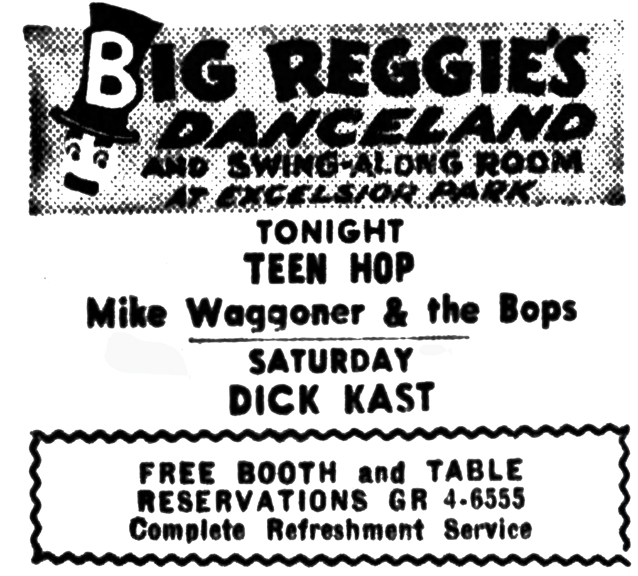
Saturday, June 17, 1961: Dick Kast in the ballroom; Les Friedel in the Swingalong Room
Friday, June 23, 1961: Teen Hop with Mike Waggoner and the Bops
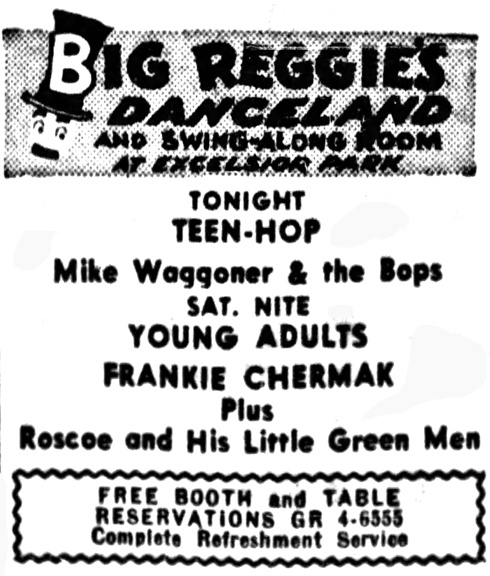
Saturday, June 24, 1961: Frankie Chermak (Dixieland), plus Roscoe and his Little Green Men
Saturday and Sunday, July 15 and 16, 1961: The Dixieland Ramblers. An item dated July 18 says that the Dixieland Ramblers were booked in the Swingalong Room for Saturday and Sunday nights for the rest of the summer.
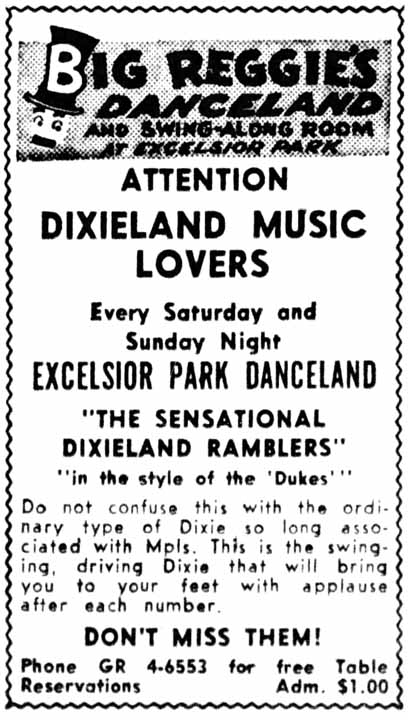
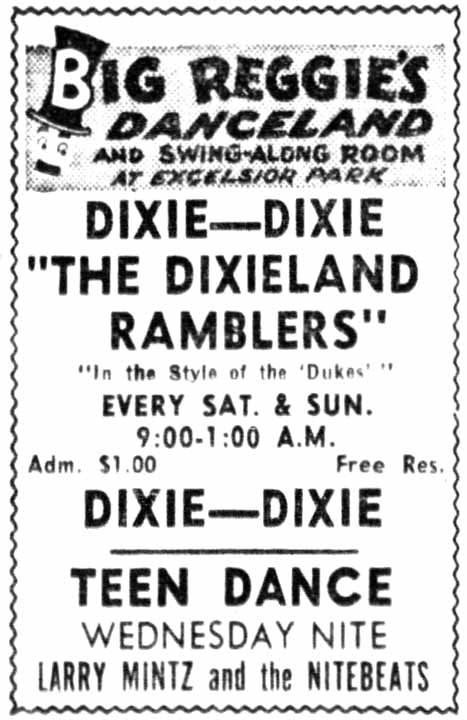
Wednesday, July 19, 1961: Larry Mintz and the Nitebeats in the ballroom.
On August 1, 1961, the law changed regarding “bottle clubs” – places where it was legal for patrons to bring their own alcohol. The law now forbade licensed dance halls to also have bottle club permits. Bottle club permits were ordered returned from a long list of ballrooms in Minnesota, including Danceland.
On August 20, 1961, Roscoe and his Little Green Men made a return to Danceland after a stint at the Torch Club.
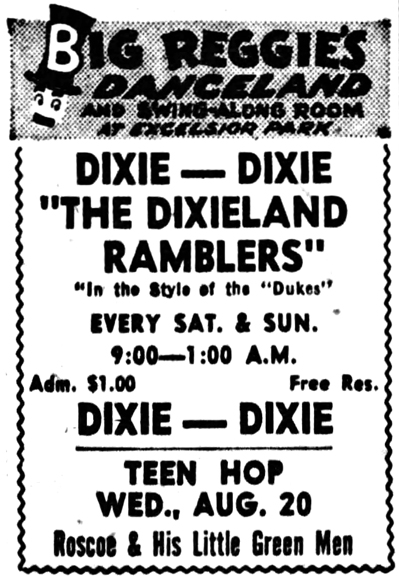
Friday, October 6, 1961: Garry Miles and the Casuals
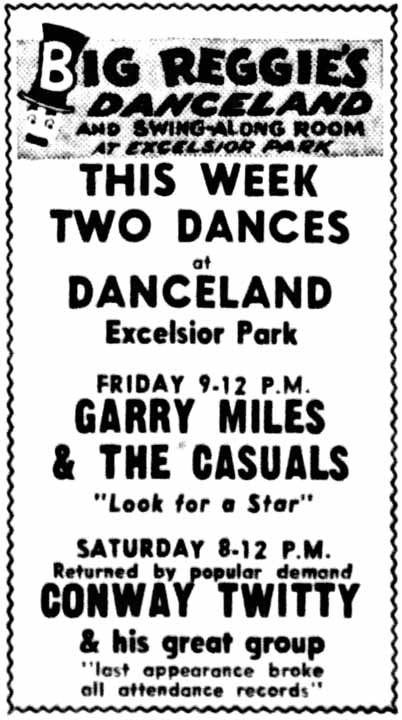
Saturday, October 7, 1961: Conway Twitty. This was Twitty’s second appearance at Danceland in 1961, but so far we can’t find the date of the first one.
Joe Colihan died on October 12, 1961, at age 65.
1962
*Please Note: Despite what you may have read, the Beach Boys were at Danceland in 1963, not 1962. Big Reggie was prescient, but not that prescient.
WDGY High School Fun Day and Night took place on May 12, 1962. This annual event drew an estimated 8,000 high school students from around the area. The fun-filled day featured:
- Dancing from noon to five to Mike Waggoner and the Bops and the Doradoes
- A Twist Contest (you could not escape the Twist in 1962)
- A Saturday night Battle of the Bands, featuring the Ricochets and the Doradoes
- Three WDGY Disk Jockeys tried to break the world’s DJ Roller Coaster Record of 47 rides. DJ Terry Rose took 70 consecutive rides, which took three hours and 21 minutes. During the course of this feat he ate three hot dogs, and lost both his tie clip and seven pounds. “Tired, bruised and exhausted after his 35 mile ride, Rose said ‘I don’t care if I never see another roller coaster.’” (Minneapolis Daily Herald, May 23, 1962)

Teen dances were featured at Danceland every Friday and Saturday night.
May 30, 1962, was Memorial Day and a huge day at Danceland! A show costing a mere $1.85 presented:
- Del Shannon
- Brian Hyland
- The Belmonts
- Jamie Coe (“Cleopatra”)
- Kenny Chandler (“It Might Have Been”)
- The Gigolos (“Bambina”)
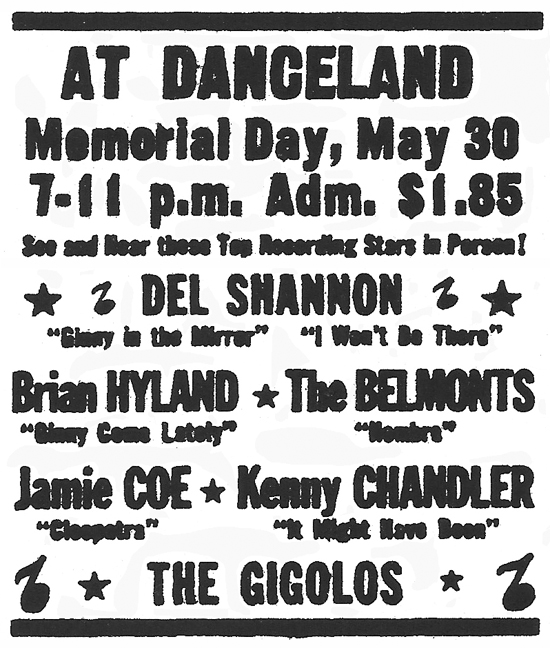
In June 1962, Excelsior was the scene of a four day “Jazz-Arts Festival” at the Minnetonka Center of Arts. One of the highlights was entertainment by teenagers in the Minnetonka area, including a twist contest won by Pam Witcher and Tom Punch. Doc Evans’ Dixieland band provided the music. The Minneapolis Daily Herald, which was picking up the slack during the Star and Tribune strike, featured kids doing the twist and the mashed potato at Excelsior Park. Barbara Linow (?) sang with Tom Sechrest’s band.
July 4, 1962, entertainment included a “free, outdoor Twistathon. Qualifying rounds will start at 2:30 in the afternoon and the finals will be at 7 pm on the Fourth of July. Cash prizes will be awarded to the winners.” Twist music provided by the Champs (“Tequila,” – which was actually recorded by Glen Campbell). Bill Diehl was the Twistmaster. Okay, it says MC. This event took place at the picnic pavilion and not in Danceland.
Friday, August 10, 1962: The Doradoes
Saturday, August 11, 1962: The Champs
Tuesday, August 14, 1962: Mike Waggoner and the Bops

The next ad found was dated August 17, 1962. Dance dates were:
Friday, August 17, 1962: The Dorados (what’s spelling got to do with it?)
Saturday, August 18, 1962: Roscoe and his Little Green Men
Tuesday, August 21, 1962: The Corvettes

WDGY was back on Sunday, September 9, 1962, for a Back to School Fun Day, words that do not go together. Within the hours of 1 to 3 pm, they promised:
- Battle of the Bands, with the Corvets, Mike Waggoner, and the Doradoes
- Free Rides
- Contests and prizes galore, including Grand Prize Drawing
- The Weegee Wagon, compliments of Brady Olds, St. Paul
- All the Weegee personalities:
- Terry Rose
- T. Thomas Wynn
- Bill Diehl
- Paul Johnson
- Perry St. John

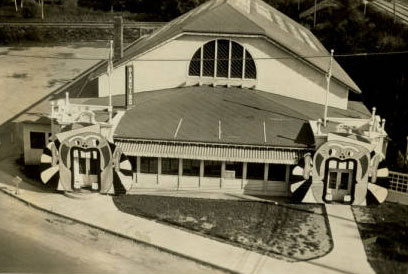
1963
THE BEACH BOYS AT DANCELAND
Twin City High School Night for 1963 was on Friday, May 3. And it was a doozy!
In February 1963, Colihan booked the Beach Boys to perform for that year’s Twin Cities High School show and dance, reportedly for only $400. At the time they were booked, the group had charted four records on the Billboard charts, notably “Surfin’ Safari,” which entered the chart in August 1962 and reached #14, but they hadn’t had any top 10 hits. Then, on March 23, 1963, “Surfin’ USA” entered the chart, a monster hit eventually reaching #3. So by May 3, 1963, they were BIG, and Colihan had scored a real coup.
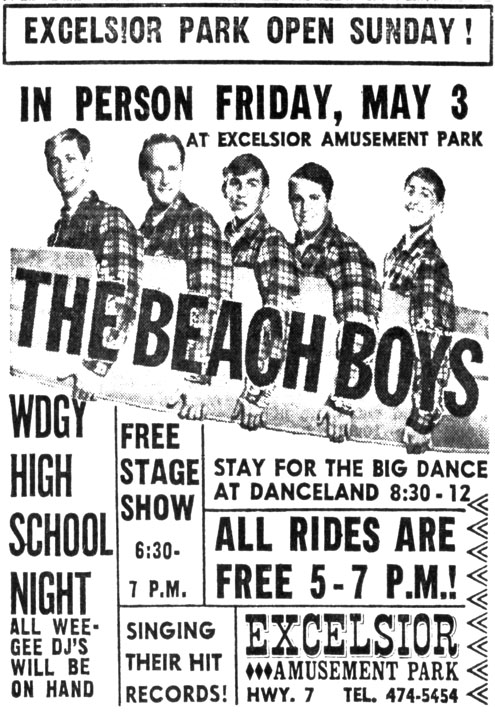
The Minnetonka Record predicted:
Thousands and thousands of teenagers from the metropolitan area and suburbs will attend the annual Twin City High School Night at Excelsior Amusement Park and Danceland on Friday, May 3. The special night for high school students will be the twenty-fourth annual event held at Excelsior Amusement Park and there will be free rides, special entertainment, reduced ride rates and dancing during the full evening’s program.
Feature of the evening will be the appearance of the popular top 40 recording stars, The Beach Boys, direct from California. They will headline a free stage show on the outdoor stage of the amusement part from 6:30 to 7 pm Friday. Then they will play for dancing in Danceland starting at 8:30 pm.
The amusement park will throw all rides open free to the high school students between 5 and 7 pm and there will be reduced rates throughout the rest of the evening.
Last year, over 8,000 students from the metropolitan and suburban area attended the annual high school night event at Excelsior Park…
The problem was that thousands and thousands of kids DID show up, jamming Highway 7 for miles around. Colihan was afraid the enthusiastic teens would tear down the roller coaster. As it was they were tearing out the screens and crawling in the windows of Danceland. Police and firemen were called in to control the chaos.
In 1974 Reggie remembered the chaos in an interview in the Insider:
The night the Beach Boys were there, the kids blocked the whole street off. The cops called the fire truck and they were going to turn the hose on them. The kids weren’t doing anything, just standing ’round. They wanted to get as close as they could to the door to hear the music, ya know it was packed inside. So I blocked the street off and let them stand there. One cop wanted to get them off the street so he called the fire chief to come down. I told the chief that the cop wanted to turn the hose on the kids. The chief said, “turn the hose on those kids?” and I was laughing already. I said if you turn the hose on those kids they’ll take their shirts off and will romp ’round and probably turn this fire truck over, and I don’t blame them. With that, the chief said “I ain’t going to have this fire truck turned over,” so he backed it out with the siren blazing and that was the end of it.
In an interview with the Tribune’s Michael Anthony (August 8, 1976), Mike Love remembered:
We cruised into Minneapolis, circling the belt line, I think they call it. I think we went around the city twice before we found the place. We were in a station wagon with a little trailer behind it. Six guys: the band and a road manager
Brian and I walked outside the ballroom after the first set – we did four that night – and people were still coming in. The place was sold out and people were breaking the windows trying to get in. And there was a line of cars going about two miles down the road.
I remember thinking, ‘Gee, this must be what it was like for Elvis Presley.’ We had never seen that many people before.
One local legend is that Al Jardine, the Boys’ bass player, had somehow forgotten his bass, and Colihan played bass, so he rented his instrument to them for the show. Believe it – or not.
The citizenry, of course, was outraged, presenting a petition of 30 names to the Village Council asking it to take strong action to halt large “uncontrolled crowds causing disturbances in the village.” The petition charged that “unprecedented numbers of teen-agers brought to the park by a special dance promotion was clearly out of control of the park and village police.” The Mayor and Village Manager met with Colihan to discuss the matter, and they agreed that the crowd was simply more than the park management had expected.
ROUTE 66 IN MINNEAPOLIS
The cast and crew of the hip show Route 66 came to town in July 1963 to film three episodes in Minneapolis. By this time Tod Stiles’ (Martin Milner) original traveling companion, Buz Murdock (George Maharis) has been replaced by Lincoln Case (Glenn Corbett) because Maharis came down with hepatitis. Will Jones reported that the filming took a crew of 60, plus 15 or 20 wives and a couple of dozen children of crew members who travel with the show during the summer. Filming the three hour-long episodes was expected to take about a month. The whole crew stayed free at the Sheraton-Ritz, which was a prominent locale for the first episode.
On July 25, 1963, the Minnetonka Record reported that the crew had been to Parade Stadium and in Excelsior the week before. On August 1 the Record reported that hundreds of onlookers crowded the Excelsior shoreline last week to watch the cast and crew work at the Amusement Park and the Mark Knowlton home in Excelsior. More scenes were being taken at a Hopkins raspberry farm, it reported.
The episode that was filmed in Excelsior was:
- “And Make Thunder His Tribute,” aired November 1, 1963. Tod and Linc find work with an eccentric farmer. He is at odds with his son about using any new farming ideas and actually uses a shotgun for noise to scare birds away from his crop. The son and he escalate the battle between them over the possible use of the farm as the site of a motel.
A tiny notice in the Minneapolis Tribune tells us that the Everly Brothers came to Danceland on July 21, 1963!
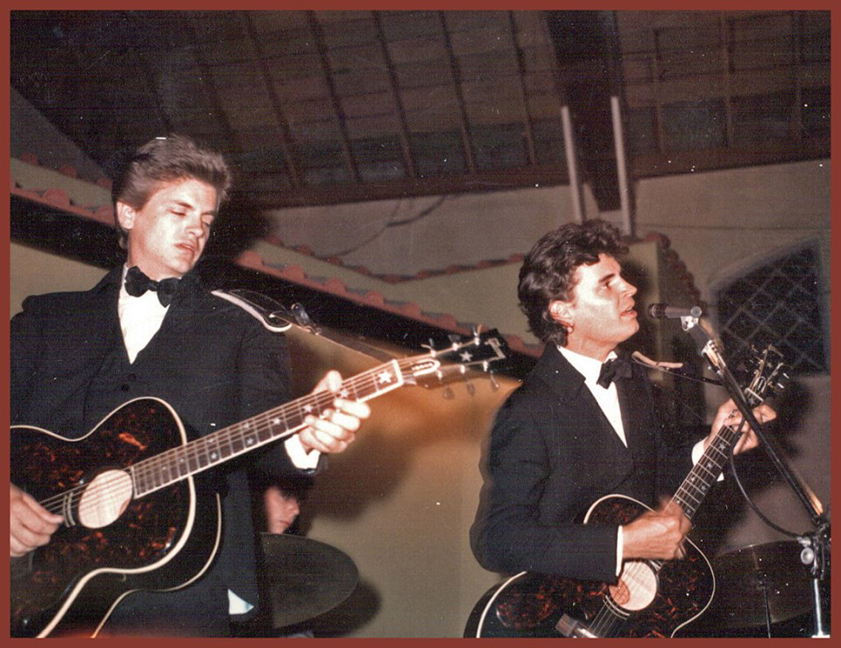
An article in the Star (September 14, 1963), reported that an editorial in the Minnetonka paper charged that Danceland made a “minimum contribution to the community” and was a law enforcement problem. A Rev. Dawes Akers, pastor of Parkers Lake Methodist Church in Plymouth, came to Danceland’s defense, saying that teen-agers need a place to go, and that Danceland was a well-run business with regulations for dress and behavior.
AXEL!
On September 22, 1963, there was more excitement with WCCO Kids’ Day. I wonder if I was there that day! I wasn’t a big Axel viewer (my dad worked for Channel 11 at the time, home of Casey and Roundhouse), but I LOVED all those Hanna-Barbera cartoons! Axel had a big presence at the Park; he was so popular that the Fun House was renamed Axel’s Laff House. Clellan Card, who played Axel, lived in the area.
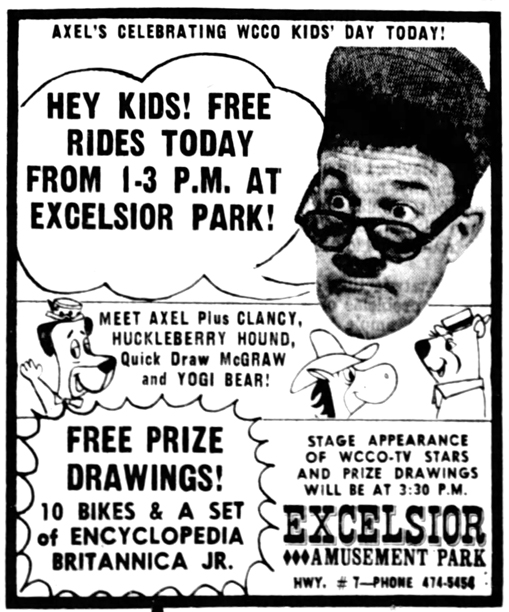
1964
NO BEATLES IN ’64
In April 1964, Big Reggie turned down an opportunity to book the Beatles into the Twin Cities for $20,000 and 60 percent of the gate. He and WDGY Disk Jockey Bill Diehl had gone to the Fab Four’s concert in Chicago that year to check them out.
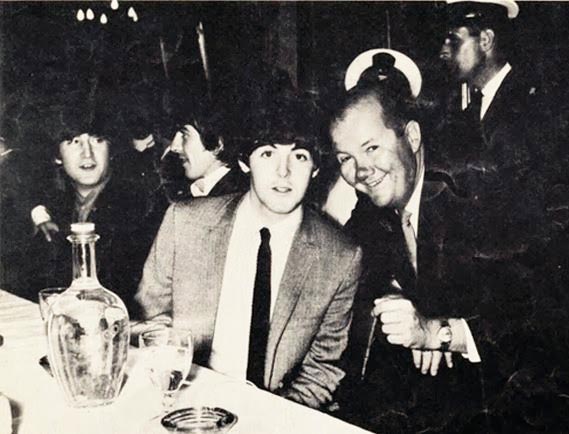
Reggie decided it was “a bit too chancy, since by August the group’s popularity may have fallen victim to the notoriously fickle tastes of young fans,” reported Don Morrison of the Star (5/28/1964). Reggie mentioned his tough decision to Diehl, who reported it to his WDGY listeners, and Reggie got a pounding. To make up for his blunder, he held a Beatle Day in the Park pavilion on June 7, 1964. Morrison:
Beatle records will be given as prizes and a group called the Female Beatles (a most pedestrian name – I would have chosen “The Beatle-Axes”) will sing in the outdoor pavilion. Also, Colihan hopes to get enough signatures for the world’s longest petition,” supplicating our Britannic friends to make their faces to shine upon us.
Note that this event was held in the Park’s picnic pavilion, not at Danceland.
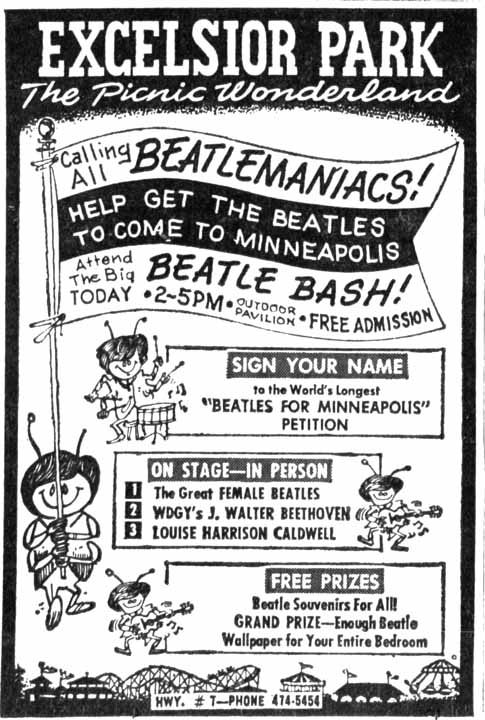
J. Walter Beethoven was a WDGY disk jockey who emceed the event. Louise Harrison Caldwell was George Harrison’s sister. Bill Diehl brought her in to make public appearances. She was not a performer. Would love to hear from the lucky soul who won the Beatle wallpaper!
Another apology was to award two pairs of tickets to see the Beatles at their September 5, 1964, show in Chicago. Hotel and complete transportation were included.
Also see The Beatles in Minnesota
May 8, 1964: WDGY High School Night/ aka School’s Out Spectacular – and spectacular it was, featuring the Trashmen!
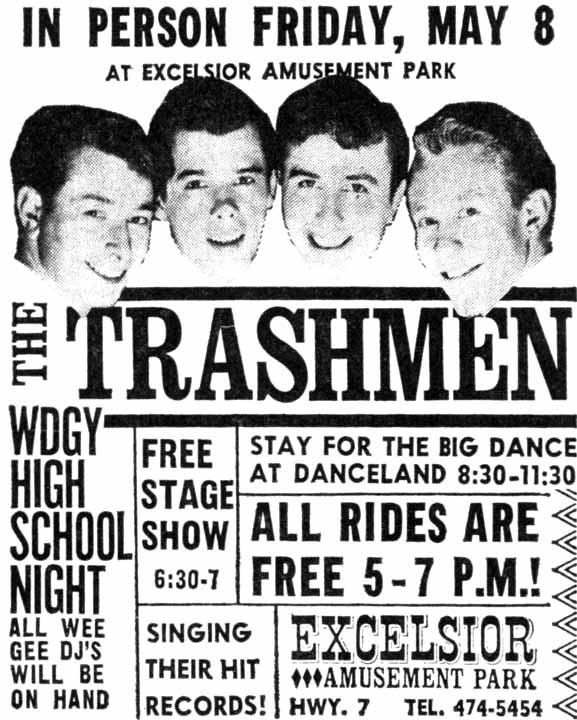
Tony Andreason of the Trashmen said, “When you went to a place like Danceland, there was electricity in the air before the band went on. Once things kicked off, bands would feed off the intensity in the room and [off of] the dancers’ requests.”
STOMPIN’ THE NIGHT (AND THE FLOOR) AWAY
Danceland was a mecca for local “stomp” bands like the Trashmen and the Underbeats. In fact, kids stomped a depression in the dance floor at one Underbeats gig, according to an interview at www.minniepaulmusic.com – the girls screamed, the inspector inspected, and the dance continued.
This is Reggie’s account of the incident, from his September 1974 interview in the Insider:
One night, the manager ran across the street to the park – we had a big night going there as well as having a couple thousand kids in the ballroom – to tell me the floor caved in. He was totally panicked. I used to tell the Underbeats not to play foot-stomping music, cuz the kids would stomp away and the floor was liable to cave in. It was an old building and there was twelve feet between the floor and the ground. So we both went tearing into Danceland and I expected to find a mess, legs and arms broken and kids laying in the basement.
Well, we walked through the crowd to the center of the floor and I didn’t know what to expect. “Where is it?” I asked. We got to the middle of the floor and an are of about thirty feet had dropped four inches. A piling had sunk. The kids were just standing ’round. That’s all there was. A big piling had settled. The cops cleared the kids out while I was in the basement. They had two thousand kids out on the street. I came up from the basement and said “where the hell are the kids?” Not one kid yelled rip-off or wanted their money back. I told the cops to let them back in or we’ll have a riot on our hands. The cops said “well how do we know who paid?” I said “It doesn’t matter. Just let them in.” The band started playing and that was the end of it.
The next day I had to take parents through the place to show them it was safe and that nothing serious happened. Hell, the kids went home and told their parents they danced so hard they caved in the floor. The parents would say “I don’t believe ya,” so I had to give tours the next day to the parents. The kids all remembered it. The night the floor caved in.
Semi-related anecdote: the building had a basement of sorts with a dirt floor. Change from boys’ pockets would come flying out while they were dancing and drop through the floorboards, and after hours certain parties would play poker down there.
THE ROLLING STONES AT DANCELAND
On June 12, 1964, Danceland scored a coup by booking the Rolling Stones, but that didn’t turn out quite so well – see that story HERE.
NATIONAL ACTS
Other than the shows noted above, there were some other national performers who came to Danceland. A search of the Minnetonka Record and the Strib archives yields no ads for these shows, so I can’t give any dates.
Personally verified shows include:
Roy Orbison: Steve Brown can verify that he saw Roy Orbison, probably in 1961 or 1962. Steve and his buddy didn’t dance, but stood at the front to watch the performers. He remembers that he was so impressed that a man with such a small mouth could create such a powerful sound!
Link Wray: Again, Steve remembers seeing this show in the ’61 – ’62 timeframe. Wray’s big hit was a guitar instrumental called “Rumble.”
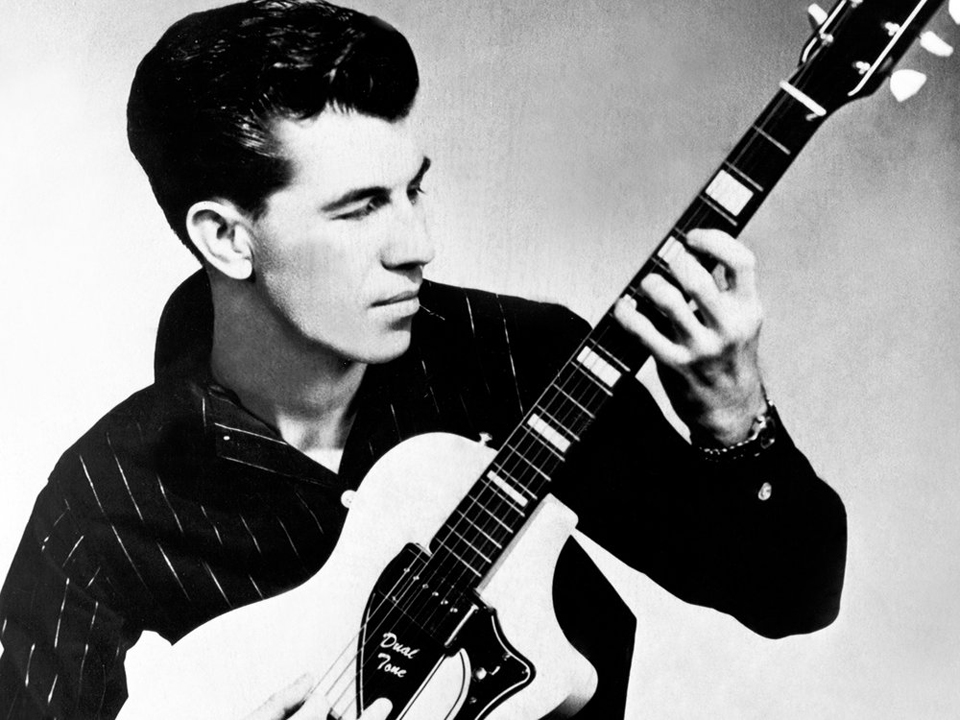
Jerry Lee Lewis: No ads have been found, but several people remember seeing JLL at Danceland – perhaps several times. Trips to the Twin Cities during the 1961 – 1967 Danceland timeframe that we can document are:
April 9, 1962: The Loon (Club soon became Mr. Lucky’s), Minneapolis
January 23, 1963: Prom Ballroom, St. Paul
June 22-28, 1966: Whisky Go Go, St. Paul
Please contact me if you remember any other national acts that graced the bandstand of Danceland!
WHAT WAS DANCELAND LIKE?
Daniel Gabriel provides some details about the fabled dance hall:
Danceland’s door was a thick grey metal affair, soundproofed from the street. Once inside, $1.50 bought a small green ticket and the right to edge past the fat man at the counter into the echoing confines of the hall itself.
The moment of entry was always electric. One felt a surge of energy from the sweating crowd. The wooden floor rumbled ominously beneath the syncopated tread of dancing feet. From the stage at the back of the room, a wave of sound washed over the bobbing heads and crashed against the opposite wall. The outside world was forgotten in an instant.
Fixtures were minimal. A small concession stand near the entrance sold popcorn and candy bars. A row of shabby wooden booths ran along a side wall, serving as illicit drinking cubicles and retirement sites for overheated couples.
We rarely availed ourselves of either. On nights when one of our favorite groups was playing, we’d just stand in front of the stage and watch the band work out. One of the unwritten rules of Twin City teen life in the ’60s was not to applaud the band at a dance. Even the wildest of rave-ups was normally met with an eerie silence. A band gauged its success by the pace of the dancing and the number of silent, staring faces clustered at its feet.
1965
The Park was affected by 1965’s record snowfall, which led to floods. The county drainage system backed up, and about a quarter of the Park was covered by water, just a couple of weeks before the Park was due to open.
On May 22, 1965, there was a “fracas” in Danceland’s parking lot that resulted in the arrest of an 18-year-old. The incident started when a car with three youths entered the parking lot, and deputy sheriff James Parks stopped it. Parks said that they smelled of liquor, although none was found in the car. When he questioned them, they suddenly “clustered around” him in a threatening way. He walked them to the office so he could call their parents, but they ran away. While chasing one of them, Parks tripped, fell, and broke his arm. Somehow one of them was caught and charged with illegal consumption of alcohol by a minor, unlawful escape from custody, and threatening an officer. He was found innocent on a technicality – the judge said that the verdict “didn’t indicate any approval of the boys’ behavior.”
On May 24, 1965, the Excelsior Village Council voted to raise Danceland’s license fee from $150 to $350. The rationale was that the police had been called 24 separate times last year, and the cost of police hours to respond and investigate was about $360. Colihan did not object to the fee raise, but felt he was not getting enough protection for the fee. Danceland employed 11 deputy sheriffs, and Colihan questioned whether extra police were necessary as the Village said they were.
Don’t know if you’ll be able to read this, but here’s a testimonial by Big Reggie about the power of advertising in the Star and Tribune:

Danceland came under fire in September of 1965 in an editorial in a local paper that charged it with making a “minimum contribution to the community” and causing a law enforcement problem. The Rev. Dawes Akers, pastor of Parkers Lake Methodist Church in Plymouth came to the Dancehall’s defense, saying that teenagers need a place to go. Then there was this anecdote:
A group of girls was having a meeting the night the tornado struck last May 6. Herding the girls into the basement, [the homeowner] urged them to say a prayer. After a moment’s silence, a quavering voice said, “Dear God, don’t let anything happen to Big Reggie’s Danceland.”
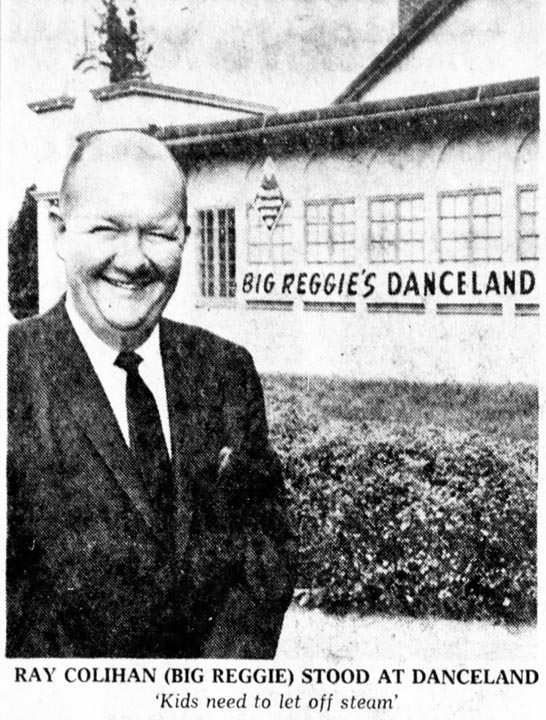
1966
THE DANCELAND GANG WAR OF 1966
In the ’60s, Danceland’s popularity led to clashes between kids who had been drinking or were in gangs. The house gang was Excelsior’s X-Boys, who defended their territory against alien gangs like the Suprees, the Baldies and the Animals. Supposedly there were 13 X-Boys, and they wore green and white letterman-like jackets (known as “primas”). Although the dance hall sold no alcohol, it flowed outside, and fights were common.
Fighting was nothing new in Excelsior. In March 1963 the Record reported that a 16-year-old was stabbed in the arm in a street fight.
The fracas apparently started when youths in one parked car on Excelssior’s main street challenged another group driving through town. In the fighting, one youth produced a hunting knife while another was reported wielding a club.
Sam Kanan, owner of the Skipper Cafe, broke up the fighting, grabbed the boys and took them into the cafe and sat them down in a booth and gave first aid to the boy who had been knifed. All this happened just as the Friday night movie let out, so there was “a crowd of about 75 youngsters on hand during the melee.”
JUMP TO 1966
Saturday night, April 16, 1966, was the first dance of the season. Colihan and his head of security had heard rumors that there would be trouble, and had put on extra help to handle it. Excelsior had eight cops in three cars, and the Hennepin County Sheriff’s office had about 20 deputies and officers in the area. About 1,200-1,400 kids were at Danceland that night.
Daniel Gabriel explains that the trouble started because the X-Boys wore approximately the same green primas as the toughest gang in town, the Suprees from Minneapolis. 25 to 30 members of the Suprees came to “take over after previous fights with Lake-area boys.”
One group of 8-10 Suprees was turned away “with a minimum of fuss.” At about 9:30 they returned to inform Excelsior Police Chief Earl Halleck that they had found one of their members in the parking lot across from Danceland, between the telephone company office and Huber Funeral Home. The boy had been beaten with a baseball bat: “The only thing that was holding his nose on his face was some outside skin,” according to Halleck. “The [Suprees] saw the blood on the ground where the boy had been and turned, yelling and shouting threats, to march in a double column toward Danceland.”
“Sheriff’s deputies formed a barrier with squad cars and riot sticks across the street about 200 yards from Danceland and prevented them from entering while deputies and Bush Detectives inside the dance hall kept the crowd inside from going out.”
A variation of the story is told by Gabriel:
When two dozen city-bred street toughs in matching primas came crashing through the door, the dance floor cleared. There were screams, heavy thumps and the leather slap of belt on flesh. The exits jammed up with the swift, the floor upended the clumsy. It was chaos. The actual details of the fight are obscured in legend. Some say a boy died in that fight. Others that he just lost a hand.
Actually, a boy ended up with a slashed neck, coming within a half inch of being killed. He said he had fallen on a beer bottle. It was unclear if he was part of the gang confrontation or not.
The next day the Excelsior Village Council held an emergency session and voted unanimously to suspend Danceland’s license for a period not to exceed 30 days for disturbances in the parking lot, in front of the building, and in other places in the village.
Also that next day, about 30 Suprees came to speak to Halleck, asking for the name of the person who had beat up their fellow member “and indicated they were ‘unhappy’ with the treatment they had received in Excelsior. Halleck told them it was none of their business and sent them on their way. … Some of the group returned on April 20 for further talks, bringing a social worker with them.”
A public hearing at the Excelsior Village Hall was held on April 28. The hearing was requested by James Moran, attorney for the Park. Moran requested that the license be reinstated, arguing “that the brawl was not the fault of Danceland and that the license suspension has caused substantial financial losses to its owner.” The hearing was continued at the Council meeting on May 2, lasting seven hours in all
The license was returned On May 6, with conditions, including:
- At least 10 policemen had to be stationed in and around the premises on dance nights.
- Dancers had to wear “suitable attire.”
- The council tried to work out a dress code, but “got mired in the details of girls’ fashions.” They decided to leave it up to the Village Manager and Colihan to work out the details. The ultimate code required boys to wear shirts with collars and to tuck them into their slacks. Boys had to wear leather shoes, not tennis shoes or sandals. Girls could wear Bermudas but nothing shorter. No bare midriffs and no “T-shirt-type fashions.”
- More lighting had to be installed in the parking lots.
- Patrons who left the hall had to pay an extra admission to go back in.
- The cigarette machine had to be removed.
- In compliance with a 1919 law, anyone under 18 had to have permission from their parents. Although Colihan said that this law was largely ignored in the dancehall business, he agreed to the condition.
- Colihan had to make a report to the Council after a dance on the number of liquor violations there were and the disposition of each.
- Danceland had to pay the cost of extra police on riot nights.
In an interesting note, the gang member who got beat up with the baseball bat sued the Village of Excelsior for $100,000 for negligence in keeping the peace! The article didn’t give the name of the kid. Another article reported that Barry Reoh, 17, of Edina was treated at General Hospital for cuts and bruises received in the fight, but he might have been the one slashed with the beer bottle.
For some reason (maybe because of the trouble with gangs), I found no ads for Danceland in the Minnetonka Record in 1966. Given the trouble that spring, perhaps Reggie tried booking more “tame” types of entertainment – for instance, this dog show!
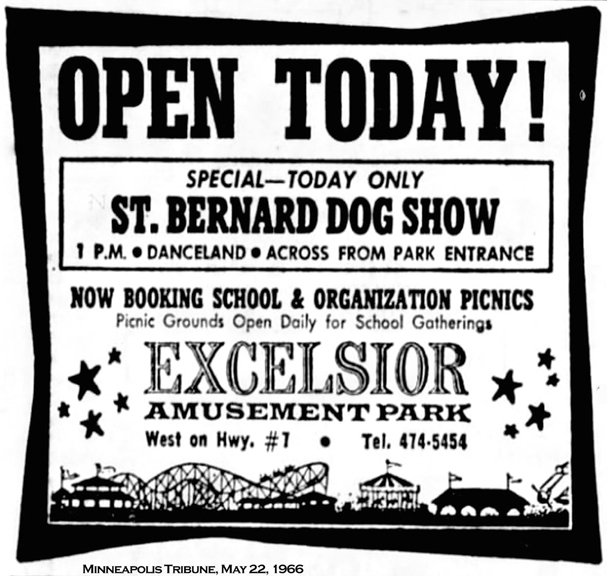
And perhaps turning away from Rock ‘n’ Roll was on the horizon (although this probably wasn’t in the Ballroom):

1967
Excelsior’s Village Council met on April 17 and issued Colihan his dancehall license for $350. Colihan was asked whether he kept a list of “troublemakers so that they could be watched in the future. Colihan replied that such a record was kept but the troublemakers will be barred after ‘one time only.’” Halleck reported that there had been no trouble after the reinstatement of the license last year. The Mayor said that he had heard that the Suprees had “dissolved.” One source said that the Suprees had all been drafted.
The first dance of the season at Danceland was on April 28, 1967. Park owner Fred Pearce made it clear that Colihan, who leased it from the Park, was wholly responsible for what went on.
Dances were planned for Fridays and Saturdays until school was out and then Tuesdays would be added.
Correspondent Rollie Anderson shares this account from July 28, 1967 – probably one of the last dances at the fabled Danceland:
This evening Jerry, Marilyn and I went over to Shari’s to pick her up to go to Excelsior Park to see the Hot Half Dozen [The band advertised as the Hot Half Dozen but officially, their name was simply the Half Dozen.] Jerry knows a guy in that group who lived in Holdingford and graduated with his sister, Janet – Daryl Litchy. When we four got to Danceland, I paid $6.00 for all of us because I didn’t want to make Jerry think that he had to pay for my sister, Marilyn. It was sort of an embarrassment when inside because there were so few there and no one was dancing. But during the night, things picked up a lot. As I figured, the Hot Half Dozen played “Heat Wave” just as good as ever. I always liked their recording of that song and little did I know when I heard it on the radio last year that the lead singer was from Holdingford. Jerry talked to him during one of their breaks and he remembered Jerry’s name, but didn’t have much to say. [According to Soma records, James Walsh was the lead singer, at least on the recording of “Heatwave.”]
Danceland closed on August 29, 1967, for the season.
1968
DANCELAND CLOSES
By 1968 Big Reggie no longer had the lease for the property. Fred Pearce, the owner of the building, had leased it to Robert Mecay and Thomas Costaneda in early 1968, but when they applied for a set-up license to operate an adult operation with liquor they were flatly refused by the Village Council. They wanted to come back with a request to run a teen club (Mecay had five years’ experience), but on May 13, 1968, owner Fred Pearce announced that he was losing money on the dance hall and had decided to rent it out as a storage building for boats and snowmobiles.
1973
DANCELAND BURNING
Danceland burned to the ground in a fire that started at 2 am on July 8, 1973. The Excelsior and Minnetonka Fire Departments responded, with the Mound FD manning the Excelsior station. Chief Labahn Morse said the building was “totally involved” in flames when they arrived and with a building that size, no amount of water could have had much effect on the fire. Water was pumped from Lake Minnetonka, but the fire hoses kept filling up with algae and had to be constantly cleared out. The overpass over Highway 7 to Excelsior had to be closed because of sparks and heat. Flames could be seen for miles.
The fire smoldered for two days and damage (including 38 boats and 47 snowmobiles) came to $136,200 One firefighter was injured fighting the blaze when debris fell on him and he was rushed to Methodist Hospital. Ironically, the building was scheduled to be razed that fall and possibly used as a controlled burning exercise for the Excelsior Volunteer Fire Department.
ARSON SUSPECTED
Chief Morse reported that the fire appeared to have been started at 8 to 10 different spots and that gasoline was used, leading to a swift, all-encompassing blaze.
An account of the fire was written by Julia Plant in her book about her brother, Mike Plant, entitled Coyote Lost at Sea. According to Julia, they came from a wealthy family, but probably due to a traumatic brain injury caused by concussions, Mike had become “an angry adolescent who kicked cops in the head, smuggled and sold drugs, and did everything possible to show everyone he was nothing like his polite, soft-spoken, intelligent father.” She found out after the fact that it was Mike who suggested to his old friend, Jeffrey Malloy Williams, that they burn down Danceland. The community figured it was slated for demolition anyway, and a bunch of drunk kids figured they’d accelerate the process.
Julia:
That evening word spread quickly that something was going to happen at Danceland around midnight. At least thirty kids showed up. … We all turned and ran off like a pack of dogs, stopping a couple of blocks away to hide on the hill in the park and watch the huge wooden building burst into flames. But it didn’t just burst into flames – it exploded into a visual splendor of bright orange against the black night sky. It was an incredible sight. Only later did we find out there were at least one hundred snowmobiles stored inside with gas in their tanks.
Jeff went to a local gas station to fill a one-gallon container of gas. At the hall’s entrance, Jeff poured the gas “and Mike lit the match.” As it turned out, a couple of out-of-town girls staying in an apartment nearby had seen Jeff, “wasted and boisterous, wearing a red bandana around his head.” Against Mike’s advice, Jeff didn’t remove the bandana in the police lineup and was easily identified. Another witness had seen Jeff at the gas station.
The insurance company was not going to pay for the damage unless someone was found culpable for the arson, and the law came down on Jeff, then 23 years old.
The complaint filed against Williams alleges that, “aided and abetted” by other persons, he set fire to Danceland. It alleges further that there was a gathering of “kids” prior to the fire, that Williams was observed near the building with an empty gasoline can in his hand, and that he said the building was going to be burned down.
Jeff spent three years in prison – Jeff never implicated Mike, and Mike never admitted his role.
Did Mike Plant light the match? Alas, Mike was lost at sea on his sailboat Coyote.
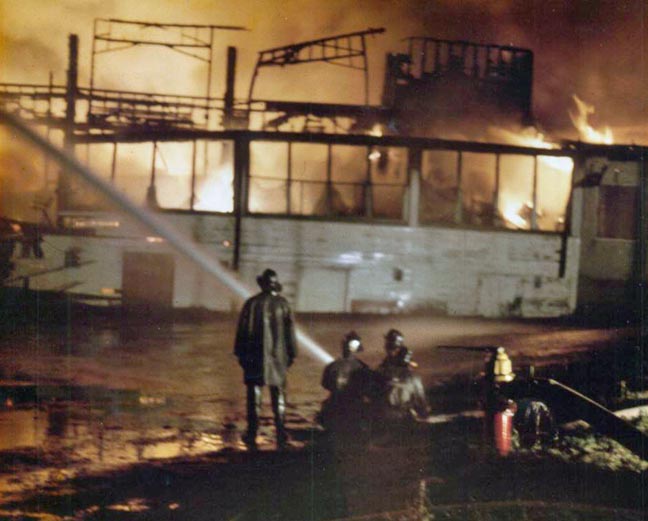
Photos above and below from the Excelsior Fire District Facebook Page
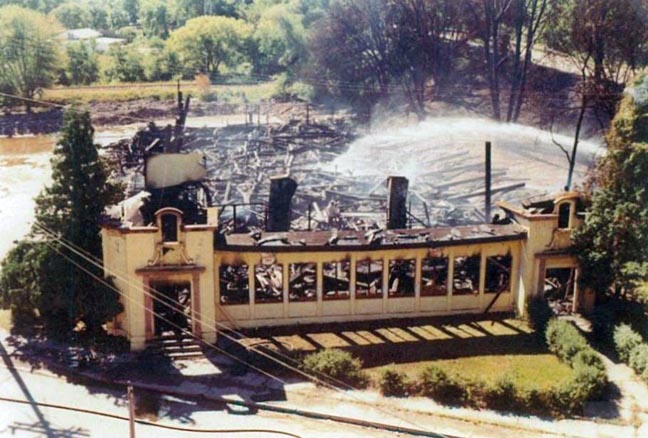
VALLEYFAIR
Excelsior Park, still in the Pearce family, closed on September 16, 1973, with little fanfare. With the advent of amusement parks like Six Flags, it was determined that the relatively small Excelsior Park had to expand, but there was no more room. Although the Park was still profitable, it was aging and becoming old fashioned. A new site on 235 acres on the Minnesota River in Shakopee was found and dubbed Valleyfair. The Pearce family were co-owners of the new amusement park.
Demolition of Excelsior Park started in May 1974, and an auction was held on July 24, 1974. The roller coaster was demolished, and the carousel building was given away and later demolished. The carousel horses were moved to Valleyfair.
The Danceland site (685 Excelsior Blvd.) is now occupied by an office building and parking lot.
There is much more on Danceland on Lake Minnetonka.Com
MISS MINNESOTA/AMERICA
For several years, in his role as Park promotions director, Rudy Shogran produced the Miss Minnesota pageant. This special event usually took place at the picnic pavilion, but there is some evidence that the contest was located in the Ballroom at least one year. The pavilion had a roof but no walls, so maybe it was too cold for those poor girls in swimsuits.
1938
In August 1938, Cedric Adams was the judge of the Miss Minnetonka pageant at the Park. The winner went on to the Miss Minnesota contest at Lynwood Park in Lynd, Minnesota. The winner of that contest, Avis Darrow of Duluth, went on to the Miss America contest in Atlantic City. Other judges were the Mayors of Excelsior, Mound, Island Park, and Wayzata.
1941
The Park hosted the Miss Minnesota contest on August 17, 1941. The bathing suit elimination contest was held at 4 pm, and the contestants demonstrated their talents while in evening gowns at 8 pm. Glad Olinger and his band provided the music. Patricia Tiets competed as Miss Minnesota at the Miss America Pageant.
1942
The Park hosted the Miss Minnesota contest on August 10, 1942. Jane Groerner of Minneapolis competed as Miss Minnesota at the Miss America Pageant.
1943
In 1943 the Park was officially granted the official franchise for the Miss Minnesota contest. (Billboard, July 10, 1943) On August 22, 1943, Florence Hunton from Minneapolis won the contest.
1944
On August 13, 1944, Patricia Cummings won the Miss Minnesota contest and placed in the Top 12 in the Miss America contest.
1945
On August 12, 1945, 75 women competed for the title of Miss Minnesota. Winner Arlene Anderson, competing as Miss Minneapolis, placed as fourth runner-up at the Miss America pageant.
1946
On August 11, 1946, Miss St. Paul Rosemarie Gregg won the Miss Minnesota contest. There were 47 entrants that year.
Below is not the winning Miss Gregg, but Miss Dorothy Mallory of Hopkins, another 1946 candidate of note.
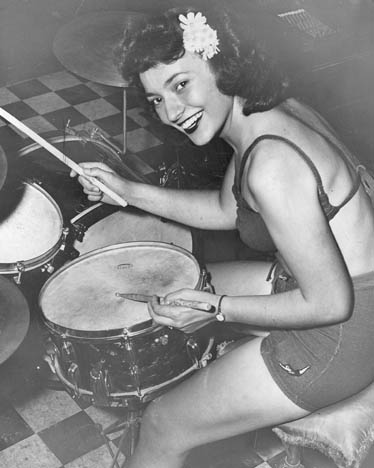
1947
Elaine Campbell, competing as Miss Minneapolis, was named Miss Minnesota on August 17, 1947, out of a field of 22 candidates. Miss Campbell was a 1942 graduate of St. Louis Park Park High School and had attended the U of M for two years. At the Miss America contest she sang opera despite a throat infection. She was first runner-up and went away with a $3,000 scholarship and a $450 wardrobe.
1948
BeBe SHOPP
Beatrice Bella Shopp, better known as BeBe Shopp, became Miss Minnesota at the Park on August 22, 1948, competing as Miss Hopkins. She had competed the year before, just for the experience, since she was ineligible at age 17. Once she won Miss Minnesota, she was groomed by Rudy Shogran:
She told of the endless hours of training which Shogran furnished after she became Miss Minnesota to help her win the top title. There were speech classes, modeling hints, make-up lessons, and constant practice on the vibraharp which were necessary to take her to victory. (Billboard, October 9, 1948)
BeBe went on to become Miss America in September. On September 15, 1948, the Park was opened for a parade for BeBe, who played her winning vibraharp selections for the crowd, estimated at 5,000. Jean Sheils, Miss Edina, took BeBe’s place as Miss Minnesota.
On July 2, 1949, the Park held a special event for BeBe as she started her tour of Europe. (Billboard, June 25, 1949)
1949
The 1949 Miss Minnesota contest was scheduled for August 21. Gloria Burkhart, competing as Miss Minneapolis, became Miss Minnesota at the Park’s competition. She placed in the Top 15 at the Miss America pageant. This was the first time the Miss Minnesota contest was televised, on pioneering TV station KSTP.
1950
The tenth annual Miss Minnesota contest was held at the Park on August 13, 1950. Cedric Adams of WCCO was the emcee of the bathing suit competition, and Jack Thayer of WLOL was the emcee of the evening gown and talent competitions. Music was provided by Bud Strawn’s Orchestra, the Park’s house band. Jeanne Traun, competing as Miss Minneapolis, was crowned Miss Minnesota. Excitement ensued when a skunk infiltrated the pavilion during preliminaries on August 10.
1951
SMORGY ENTERS LULU
In 1951 the Tribune had its own home-grown comic strip called “Smorgy,” drawn by Kurt Carlson and featuring a large-nosed Scandinavian fellow with a girlfriend named Lulu Fisk. Smorgy decided to sponsor Lulu as a contestant in the Miss Minnesota contest.





Despite the machinations of Smorgy, on August 12, 1951, Katherine Clark, competing as Miss Minneapolis, won the title of Miss Minnesota.
1952
Smorgy once again tried to horn in on the Miss Minnesota contest:



On August 10, 1952, Excelsior Park hosted the 12th annual Miss Minnesota Pageant. Cedric Adams of WCCO radio was the emcee of the bathing suit competition, and Jack Thayer of WLOL emceed the evening gown and talent competitions. Music was provided by Les Williams and His Orchestra. A highlight of this year’s contest was the participation of fraternal twins Eileen and Irene Wencl. They were both 18-year-old sophomores at the University of Minnesota. They were from Owatonna, but unclear what their individual titles were. Carole Wick, competing as Miss Duluth, was crowned Miss Minnesota.
1953
On August 9, 1953, Idell Hulin was the winner of the Miss Minnesota contest, over 23 other contestants. The was the 13th Miss Minnesota to compete in the Miss America pageant.
1954
MISS MINNESOTA/USA
1954 was the year that the Park lost the franchise for the Miss Minnesota/America franchise. Cedric Adams explained that the State Jaycees took over the event and wanted more competitive contestants, preferably college girls. The 1954 contest went to Austin, Minnesota. The Park had to do with an appearance by Hopalong Cassidy.
1956
July 1, 1956, saw the return of the Miss Minnesota contest, but with a twist – this Miss Minnesota would go on to the Miss USA contest, and the winner of that pageant would go on to vie for Miss Universe. The Miss Universe pageant was founded in 1952 by Pacific Knitting Mills, manufacturer of the mandatory Catalina Swimwear. The company had sponsored the Miss America pageant until 1951, when the winner refused to pose for publicity pictures wearing one of their swimsuits. In 1956, 18 judges unanimously chose Marilyn Johnson on the first ballot as their Miss Minnesota. She went on to the Miss USA pageant in Long Beach on July 12.
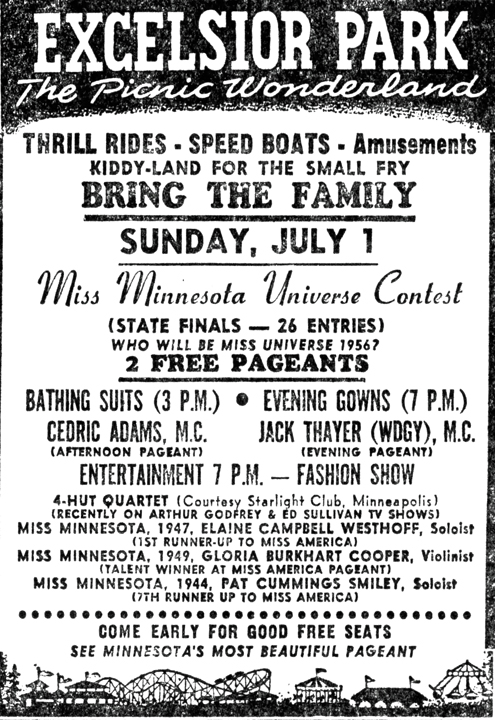
1957
Upon the death of Rudy Shogran on April 8, 1957, Ray Colihan was named his successor as the Park’s public relations director. One of his new duties was to produce the Miss Minnesota-Universe Pageant, which took place on June 16, 1957. Jack Thayer of WDGY was the emcee and music was provided by singer Gloria Greer, the Joe Kimble Trio, and the Showoffs. Mary M. Ford won the honors out of a field of 21 contestants, going on to Long Beach on July 11.
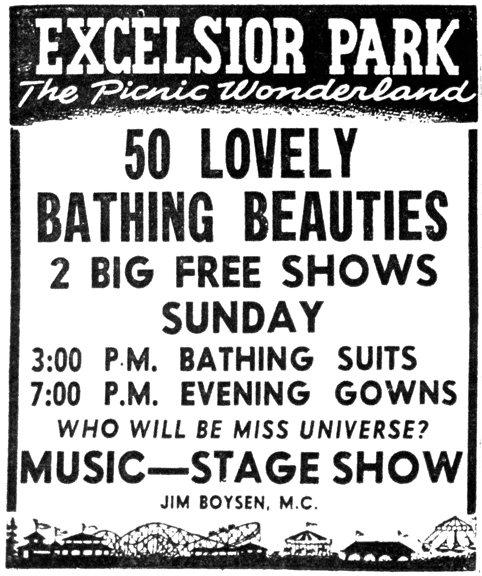
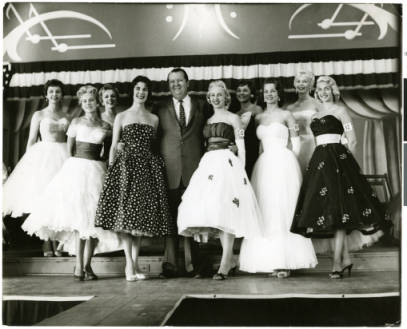
1958
In 1958 the contestants from Minneapolis and St. Paul competed on June 8. The top eight winners then competed with 20 contestants from outstate Minnesota on June 15. The winner, Miss Minnesota USA, was Sue Bouchard from Minneapolis. The Park paid for Sue’s wardrobe, expenses, and transportation to the Miss USA pageant on July 23 in Long Beach. Unfortunately Sue did not make the top 15.
1959
The 1959 Twin Cities preliminaries of the Miss Minnesota-USA contest were held at the Park on June 14, with the finals on June 21. Muriel Fairbanks was the winner.
1960
The Park did not host a beauty contest in 1960 and presumably anytime afterwards. Instead, celebrities were brought in as a special event for Cerebral Palsy Benefit Days:
- Boxer Jack Dempsey came to sign autographs on August 11,
- Marvin Miller, star of the TV show “The Millionaire,” came to give away million dollar checks on August 12, and
- Lt. Rip Masters, star of the Rin Tin Tin TV series did two performances on April 13. Doesn’t actually say whether he brought the dog with him.
JOE COLIHAN
Joe was born on September 6, 1896, in Danbury, Connecticut. Following in the footsteps of his father John, Joe spent his life in the amusement industry, operating rides at fairs, carnival, and amusement parks. Some of these jobs included:
- Ride man with the Johnny J. Jones Exposition in 1902
- Traver Engineering Co. (five years)
- Joe and Al McKee in Palisades Park, New Jersey
- Cuba and Puerto Rico with Benny Krause’s carnival
- South America with Joe Goldberg’s carnival
- From 1925 to 1930 he worked for Fred Pearce, managing the roller coaster at Pleasure Beach Park in Bridgeport, Connecticut.
In Bridgeport he met Marion “Boo” Kerrigan, and they were married on April 26, 1926.
Raymond Joseph “Big Reggie” Colihan was born on July 24, 1928, in Bridgeport.
In 1930 Joe was tapped by Pearce to come to Excelsior Park to be the assistant manager and rides supervisor.
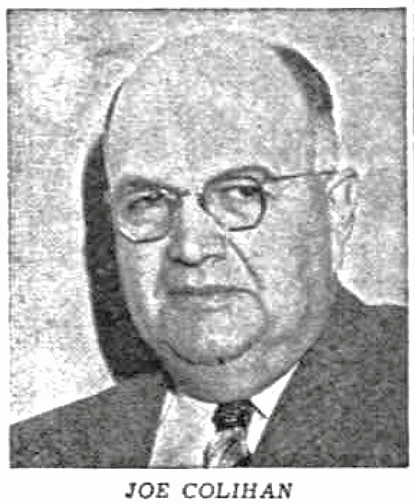
To house his new assistant manager and Bill Clapp, Pearce purchased the Wyer-Pearce House, an 1887 Victorian affair, in 1930 from the streetcar company. The house (now on the National Register of Historic Places) was located on the Park grounds.
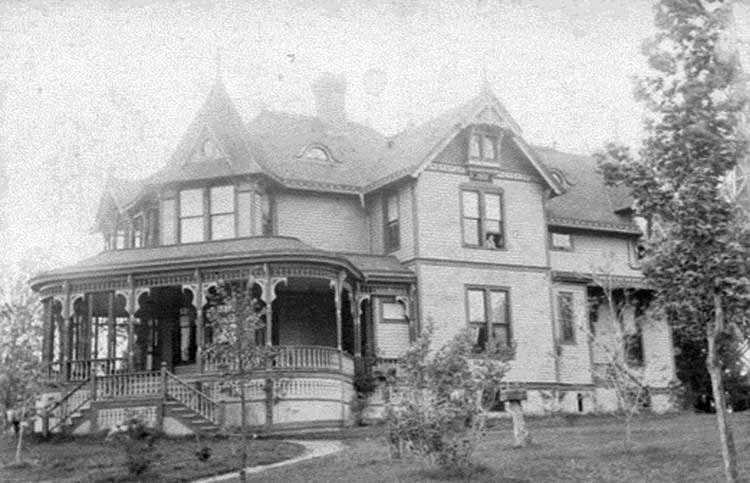
Joe died on October 12, 1961, at age 65.
RAY COLIHAN – “BIG REGGIE”
Living on the grounds allowed young Ray to be around the Park as far back as he could remember. His first official job was sweeping the ballroom floor at age 12. Connie Hechter reported that Ray’s first job was running the hat check concession at the ballroom. Once he admitted to sneaking on stage to play Gene Krupa’s drums when nobody was around. As he entered high school, he ran the Ferris wheel and did other jobs.
Ray served in the Army in Japan from 1950 to 1953. His friend Al Anderson says that part of the time he was assigned as a clerk in the Army stockade in Tokyo. When he returned he became the manager of the 7-Hi Drive-in Theater in Hopkins (Record, August 19, 1965), and the manager of an indoor theater in St. Paul. Upon the death of Rudy Shogran on April 8, 1957, Ray was named his successor as the Park’s public relations director and booker of the ballroom.
Note: In a couple of articles, Ray’s birth name is given as “Omri Cole Hann.” In an email dated October 3, 2022, Ray’s son Joe wrote that this is a mistake, and that his father was 100 Percent Irish.
BIG REGGIE’S DANCELAND
The dates are vague here, but my best guess is that in late 1960, Ray re-opened the ballroom, with teen-age dances on Tuesday nights. Friday nights were for “old-time music” and Saturday nights were Dixieland.
In August I lost $4,000; the only time I made any money was Tuesday nights. I made a hundred dollars on Tuesdays with the kids. So I got smart in August and I went every night with teen-age, and I wound up the year not losing anything. The last dance I had that year was Conway Twitty and I put 1,800 kids in there at a buck a head. No one had seen that kind of action since Lawrence Welk played the ballroom. The old man couldn’t believe it. The next year [1961] I got smarter and booked Mike Waggoner and the Bops and I kept it open until ’67.
When his father died on October 19, 1961, Ray took over his job as manager of the Park, and also leased the dormant ballroom as a sideline. He dubbed the ballroom “Big Reggie’s Danceland” – his nickname Big Reggie was named for Jackie Gleason’s Reginald Van Gleason character.
The Underbeats remembered that Big Reggie always wanted to sing “Cottonfields” with them on stage at the beginning of the night– he even made a record of the song, backed with “Tutti Frutti.” The record goes for big bucks today!
On the topic of music, Reggie’s son Joe says:
He was a rocker. He was most into Jerry Lee Lewis, Ray Charles, etc. He even loved that Meatloaf song about being together forever “will ya love me forever” and the Joe Walsh song about “everybody’s so different, I haven’t changed.” He loved all that stuff much more than anything else.
In 1964, the Star’s Bob Murphy noted that Reggie could be spotted at the Kashmiri Lounge at the Ambassador Motor Inn in St. Louis Park, “bending his arm to do a duet or two with Ruth Sneen, the pianist there. The two achieve a remarkable blend of voices. I didn’t even know he sang.”
Big Reggie promoted other shows, notably the Beatles’ appearance at Met Stadium in 1965.
He also brought the hugely popular Dave Clark Five to the Minneapolis Armory on November 17, 1964. On December 12, 1964, Billboard Magazine reported that the group grossed $10,000 but Big Reggie lost $4,000; he had paid $25,000 for two shows, one in Des Moines. Gregory Dee and the Avanties were remembered as the opening act.
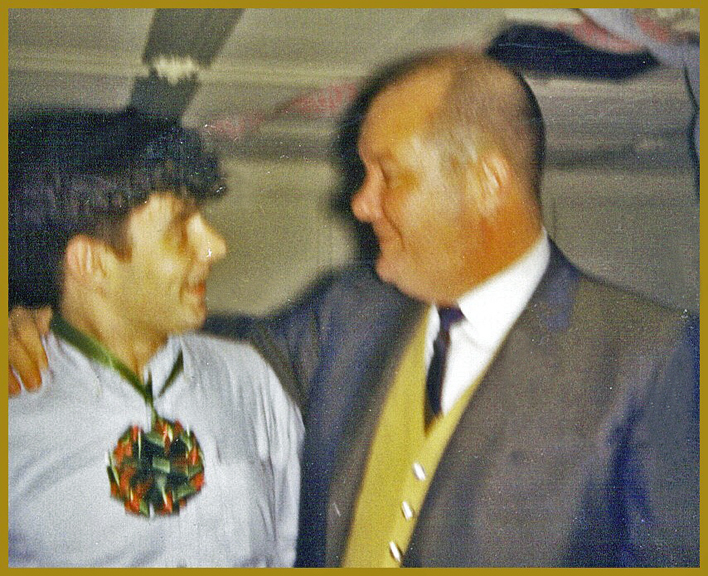
REGGIE AFTER DANCELAND
After the Park closed, Big Reggie worked as a broker, bringing buyers and sellers of bars together. These are some that he was personally involved with:
In 1970 Reggie partnered with twins Billy and Jimmy Robertson of the Minnesota Twins and built the Twins Stagecoach Inn, a bar/restaurant next to the Stagecoach museum in Shakopee. This venue was renamed the 1 and 44 just two years later, so apparently it was not a success.
REGGIE’S BAR
In 1973 Reggie bought and operated Reggie’s Bar in downtown St. Cloud. Starting in about mid April, the bar presented a noontime lingerie show that attracted full houses. In June,
local priests and members of the local Knights of Columbus appealed to the City Council to put a stop to the shows. On Sunday, notices appeared in bulletins issued by every Catholic church in the area, stating that a “filthy sex show” was being presented at a local bar and urged parish members to voice their disapproval to St. Cloud Mayor Al Loehr and the Council. (Minneapolis Tribune, June 20, 1973)
Although Reggie couldn’t have bought better publicity, the threat of action by the City Council to prohibit such shows led him to put an end to the shows.
Reggie’s Bar was destroyed by fire on February 24, 1974, causing $140,000 in damages. Assistant State Fire Marshall Richard Polipnick accused Reggie of starting the fire, and bound him over to the Stearns District Court on charges of arson and insurance fraud. He was freed on his own recognizance after a preliminary hearing. Reggie was granted a change in venue and pleaded innocent to the charges. He was tried by a jury in Little Falls, Morrison County and found not guilty on May 8, 1975.
Reggie was manager of La Cantina, located at 7800 Computer Ave. in Bloomington. La Cantina was built by Pat Moore. Reggie resigned in October 1974 amid a fight with the Bloomington City Council over the percentage of food to liquor sold at the restaurant and nightclub.
Here’s a special event Reggie organized at La Cantina for his former teenagers:
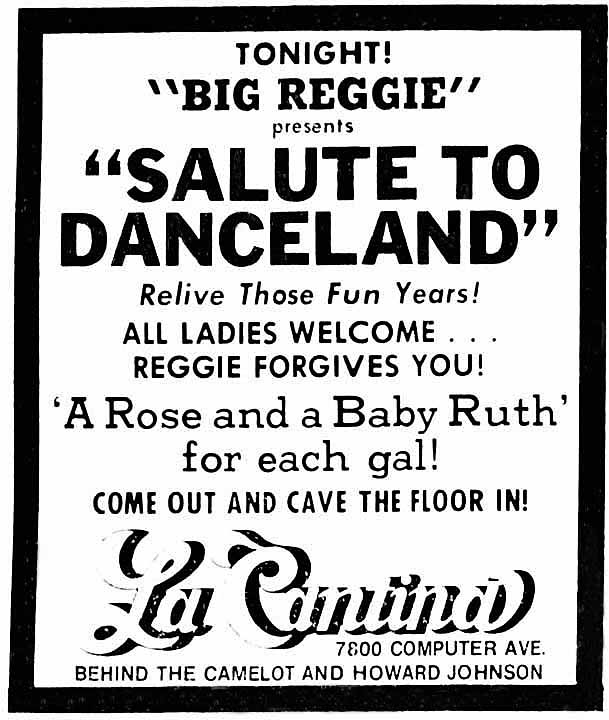
SKYWAY BAR
In the late 1970s, Reggie owned and managed the Skyway Bar (by 1986 known as Reggie’s Downtown) at 8th and Hennepin.
Reggie purchased the Uptown Bar at Lake and Hennepin in 1984, with partner Jim Loosen. During his two year tenure, the bar became a mecca for punk/alternative local bands,
GOODBYE TO BIG REGGIE
Raymond “Big Reggie” Colihan died on November 18, 1986, at his Edina home from cancer at the age of 58. He was survived by his wife, Beverly Ann; daughter, Cathleen Ann (David Rand); son, Joseph Patrick Colihan; and mother, Marion.
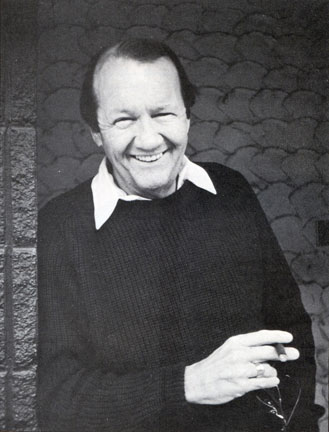
SOURCES
MINNEAPOLIS STAR AND TRIBUNE
Will Jones item: May 23, 1961
School Night at Excelsior: May 13, 1961
Will Jones: June 26, 1961
20 Dance Halls Lose Bottle Club Licenses: August 25, 1961
Suburban Neighbors column by Ralph Thornton: September 14, 1963
Don Morrison’s 2 Cents’ Worth; Beatles Want Bigger Bite From Promoter: May 28, 1964
Court Clears Youth of 3 Charges: June 26, 1965
Dance Hall’s License Suspended: April 22, 1966
Excelsior Sets Hearing on License Suspension: April 26, 1966
Hearing Held Wednesday on Danceland: April 28, 1966
Excelsior Plans to Review Suspension: April 30, 1966
Excelsior Lifts Ban on Dancehall: May 5, 1966
Danceland to Reopen – With Curbs: May 6, 1966
Fire destroys hall where Welk, Stones once played, by Jack Coffman: July 9, 1973
Long Lake Man Charged in Hall Fire: July 10, 1973
Area gives Beach Boys good vibrations by Michael Anthony: August 5, 1976
MINNEAPOLIS DAILY HERALD – All dates 1962
Ads: May 10 and 30, July 2, September 9
Holiday Fireworks at Amusement Park: May 24
Fireworks at Park Set For July 3-4
MINNETONKA HERALD
Excelsior Suspends Danceland License: April 21, 1966
Danceland License Returned: May 5, 1966
Park Now Open on Weekends Only: September 7, 1967
Summer’s Over – Amusement Park is Closing: September 14, 1967
MINNETONKA RECORD
Excelsior Park To Open Sunday in Pre-Season Series: April 1963
Excelsior Park Hosts Hi School Night Friday: May 1963
Excelsior, Park Officials Discuss Petition Complaint: May 30, 1963
Excelsior Park To Open On Weekend: April 23, 1964
Sky-Divers And Fireworks At Excelsior Park: July 2, 1964
Amusement Park Observes Fortieth Anniversary In ’65: May 27, 1965
Danceland Policing Discussed: May 27, 1965
Excelsior Charged with negligence in $100,000 Claim: May 26, 1966
Danceland to Open Next Friday Night: April 20, 1967
Danceland Licenses Requested: April 21, 1968
MINNETONKA SUN
Danceland on Excelsior Agenda Monday: May 9, 1968
Danceland Will Close: May 16, 1968
EXCELSIOR-DEEPHAVEN SUN: All July 12, 1973
- Danceland turns to smoking hull
- Long Lake man arrested in fire investigation
- Sweet nostalgia destroyed in a few, scorching hours
Sweet Potato: Daniel Gabriel, July 22, 1981
Insider: “Big Reggie: The World’s Oldest Teenager!” by Connie Hechter, September 1974


